
List of birds of Panama
Encyclopedia
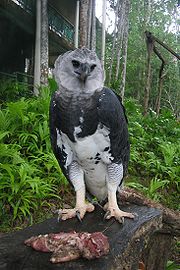
Panama
Panama , officially the Republic of Panama , is the southernmost country of Central America. Situated on the isthmus connecting North and South America, it is bordered by Costa Rica to the northwest, Colombia to the southeast, the Caribbean Sea to the north and the Pacific Ocean to the south. The...
includes a total of 972 species, of which 12 are endemic
Endemism in birds
An endemic bird area is a region of the world that contains two or more restricted-range species, while a "secondary area" contains one or more restricted-range species. Both terms were devised by Birdlife International....
, 6 have been introduced
Introduced species
An introduced species — or neozoon, alien, exotic, non-indigenous, or non-native species, or simply an introduction, is a species living outside its indigenous or native distributional range, and has arrived in an ecosystem or plant community by human activity, either deliberate or accidental...
by humans, and 120 are rare or accidental. 20 species are globally threatened. The total figure includes a number of species whose occurrence in the country is considered hypothetical: no specimen or photograph has been taken in the country and they are known only from sight records.
This list's taxonomic
Taxonomy
Taxonomy is the science of identifying and naming species, and arranging them into a classification. The field of taxonomy, sometimes referred to as "biological taxonomy", revolves around the description and use of taxonomic units, known as taxa...
treatment (designation and sequence of orders, families, and species) and nomenclature (common and scientific names) mainly follows the conventions of Clements
James Clements
Dr. James Franklin Clements was an ornithologist, author and very successful businessman. He was born in New York....
's 5th edition although a few species have been split or lumped to correspond with the Panama Audubon Society checklist. The family accounts at the beginning of each heading reflects this taxonomy, as do the species counts found in each family account. Introduced and accidental species are included in the total counts for Panama.
The following tags have been used to highlight certain relevant categories, but not all species fall into one of these categories. Those that do not are commonly occurring, native species.
- (A) Accidental A species that rarely or accidentally occurs in Panama.
- (E) Endemic A species endemic to Panama.
- (I) Introduced A species introduced to Panama as a consequence, direct or indirect, of human actions.
| Table of contents |
|---|
Non-passerines: Tinamous . Penguins . Grebes . Albatrosses . Shearwaters and petrels . Storm-Petrels . Tropicbirds . Pelicans . Boobies . Cormorants . Darters . Frigatebirds . Bitterns, herons and egrets . Storks . Ibises and spoonbills . Ducks . New World vultures . Osprey . Hawks, kites and eagles . Caracaras and falcons . Guans, chachalacas and allies . New World quails . Limpkins . Rails, crakes, gallinules, and coots . Sungrebe . Sunbittern . Jacanas . Oystercatchers . Avocets and stilts . Plovers and lapwings . Sandpipers and allies . Skuas and jaegers . Gulls . Terns . Skimmers . Pigeons and doves . Parrots, macaws and allies . Cuckoos and anis . Barn owls . Typical owls . Oilbird . Potoos . Nightjars . Swifts . Hummingbirds . Trogons and quetzals . Kingfishers . Motmots . Jacamars . Puffbirds . Barbets . Toucans . Woodpeckers and allies . |
Passerines: Ovenbirds . Woodcreepers . Typical antbirds . Antthrushes and antpittas . Tapaculos . Cotingas . Manakins . Tyrant flycatchers . Swallows and martins . Pipits . Silky-flycatchers . Waxwings . Dippers . Wrens . Mockingbirds and allies . Thrushes and allies . Gnatcatchers . Crows and jays . Starlings . Vireos . New World warblers . Bananaquit . Tanagers . Buntings, sparrows, seedeaters and allies . Saltators, cardinals and allies . Troupials and allies . Siskins and goldfinches . Old World sparrows . |
See also References |
Tinamous
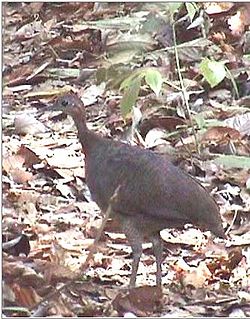
The tinamous are one of the most ancient groups of bird. Although they look similar to other ground-dwelling birds like quail and grouse, they have no close relatives and are classified as a single family Tinamidae within their own order, the Tinamiformes. They are distantly related to the ratites (order Struthioniformes), that includes the rheas
Rhea (bird)
The rheas are ratites in the genus Rhea, native to South America. There are two existing species: the Greater or American Rhea and the Lesser or Darwin's Rhea. The genus name was given in 1752 by Paul Möhring and adopted as the English common name. Möhring's reason for choosing this name, from the...
, emu
Emu
The Emu Dromaius novaehollandiae) is the largest bird native to Australia and the only extant member of the genus Dromaius. It is the second-largest extant bird in the world by height, after its ratite relative, the ostrich. There are three subspecies of Emus in Australia...
, and kiwi
Kiwi
Kiwi are flightless birds endemic to New Zealand, in the genus Apteryx and family Apterygidae.At around the size of a domestic chicken, kiwi are by far the smallest living ratites and lay the largest egg in relation to their body size of any species of bird in the world...
. There are 47 species worldwide and 4 species which occur in Panama.
- Great TinamouGreat TinamouThe Great Tinamou Tinamus major, also called Mountain hen is a species of tinamou ground bird native to Central and South America. There are several subspecies, mostly differentiated by their coloration:-Description:...
Tinamus major - Highland TinamouHighland TinamouThe Highland Tinamou or Bonaparte's Tinamou, Nothocercus bonapartei is a type of ground bird found in montane moist forest typically over altitude.-Taxonomy:...
Nothocercus bonapartei - Little TinamouLittle TinamouThe Little Tinamou, Crypturellus soui, is found in Central America and South America.-Etymology:Crypturellus is formed from three Latin or Greek words. kruptos meaning covered or hidden, oura meaning tail, and ellus meaning diminutive...
Crypturellus soui - Choco TinamouChoco TinamouThe Choco Tinamou or Chocó Tinamou, Crypturellus kerriae, is a type of Tinamou found in lowland forest and montane forest in subtropical and tropical regions of Colombia and Panama.-Description:...
Crypturellus kerriae
Penguins
Order: Sphenisciformes. Family: SpheniscidaeThe penguins are a group of aquatic, flightless birds living almost exclusively in the Southern Hemisphere. Most penguins feed on krill
Krill
Krill is the common name given to the order Euphausiacea of shrimp-like marine crustaceans. Also known as euphausiids, these small invertebrates are found in all oceans of the world...
, fish
Fish
Fish are a paraphyletic group of organisms that consist of all gill-bearing aquatic vertebrate animals that lack limbs with digits. Included in this definition are the living hagfish, lampreys, and cartilaginous and bony fish, as well as various extinct related groups...
, squid
Squid
Squid are cephalopods of the order Teuthida, which comprises around 300 species. Like all other cephalopods, squid have a distinct head, bilateral symmetry, a mantle, and arms. Squid, like cuttlefish, have eight arms arranged in pairs and two, usually longer, tentacles...
, and other forms of sealife caught while swimming underwater. There are 17 species worldwide and 1 species which occurs in Panama.
- Galapagos PenguinGalapagos PenguinThe Galapagos Penguin is a penguin endemic to the Galapagos Islands. It is the only penguin that lives north of the equator in the wild; it can survive due to the cool temperatures resulting from the Humboldt Current and cool waters from great depths brought up by the Cromwell Current...
Spheniscus mendiculus (A)
Grebes
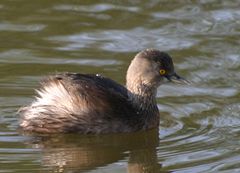
Grebe
Grebe
A grebe is a member of the Podicipediformes order, a widely distributed order of freshwater diving birds, some of which visit the sea when migrating and in winter...
s are small to medium-large sized freshwater diving birds. They have lobed toes, and are excellent swimmers and divers. However, they have their feet placed far back on the body, making them quite ungainly on land. There are 20 species worldwide and 2 species which occur in Panama.
- Least GrebeLeast GrebeThe Least Grebe , an aquatic bird, is the smallest member of the grebe family. It occurs in the New World from the southwestern United States and Mexico to Chile and Argentina, and also on Trinidad and Tobago, the Bahamas and the Greater Antilles.-Description:The Least Grebe ranges in length from...
Tachybaptus dominicus - Pied-billed GrebePied-billed GrebeThe Pied-billed Grebe is a species of the grebe family of water birds. Since the Atitlán Grebe, Podilymbus gigas, has become extinct, it is the sole extant member of the genus Podilymbus.-Description:...
Podilymbus podiceps
Albatrosses
Order: ProcellariiformesProcellariiformes
Procellariiformes is an order of seabirds that comprises four families: the albatrosses, petrels and shearwaters, storm petrels, and diving petrels...
. Family: Diomedeidae
The albatrosses are among the largest of flying birds, and the great albatrosses from the genus Diomedea have the largest wingspans of any extant birds. There are 21 species worldwide and 3 species which occur in Panama.
- Wandering AlbatrossWandering AlbatrossThe Wandering Albatross, Snowy Albatross or White-winged Albatross, Diomedea exulans, is a large seabird from the family Diomedeidae, which has a circumpolar range in the Southern Ocean. It was the first species of albatross to be described, and was long considered the same species as the Tristan...
Diomedea exulans (A) - Waved AlbatrossWaved AlbatrossThe Waved Albatross, Phoebastria irrorata - also known as Galapagos Albatross - is the only member of the Diomedeidae family located in the tropics. When they forage, the Waved Albatross follow straight paths to a single site off the coast of Peru, about distant to the east...
Phoebastria irrorata (A) - Gray-headed Albatross Thalassarche chrysostoma (A)
Shearwaters and petrels
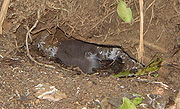
Procellariiformes
Procellariiformes is an order of seabirds that comprises four families: the albatrosses, petrels and shearwaters, storm petrels, and diving petrels...
. Family: Procellariidae
Procellariidae
The family Procellariidae is a group of seabirds that comprises the fulmarine petrels, the gadfly petrels, the prions, and the shearwaters. This family is part of the bird order Procellariiformes , which also includes the albatrosses, the storm-petrels, and the diving petrels.The procellariids are...
The procellariids are the main group of medium-sized 'true petrels', characterised by united nostrils with a medium septum, and a long outer functional primary. There are 75 species worldwide and 9 species which occur in Panama.
- Galapagos PetrelGalápagos PetrelThe Galápagos Petrel is a large, long-winged gadfly petrel. The species was once known as the Dark-rumped Petrel, although recent taxonomic changes have eliminated that name from current use...
Pterodroma phaeopygia (A) - Parkinson's PetrelParkinson's PetrelBlack Petrel , also called the Parkinson's Petrel, is a large, black petrel, the smallest of the Procellaria. The species is an endemic breeder of New Zealand, breeding only on islands off the North Island, on Great Barrier Island and Little Barrier Island. At sea it disperses as far as Australia...
Procellaria parkinsoni (A) - Cory's ShearwaterCory's ShearwaterThe Cory's Shearwater is a large shearwater in the seabird family Procellariidae.This species breeds on islands and cliffs in the Mediterranean, with the odd outpost on the Atlantic coast of Iberia. The nest is on open ground or among rocks or less often in a burrow where one white egg is laid,...
Calonectris diomedea (A) - Wedge-tailed ShearwaterWedge-tailed ShearwaterThe Wedge-tailed Shearwater, Puffinus pacificus is a medium-large shearwater in the seabird family Procellariidae. It is one of the shearwater species that is sometimes referred to as a Muttonbird, like the Sooty Shearwater of New Zealand and the Short-tailed Shearwater of Australia...
Puffinus pacificus (A) - Sooty ShearwaterSooty ShearwaterThe Sooty Shearwater is a medium-large shearwater in the seabird family Procellariidae. In New Zealand it is also known by its Māori name tītī and as "muttonbird", like its relatives the Wedge-tailed Shearwater and the Australian Short-tailed Shearwater The Sooty Shearwater (Puffinus griseus) is...
Puffinus griseus - Christmas ShearwaterChristmas ShearwaterThe Christmas Shearwater, Puffinus nativitatis, is a medium-sized shearwater of the tropical Central Pacific. It is a poorly known species due to its remote nesting habits, and it has not been extensively studied at sea either....
Puffinus navitatis (A) - Manx ShearwaterManx ShearwaterThe Manx Shearwater is a medium-sized shearwater in the seabird family Procellariidae. The scientific name of this species records a name shift: Manx Shearwaters were called Manks Puffins in the 17th century. Puffin is an Anglo-Norman word for the cured carcasses of nestling shearwaters...
Puffinus puffinus (A) - Townsend's ShearwaterTownsend's ShearwaterTownsend's Shearwater, Puffinus auricularis, is a rare seabird of the tropics from the family Procellariidae.Its relationships are unresolved. Its closest relatives are probably, but not certainly, the Hawaiian Shearwater and possibly the Manx Shearwater...
Puffinus auricularis (A) - Audubon's ShearwaterAudubon's ShearwaterAudubon's Shearwater, Puffinus lherminieri, is a common tropical seabird from the family Procellariidae. Sometimes called Dusky-backed Shearwater, the scientific name of this species commemorates the French naturalist Félix Louis L'Herminier....
Puffinus lherminieri
Storm-Petrels
Order: ProcellariiformesProcellariiformes
Procellariiformes is an order of seabirds that comprises four families: the albatrosses, petrels and shearwaters, storm petrels, and diving petrels...
. Family: Hydrobatidae
The storm-petrel
Storm-petrel
Storm petrels are seabirds in the family Hydrobatidae, part of the order Procellariiformes. These smallest of seabirds feed on planktonic crustaceans and small fish picked from the surface, typically while hovering. The flight is fluttering and sometimes bat-like.Storm petrels have a cosmopolitan...
s are relatives of the petrel
Petrel
Petrels are tube-nosed seabirds in the bird order Procellariiformes. The common name does not indicate relationship beyond that point, as "petrels" occur in three of the four families within that group...
s, and are the smallest of sea-birds. They feed on plankton
Plankton
Plankton are any drifting organisms that inhabit the pelagic zone of oceans, seas, or bodies of fresh water. That is, plankton are defined by their ecological niche rather than phylogenetic or taxonomic classification...
ic crustaceans and small fish picked from the surface, typically while hovering. The flight is fluttering and sometimes bat
Bat
Bats are mammals of the order Chiroptera "hand" and pteron "wing") whose forelimbs form webbed wings, making them the only mammals naturally capable of true and sustained flight. By contrast, other mammals said to fly, such as flying squirrels, gliding possums, and colugos, glide rather than fly,...
-like. There are 21 species worldwide and 6 species which occur in Panama.
- Wilson's Storm-PetrelWilson's Storm-petrelWilson's Storm Petrel , also known as Wilson's Petrel, is a small seabird of the storm-petrel family. It is one of the most abundant bird species in the world and has a circumpolar distribution mainly in the seas of the southern hemisphere but extending northwards during the summer of the northern...
Oceanites oceanicus (A) - White-vented Storm-PetrelWhite-vented Storm-petrelThe Elliot's Storm Petrel is a species of seabird in the storm-petrel family Hydrobatidae. The species is also known as White-vented Storm-petrel. There are two subspecies, O. g. gracilis, which is found in the Humboldt Current off Peru and Chile, and O. g. galapagoensis, which is found in the...
Oceanites gracilis (A) - Least Storm-PetrelLeast Storm-petrelThe Least Storm Petrel is a small seabird of the storm-petrel family Hydrobatidae. It is 13–15 cm in length, with a wingspan of 32 cm. It is the smallest member of the order Procellariiformes...
Oceanodroma microsoma - Wedge-rumped Storm-PetrelWedge-rumped Storm-petrelThe Wedge-rumped Storm Petrel is a storm-petrel. It breeds in the Galápagos Islands and on the coast of Peru.-External links:*...
Oceanodroma tethys - Markham's Storm-PetrelMarkham's Storm-petrelThe Markham's Storm Petrel is a species of seabird in the Hydrobatidae family.It is found in Chile, Colombia, Ecuador, French Polynesia, Peru, and possibly Costa Rica....
Oceanodroma markhami (A) - Black Storm-PetrelBlack Storm-petrelThe Black Storm Petrel is a small seabird of the storm-petrel family Hydrobatidae. It is 23 cm in length, with a wingspan of 46–51 cm....
Oceanodroma melania
Tropicbirds
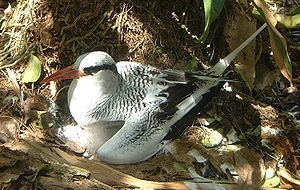
Pelecaniformes
The Pelecaniformes is a order of medium-sized and large waterbirds found worldwide. As traditionally—but erroneously—defined, they encompass all birds that have feet with all four toes webbed. Hence, they were formerly also known by such names as totipalmates or steganopodes...
. Family: Phaethontidae
Tropicbird
Tropicbird
Tropicbirds are a family, Phaethontidae, of tropical pelagic seabirds now classified in their own order Phaethontiformes. Their relationship to other living birds is unclear, and they appear to have no close relatives. There are three species in one genus, Phaethon...
s are slender white birds of tropical oceans, with exceptionally long central tail feathers. Their heads and long wings have black markings. There are 3 species worldwide and 2 species which occur in Panama.
- Red-billed TropicbirdRed-billed TropicbirdThe Red-billed Tropicbird, Phaethon aethereus, also known as the Boatswain Bird is a tropicbird, one of three closely related seabirds of tropical oceans.-Distribution and habitat:...
Phaethon aethereus - White-tailed TropicbirdWhite-tailed TropicbirdThe White-tailed Tropicbird Phaethon lepturus, is a tropicbird, smallest of three closely related seabirds of the tropical oceans and smallest member of the order Phaethontiformes. It occurs in the tropical Atlantic, western Pacific and Indian Oceans...
Phaethon lepturus (A)
Pelicans
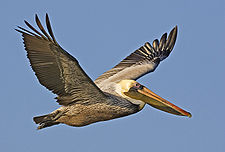
Pelecaniformes
The Pelecaniformes is a order of medium-sized and large waterbirds found worldwide. As traditionally—but erroneously—defined, they encompass all birds that have feet with all four toes webbed. Hence, they were formerly also known by such names as totipalmates or steganopodes...
. Family: Pelecanidae
Pelican
Pelican
A pelican, derived from the Greek word πελεκυς pelekys is a large water bird with a large throat pouch, belonging to the bird family Pelecanidae....
s are large water birds with a distinctive pouch under the beak. As with other members of the order Pelecaniformes, they have webbed feet with four toes. There are 8 species worldwide and 2 species which occur in Panama.
- American White PelicanAmerican White PelicanThe American White Pelican is a large aquatic bird from the order Pelecaniformes. It breeds in interior North America, moving south and to the coasts, as far as Central America, in winter....
Pelecanus erythrorhynchos (A) - Brown PelicanBrown PelicanThe Brown Pelican is the smallest of the eight species of pelican, although it is a large bird in nearly every other regard. It is in length, weighs from and has a wingspan from .-Range and habits:...
Pelecanus occidentalis
Boobies
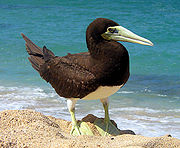
Pelecaniformes
The Pelecaniformes is a order of medium-sized and large waterbirds found worldwide. As traditionally—but erroneously—defined, they encompass all birds that have feet with all four toes webbed. Hence, they were formerly also known by such names as totipalmates or steganopodes...
. Family: Sulidae
Sulidae
The bird family Sulidae comprises the gannets and boobies. Collectively called sulidas, they are medium-large coastal seabirds that plunge-dive for fish and similar prey. The ten species in this family are often considered congeneric in older sources, placing all in the genus Sula...
The sulids comprise the gannet
Gannet
Gannets are seabirds comprising the genus Morus, in the family Sulidae, closely related to the boobies.The gannets are large black and white birds with yellow heads. They have long pointed wings and long bills. Northern gannets are the largest seabirds in the North Atlantic, with a wingspan of up...
s and boobies
Booby
A booby is a seabird in the genus Sula, part of the Sulidae family. Boobies are closely related to the gannets , which were formerly included in Sula.-Description:...
. Both groups comprise medium-to-large coastal sea-birds that plunge-dive for fish. There are 9 species worldwide and 6 species which occur in Panama.
- Blue-footed BoobyBlue-footed BoobyThe Blue-footed Booby is a bird in the Sulidae family which comprises ten species of long-winged seabirds. The natural breeding habitat of the Blue-footed Booby is tropical and subtropical islands off the Pacific Ocean, most famously, the Galápagos Islands, Ecuador.- Etymology :The name booby...
Sula nebouxii - Peruvian BoobyPeruvian BoobyThe Peruvian Booby, Sula variegata, is an endemic bird of the Peruvian current whose distribution is restricted to the west coast of South America from Punta Pariñas in Peru to Concepción in Chile . It is the second most abundant seabird species that inhabits the Peruvian Coast and the second...
Sula variegata - Masked BoobyMasked BoobyThe Masked Booby, Sula dactylatra, is a large seabird of the booby family, Sulidae. This species breeds on islands in tropical oceans, except in the eastern Atlantic; in the eastern Pacific it is replaced by the Nazca Booby, Sula granti, which was formerly regarded as a subspecies of Masked Booby...
Sula dactylatra - Nazca BoobyNazca BoobyThe Nazca Booby, Sula granti, is a booby which is found in the eastern Pacific Ocean, namely on the Galápagos Islands where it can be seen by eco-tourists, and on Clipperton Island...
Sula granti - Red-footed BoobyRed-footed BoobyThe Red-footed Booby, Sula sula, is a large seabird of the booby family, Sulidae. As suggested by the name, adults always have red feet, but the colour of the plumage varies. They are powerful and agile fliers, but they are clumsy in takeoffs and landings...
Sula sula - Brown BoobyBrown BoobyThe Brown Booby is a large seabird of the booby family, Sulidae. The adult brown booby reaches about in length. Its head and upper body are covered in dark brown, with the remainder being a contrasting white. The juvenile form is gray-brown with darkening on the head, wings and tail...
Sula leucogaster
Cormorants

Pelecaniformes
The Pelecaniformes is a order of medium-sized and large waterbirds found worldwide. As traditionally—but erroneously—defined, they encompass all birds that have feet with all four toes webbed. Hence, they were formerly also known by such names as totipalmates or steganopodes...
. Family: Phalacrocoracidae
The Phalacrocoracidae is a family of medium-to-large coastal, fish-eating sea-birds that includes cormorants and shags. Plumage colouration varies with the majority having mainly dark plumage, some species being black and white, and a few being colourful. There are 38 species worldwide and 2 species which occur in Panama.
- Neotropic CormorantNeotropic CormorantThe Neotropic Cormorant or Olivaceous Cormorant is a medium-sized cormorant found throughout the American tropics and subtropics, from the middle Rio Grande and the Gulf and Californian coasts of the USA south through Mexico and Central America to southern South America. It also breeds on the...
Phalacrocorax brasilianus - Guanay CormorantGuanay CormorantThe Guanay Cormorant or Guanay Shag is a member of the cormorant family found in on the Pacific coast of Peru and northern Chile...
Phalacrocorax bougainvillii (A)
Darters
Order: PelecaniformesPelecaniformes
The Pelecaniformes is a order of medium-sized and large waterbirds found worldwide. As traditionally—but erroneously—defined, they encompass all birds that have feet with all four toes webbed. Hence, they were formerly also known by such names as totipalmates or steganopodes...
. Family: Anhingidae
Darters are frequently referred to as "snake-birds" because of their long thin neck, which gives a snake-like appearance when they swim with their bodies submerged.
The males have black and dark brown plumage, an erectile crest on the nape and a larger bill than the female. The females have a much paler plumage especially on the neck and underparts. The darters have completely webbed feet, and their legs are short and set far back on the body. Their plumage is somewhat permeable, like that of cormorants, and they spread their wings to dry after diving. There are 4 species worldwide and 1 species which occurs in Panama.
- AnhingaAnhingaThe Anhinga , sometimes called Snakebird, Darter, American Darter, or Water Turkey, is a water bird of the warmer parts of the Americas. The word "anhinga" comes from the Brazilian Tupi language and means devil bird or snake bird.It is a cormorant-like bird with an average body length of , a...
Anhinga anhinga
Frigatebirds

Pelecaniformes
The Pelecaniformes is a order of medium-sized and large waterbirds found worldwide. As traditionally—but erroneously—defined, they encompass all birds that have feet with all four toes webbed. Hence, they were formerly also known by such names as totipalmates or steganopodes...
. Family: Fregatidae
Frigatebird
Frigatebird
The frigatebirds are a family, Fregatidae, of seabirds. There are five species in the single genus Fregata. They are also sometimes called Man of War birds or Pirate birds. Since they are related to the pelicans, the term "frigate pelican" is also a name applied to them...
s are large sea-birds usually found over tropical oceans. They are large, black and white or completely black, with long wings and deeply-forked tails. The males have inflatable coloured throat pouches. They do not swim or walk, and cannot take off from a flat surface. Having the largest wingspan to body weight ratio of any bird, they are essentially aerial, able to stay aloft for more than a week. There are 5 species worldwide and 2 species which occur in Panama.
- Magnificent FrigatebirdMagnificent FrigatebirdThe Magnificent Frigatebird was sometimes previously known as Man O'War, reflecting its rakish lines, speed, and aerial piracy of other birds....
Fregata magnificens - Great FrigatebirdGreat FrigatebirdThe Great Frigatebird is a large dispersive seabird in the frigatebird family. Major nesting populations are found in the Pacific and Indian Oceans, as well as a population in the South Atlantic....
Fregata minor (A)
Bitterns, herons and egrets

Ciconiiformes
Traditionally, the order Ciconiiformes has included a variety of large, long-legged wading birds with large bills: storks, herons, egrets, ibises, spoonbills, and several others. Ciconiiformes are known from the Late Eocene...
. Family: Ardeidae
The family Ardeidae contains the bittern
Bittern
Bitterns are a classification of birds in the heron family, Ardeidae, a family of wading birds. Species named bitterns tend to be the shorter-necked, often more secretive members of this family...
s, heron
Heron
The herons are long-legged freshwater and coastal birds in the family Ardeidae. There are 64 recognised species in this family. Some are called "egrets" or "bitterns" instead of "heron"....
s and egret
Egret
An egret is any of several herons, most of which are white or buff, and several of which develop fine plumes during the breeding season. Many egrets are members of the genera Egretta or Ardea which contain other species named as herons rather than egrets...
s. Herons and egrets are medium to large sized wading birds with long necks and legs. Bitterns tend to be shorter necked and more wary. Unlike other long-necked birds such as storks, ibises and spoonbills, members of Ardeidae fly with their necks retracted. There are 61 species worldwide and 20 species which occur in Panama.
- Capped HeronCapped HeronThe Capped Heron is a species of heron in the Ardeidae family. It is in the monotypic genus Pilherodius.It is found in Bolivia, Brazil, Colombia, Ecuador, French Guiana, Guyana, Panama, Paraguay, Peru, Suriname, and Venezuela.Its natural habitats are rivers, swamps, and freshwater lakes....
Pilherodius pileatus - Great Blue HeronGreat Blue HeronThe Great Blue Heron is a large wading bird in the heron family Ardeidae, common near the shores of open water and in wetlands over most of North and Central America as well as the West Indies and the Galápagos Islands. It is a rare vagrant to Europe, with records from Spain, the Azores and England...
Ardea herodias - Cocoi HeronCocoi HeronThe Cocoi Heron is a species of heron in the Ardeidae family. It is found in Argentina, Bolivia, Brazil, Chile, Colombia, Ecuador, French Guiana, Guyana, Panama, Paraguay, Peru, Suriname, Uruguay, and Venezuela. It is a non-breeding visitor to Trinidad and Tobago and a vagrant to the Falkland...
Ardea cocoi - Great EgretGreat EgretThe Great Egret , also known as the Great White Egret or Common Egret, White Heron, or Great White Heron, is a large, widely-distributed egret. Distributed across most of the tropical and warmer temperate regions of the world, in southern Europe it is rather localized...
Ardea alba - Reddish EgretReddish EgretThe Reddish Egret is a small heron. It is a resident breeder in Central America, The Bahamas, the Caribbean, the Gulf Coast of the United States, and Mexico. There is post-breeding dispersal to well north of the nesting range...
Egretta rufescens (A) - Tricolored HeronTricolored HeronThe Tricolored Heron formerly known in North America as the Louisiana Heron, is a small heron. It is a resident breeder from the Gulf states of the USA and northern Mexico south through Central America and the Caribbean to central Brazil and Peru...
Egretta tricolor - Little Blue HeronLittle Blue HeronThe Little Blue Heron, Egretta caerulea, is a small heron. It breeds from the Gulf states of the USA through Central America and the Caribbean south to Peru and Uruguay. It is a resident breeder in most of its range, but some northern breeders migrate to the southeastern USA or beyond in winter...
Egretta caerulea - Snowy EgretSnowy EgretThe Snowy Egret is a small white heron. It is the American counterpart to the very similar Old World Little Egret, which has established a foothold in the Bahamas....
Egretta thula - Cattle EgretCattle EgretThe Cattle Egret is a cosmopolitan species of heron found in the tropics, subtropics and warm temperate zones. It is the only member of the monotypic genus Bubulcus, although some authorities regard its two subspecies as full species, the Western Cattle Egret and the Eastern Cattle Egret...
Bubulcus ibis - Striated HeronStriated HeronThe Striated Heron, Butorides striata, also known as Mangrove Heron, Little Heron or Green-backed Heron, is a small heron. Striated Herons are mostly non-migratory and noted for some interesting behavioral traits. Their breeding habitat is small wetlands in the Old World tropics from west Africa to...
Butorides striata - Green HeronGreen HeronThe Green Heron is a small heron of North and Central America. It was long considered conspecific with its sister species the Striated Heron , and together they were called "Green-backed Heron"...
Butorides virescens - Agami HeronAgami HeronThe Agami Heron is a medium-sized heron. It is a resident breeding bird from Central America south to Peru and Brazil.It is sometimes known as the Chestnut-bellied Heron, and is the only member of the genus Agamia .The Agami Heron's habitat is forest swamps and similar wooded wetlands...
Agamia agami - Black-crowned Night-Heron Nycticorax nycticorax
- Yellow-crowned Night-Heron Nyctanassa violacea
- Boat-billed HeronBoat-billed HeronThe Boat-billed Heron - colloquially known as the Boatbill - is an atypical member of the heron family, and was formerly thought to be in a monotypic family, Cochlearidae....
Cochlearius cochlearius - Bare-throated Tiger-Heron Tigrisoma mexicanum
- Fasciated Tiger-HeronFasciated Tiger-heronThe Fasciated Tiger Heron is a species of heron in the Ardeidae family. It is native to Argentina, Bolivia, Brazil, Colombia, Costa Rica, Ecuador, Mexico, Panama, Peru, and Venezuela, and a vagrant in Nicaragua...
Tigrisoma fasciatum - Rufescent Tiger-HeronRufescent Tiger-heronThe Rufescent Tiger Heron , also known as the Soco-Boi, is a species of heron in the Ardeidae family.-Distribution and habitat:...
Tigrisoma lineatum - Least BitternLeast BitternThe Least Bittern is a small wading bird, the smallest heron found in the Americas.This bird's underparts and throat are white with light brown streaks. Their face and the sides of the neck are light brown; they have yellow eyes and a yellow bill. The adult male is glossy greenish black on the...
Ixobrychus exilis - American BitternAmerican BitternThe American Bittern is a wading bird of the heron family Ardeidae. New evidence has led the American Ornithologists' Union to move the heron family into the order Pelecaniformes .-Description:...
Botaurus lentiginosus (A)
Storks
Order: CiconiiformesCiconiiformes
Traditionally, the order Ciconiiformes has included a variety of large, long-legged wading birds with large bills: storks, herons, egrets, ibises, spoonbills, and several others. Ciconiiformes are known from the Late Eocene...
. Family: Ciconiidae
Storks are large, long-legged, long-necked, wading birds with long, stout bills. Storks are mute; bill-clattering is an important mode of stork communication at the nest. Their nests can be large and may be reused for many years. Many species are migratory. There are 19 species worldwide and 2 species which occur in Panama.
- Wood StorkWood StorkThe Wood Stork is a large American wading bird in the stork family Ciconiidae. It was formerly called the "Wood Ibis", though it is not really an ibis.-Appearance:...
Mycteria americana - JabiruJabiruThe Jabiru is a large stork found in the Americas from Mexico to Argentina, except west of the Andes. It is most common in the Pantanal region of Brazil and the Eastern Chaco region of Paraguay. It is the only member of the genus Jabiru...
Jabiru mycteria (A)
Ibises and spoonbills

Ciconiiformes
Traditionally, the order Ciconiiformes has included a variety of large, long-legged wading birds with large bills: storks, herons, egrets, ibises, spoonbills, and several others. Ciconiiformes are known from the Late Eocene...
. Family: Threskiornithidae
Threskiornithidae
The family Threskiornithidae includes 34 species of large terrestrial and wading birds, falling into two subfamilies, the ibises and the spoonbills. It was formerly known as Plataleidae. The spoonbills and ibises were once thought to be related to other groups of long-legged wading birds in the...
The Threskiornithidae is a family of large terrestrial and wading birds which includes the ibis
Ibis
The ibises are a group of long-legged wading birds in the family Threskiornithidae....
es and spoonbill
Spoonbill
Spoonbills are a group of large, long-legged wading birds in the family Threskiornithidae, which also includes the Ibises.All have large, flat, spatulate bills and feed by wading through shallow water, sweeping the partly opened bill from side to side...
s. They have long, broad wings with 11 primary and about 20 secondary feathers. They are strong fliers and despite their size and weight, very capable soarers. There are 36 species worldwide and 6 species which occur in Panama.
- Buff-necked IbisBuff-necked IbisThe Buff-necked Ibis , also known as the White-throated Ibis, is a fairly large ibis found widely in open habitats of eastern and northern South America...
Theristicus caudatus (A) - Green IbisGreen IbisThe Green Ibis is a wading bird in the ibis family Threskiornithidae. It is the only member of the genus Mesembrinibis....
Mesembrinibis cayennensis - White IbisAmerican White IbisThe American White Ibis is a species of wading bird in the ibis family Threskiornithidae. It occurs from the mid-Atlantic and Gulf coast of the United States south through most of the New World tropics...
Eudocimus albus - Scarlet IbisScarlet IbisThe Scarlet Ibis is a species of ibis that inhabits tropical South America and also Trinidad and Tobago. It is the national bird of Trinidad and is featured on the Trinidad and Tobago coat of arms along with Tobago's national bird, the Rufous-vented Chachalaca.-Taxonomy:This species is very...
Eudocimus ruber (A) - Glossy IbisGlossy IbisThe Glossy Ibis is a wading bird in the ibis family Threskiornithidae.This is the most widespread ibis species, breeding in scattered sites in warm regions of Europe, Asia, Africa, Australia, and the Atlantic and Caribbean region of the Americas...
Plegadis falcinellus (A) - Roseate SpoonbillRoseate SpoonbillThe Roseate Spoonbill, Platalea ajaja, is a gregarious wading bird of the ibis and spoonbill family, Threskiornithidae...
Platalea ajaja
Ducks
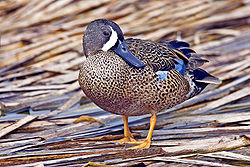
Anseriformes
The order Anseriformes contains about 150 living species of birds in three extant families: the Anhimidae , Anseranatidae , and the Anatidae, which includes over 140 species of waterfowl, among them the ducks, geese, and swans.All species in the order are highly adapted for an aquatic existence at...
. Family: Anatidae
Anatidae
Anatidae is the biological family of birds that includes ducks, geese and swans. The family has a cosmopolitan distribution, occurring on all the world's continents except Antarctica and on most of the world's islands and island groups...
The family Anatidae includes the duck
Duck
Duck is the common name for a large number of species in the Anatidae family of birds, which also includes swans and geese. The ducks are divided among several subfamilies in the Anatidae family; they do not represent a monophyletic group but a form taxon, since swans and geese are not considered...
s and most duck-like waterfowl, such as geese
Goose
The word goose is the English name for a group of waterfowl, belonging to the family Anatidae. This family also includes swans, most of which are larger than true geese, and ducks, which are smaller....
and swan
Swan
Swans, genus Cygnus, are birds of the family Anatidae, which also includes geese and ducks. Swans are grouped with the closely related geese in the subfamily Anserinae where they form the tribe Cygnini. Sometimes, they are considered a distinct subfamily, Cygninae...
s. These are birds that are modified for an aquatic existence with webbed feet, flattened bills and feathers that are excellent at shedding water due to an oily coating. There are 131 species worldwide and 16 species which occur in Panama.
- Fulvous Whistling-Duck Dendrocygna bicolor (A)
- White-faced Whistling-Duck Dendrocygna viduata (A)
- Black-bellied Whistling-Duck Dendrocygna autumnalis
- Muscovy DuckMuscovy DuckThe Muscovy Duck is a large duck which is native to Mexico and Central and South America. A small wild population reaches into the United States in the lower Rio Grande Valley of Texas...
Cairina moschata - Comb DuckComb DuckThe Knob-billed Duck , or Comb Duck, is an unusual, pan-tropical duck, found in tropical wetlands in sub-Saharan Africa, Madagascar and south Asia from Pakistan to Laos and extreme southern China...
Sarkidiornis melanotos - American WigeonAmerican WigeonThe American Wigeon, also American Widgeon or Baldpate, is a species of wigeon in the dabbling duck genus Anas. If this is split up, all wigeons will go into their old genus Mareca again...
Anas americana - Green-winged TealGreen-winged TealThe Green-winged Teal is a common and widespread duck that breeds in the northern areas of North America except on the Aleutian Islands. It was considered conspecific with the Common Teal The Green-winged Teal (Anas carolinensis) is a common and widespread duck that breeds in the northern areas of...
Anas carolinensis (A) - MallardMallardThe Mallard , or Wild Duck , is a dabbling duck which breeds throughout the temperate and subtropical Americas, Europe, Asia, and North Africa, and has been introduced to New Zealand and Australia....
Anas platyrhynchos (A) - Northern PintailNorthern PintailThe Pintail or Northern Pintail is a widely occurring duck which breeds in the northern areas of Europe, Asia and North America. It is strongly migratory and winters south of its breeding range to the equator...
Anas acuta (A) - White-cheeked PintailWhite-cheeked PintailThe White cheeked Pintail or Bahama Pintail is a dabbling duck of the Caribbean, South America, and the Galápagos Islands....
Anas bahamensis (A) - Blue-winged TealBlue-winged TealThe Blue-winged Teal is a small dabbling duck from North America.-Description:The Blue-winged Teal is long, with a wingspan of , and a weight of . The adult male has a greyish blue head with a white facial crescent, a light brown body with a white patch near the rear and a black tail. The adult...
Anas discors - Cinnamon TealCinnamon TealThe Cinnamon Teal is a small, reddish dabbling duck found in marshes and ponds of western North and South America.thumb|left|Female Anas cyanoptera septentrionalium...
Anas cyanoptera (A) - Northern ShovelerNorthern ShovelerThe Northern Shoveler , Northern Shoveller in British English, sometimes known simply as the Shoveler, is a common and widespread duck. It breeds in northern areas of Europe and Asia and across most of North America, and is a rare vagrant to Australia...
Anas clypeata (A) - Ring-necked DuckRing-necked DuckThe Ring-necked Duck is a smaller diving duck from North America.The adult male is similar in color pattern to the Eurasian Tufted Duck, its relative. It has a grey bill with a white band, a shiny purple head, a white breast, yellow eyes and a dark grey back...
Aythya collaris - Lesser ScaupLesser ScaupThe Lesser Scaup is a small North American diving duck that migrates south as far as Central America in winter. It is colloquially known as the Little Bluebill or Broadbill because of its distinctive blue bill...
Aythya affinis - Masked DuckMasked DuckThe Masked Duck is a tiny stiff-tailed duck ranging through the tropical Americas. They are found from Mexico to South America and also in the Caribbean...
Nomonyx dominica
New World vultures

Falconiformes
The order Falconiformes is a group of about 290 species of birds that comprises the diurnal birds of prey. Raptor classification is difficult and the order is treated in several ways.- Classification problems :...
. Family: Cathartidae
The New World vultures are not closely related to Old World vultures, but superficially resemble them because of convergent evolution
Convergent evolution
Convergent evolution describes the acquisition of the same biological trait in unrelated lineages.The wing is a classic example of convergent evolution in action. Although their last common ancestor did not have wings, both birds and bats do, and are capable of powered flight. The wings are...
. Like the Old World vultures, they are scavengers. However, unlike Old World vultures, which find carcasses by sight, New World vultures have a good sense of smell with which they locate carrion
Carrion
Carrion refers to the carcass of a dead animal. Carrion is an important food source for large carnivores and omnivores in most ecosystems. Examples of carrion-eaters include vultures, hawks, eagles, hyenas, Virginia Opossum, Tasmanian Devils, coyotes, Komodo dragons, and burying beetles...
. There are 7 species worldwide, all of which are found only in the Americas, and 4 species which occur in Panama.
- Black VultureAmerican Black VultureThe Black Vulture also known as the American Black Vulture, is a bird in the New World vulture family whose range extends from the southeastern United States to Central Chile and Uruguay in South America...
Coragyps atratus - Turkey VultureTurkey VultureThe Turkey Vulture is a bird found throughout most of the Americas. It is also known in some North American regions as the Turkey Buzzard , and in some areas of the Caribbean as the John Crow or Carrion Crow...
Cathartes aura - Lesser Yellow-headed VultureLesser Yellow-headed VultureThe Lesser Yellow-headed Vulture, Cathartes burrovianus, also known as the Savannah Vulture, is a species of bird in the New World Vulture family Cathartidae. It was considered to be the same species as the Greater Yellow-headed Vulture until they were split in 1964...
Cathartes burrovianus - King VultureKing VultureThe King Vulture is a large bird found in Central and South America. It is a member of the New World vulture family Cathartidae. This vulture lives predominantly in tropical lowland forests stretching from southern Mexico to northern Argentina, though some believe that William Bartram's Painted...
Sarcoramphus papa
Osprey
Order: FalconiformesFalconiformes
The order Falconiformes is a group of about 290 species of birds that comprises the diurnal birds of prey. Raptor classification is difficult and the order is treated in several ways.- Classification problems :...
. Family: Pandionidae
The Pandionidae family contains only one species, the Osprey. The Osprey is a medium large raptor
Bird of prey
Birds of prey are birds that hunt for food primarily on the wing, using their keen senses, especially vision. They are defined as birds that primarily hunt vertebrates, including other birds. Their talons and beaks tend to be relatively large, powerful and adapted for tearing and/or piercing flesh....
which is a specialist fish-eater with a worldwide distribution.
- OspreyOspreyThe Osprey , sometimes known as the sea hawk or fish eagle, is a diurnal, fish-eating bird of prey. It is a large raptor, reaching more than in length and across the wings...
Pandion haliaetus
Hawks, kites and eagles
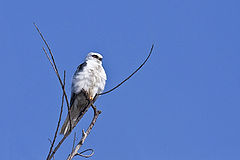
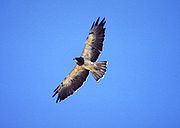

Falconiformes
The order Falconiformes is a group of about 290 species of birds that comprises the diurnal birds of prey. Raptor classification is difficult and the order is treated in several ways.- Classification problems :...
. Family: Accipitridae
Accipitridae
The Accipitridae, one of the two major families within the order Accipitriformes , are a family of small to large birds with strongly hooked bills and variable morphology based on diet. They feed on a range of prey items from insects to medium-sized mammals, with a number feeding on carrion and a...
Accipitridae is a family of birds of prey and include hawk
Hawk
The term hawk can be used in several ways:* In strict usage in Australia and Africa, to mean any of the species in the subfamily Accipitrinae, which comprises the genera Accipiter, Micronisus, Melierax, Urotriorchis and Megatriorchis. The large and widespread Accipiter genus includes goshawks,...
s, eagle
Eagle
Eagles are members of the bird family Accipitridae, and belong to several genera which are not necessarily closely related to each other. Most of the more than 60 species occur in Eurasia and Africa. Outside this area, just two species can be found in the United States and Canada, nine more in...
s, kites
Kite (bird)
Kites are raptors with long wings and weak legs which spend a great deal of time soaring. Most feed mainly on carrion but some take various amounts of live prey.They are birds of prey which, along with hawks and eagles, are from the family Accipitridae....
, harriers
Harrier (bird)
A harrier is any of the several species of diurnal hawks forming the Circinae sub-family of the Accipitridae family of birds of prey. Harriers characteristically hunt by flying low over open ground, feeding on small mammals, reptiles, or birds....
and Old World vultures. These birds have powerful hooked beaks for tearing flesh from their prey, strong legs, powerful talons, and keen eyesight. There are 233 species worldwide and 41 species which occur in Panama.
- Gray-headed KiteGray-headed KiteThe Gray-headed Kite, Leptodon cayanensis, is a raptor found in open woodland and swamp forests. It shares the genus Leptodon with the extremely rare White-collared Kite. It breeds from eastern Mexico and Trinidad south to Peru, Bolivia,Brazil and northern Argentina.The nest is made of sticks lined...
Leptodon cayanensis - Hook-billed KiteHook-billed KiteThe Hook-billed Kite, Chondrohierax uncinatus, is a bird of prey in the family Accipitridae, which also includes many other diurnal raptors such as kites, eagles, and harriers...
Chondrohierax uncinatus - Swallow-tailed KiteSwallow-tailed KiteThe Swallow-tailed Kite is an elanid kite which breeds from the southeastern United States to eastern Peru and northern Argentina. Most North and Central American breeders winter in South America where the species is resident year round...
Elanoides forficatus - Pearl KitePearl KiteThe Pearl Kite is a very small raptor found in open savanna habitat adjacent to deciduous woodland. It is the only member of the genus Gampsonyx...
Gampsonyx swainsonii - White-tailed KiteWhite-tailed KiteThe White-tailed Kite is an elanid kite of genus Elanus found in western North America and parts of South America.Their coloration is gull-like, but their shape and flight falcon-like, with a rounded tail...
Elanus leucurus - Snail KiteSnail KiteThe Snail Kite is a bird of prey within the family Accipitridae, which also includes the eagles, hawks, and Old World vultures. Its relative, the Slender-billed Kite, is now again placed in Helicolestes, making the genus Rostrhamus monotypic...
Rostrhamus sociabilis (A) - Slender-billed KiteSlender-billed KiteThe Slender-billed Kite is a bird of prey in the family Accipitridae, which also includes the eagles, hawks and Old World vultures. It is found near water in forested parts of tropical northern and central South America, and far eastern Panama...
Rostrhamus hamatus (A) - Double-toothed KiteDouble-toothed KiteThe Double-toothed Kite is a species of bird of prey in the Accipitridae family. It is found in Belize, Bolivia, Brazil, Colombia, Costa Rica, Ecuador, El Salvador, French Guiana, Guatemala, Guyana, Honduras, Mexico, Nicaragua, Panama, Peru, Suriname, Trinidad and Tobago, and Venezuela.This fairly...
Harpagus bidentatus - Mississippi KiteMississippi KiteThe Mississippi Kite is a small bird of prey in the family Accipitridae. It is 12 to 15 inches beak to tail and has a wingspan averaging 3 feet . Weight is from 214 to 388 grams . Adults are gray with darker gray on their tail feathers and outer wings and lighter gray on their heads...
Ictinia mississippiensis - Plumbeous KitePlumbeous KiteThe Plumbeous Kite is a bird of prey in the family Accipitridae, which also includes the eagles, hawks and Old World vultures....
Ictinia plumbea - Long-winged HarrierLong-winged HarrierThe Long-winged Harrier is a species of bird of prey in the family Accipitridae, native to South America.It is found in Argentina, Bolivia, Brazil, Chile, Colombia, Falkland Islands, French Guiana, Guyana, Paraguay, Suriname, Trinidad and Tobago, Uruguay, and Venezuela.Its natural habitats are dry...
Circus buffoni (A) - Northern Harrier Circus cyaneus
- Tiny HawkTiny HawkThe Tiny Hawk is a small diurnal bird of prey found in or near forests, primarily humid, throughout much of the Neotropics. It is primarily a bird-eater, and is known to prey on hummingbirds....
Accipiter superciliosus - Sharp-shinned HawkSharp-shinned HawkThe Sharp-shinned Hawk is a small hawk. In fact, "sharp-shins" or "sharpies" are the smallest to reside in USA and Canada, though some Neotropical species are smaller...
Accipiter striatus - Cooper's HawkCooper's HawkCooper's Hawk is a medium-sized hawk native to the North American continent and found from Canada to Mexico. As in many birds of prey, the male is smaller than the female...
Accipiter cooperii (A) - Bicolored Hawk Accipiter bicolor
- Crane HawkCrane HawkThe Crane Hawk is a species of bird of prey in the Accipitridae family. It is monotypic within the genus Geranospiza....
Geranospiza caerulescens - Plumbeous HawkPlumbeous HawkThe Plumbeous Hawk is a species of bird of prey in the Accipitridae family.It is found in Colombia, Ecuador, Panama, and Peru.Its natural habitat is subtropical or tropical moist lowland forests....
Leucopternis plumbeus - Barred HawkBarred HawkThe Barred Hawk is a species of bird of prey in the Accipitridae family. It has also been known as the Black-chested Hawk....
Leucopternis princeps - Semiplumbeous HawkSemiplumbeous HawkThe Semiplumbeous Hawk is a species of bird of prey in the Accipitridae family.It is found in Colombia, Costa Rica, Ecuador, Honduras, and Panama. Its natural habitat is subtropical or tropical moist lowland forests....
Leucopternis semiplumbeus - White HawkWhite HawkThe White Hawk , a bird of prey breeding in the tropical New World, belongs to the family Accipitridae of the Falconiformes; it is sometimes separated in the Accipitriformes with the other hawks and their relatives...
Leucopternis albicollis - Common Black-Hawk Buteogallus anthracinus
- Mangrove Black-Hawk Buteogallus subtilis
- Great Black-Hawk Buteogallus urubitinga
- Savanna HawkSavanna HawkThe Savanna Hawk is a large raptor found in open savanna and swamp edges. It was formerly placed in the genus Heterospizias. It breeds from Panama and Trinidad south to Bolivia, Uruguay and central Argentina....
Buteogallus meridionalis - Harris's HawkHarris's HawkThe Harris's Hawk or Harris Hawk formerly known as the Bay-winged Hawk or Dusky Hawk, is a medium-large bird of prey which breeds from the southwestern United States south to Chile and central Argentina...
Parabuteo unicinctus - Black-collared HawkBlack-collared HawkThe Black-collared Hawk is a species of bird of prey in the Accipitridae family. It is monotypic within the genus Busarellus....
Busarellus nigricollis - Solitary EagleSolitary EagleThe Montane Solitary Eagle, Harpyhaliaetus solitarius, is a large Neotropical eagle.- Range and habitat :The Montane Solitary Eagle is native to Mexico and Central and South America. It is found in mountainous or hilly forests, at elevations between 600 m & 2,200 m...
Harpyhaliaetus solitarius - Gray HawkGray HawkThe Grey Hawk or Grey-lined Hawk is a smallish raptor found in open country and forest edges. It is sometimes placed in the genus Asturina as Asturina nitida....
Asturina nitida - Roadside HawkRoadside HawkThe Roadside Hawk is a relatively small bird of prey found in Latin America. This vocal species is often the most common raptor in its range. It has many subspecies and is sometimes placed in the monotypic genus Rupornis instead of Buteo.-Description:The Roadside Hawk is long and weighs...
Buteo magnirostris - Broad-winged HawkBroad-winged HawkThe Broad-winged Hawk is a small hawk of the genus Buteo. During the summer some subspecies are distributed over eastern North America, as far west as British Columbia and Texas; they then migrate south to winter in the neotropics from Mexico down to southern Brazil. Other subspecies are all-year...
Buteo platypterus - Short-tailed HawkShort-tailed HawkThe Short-tailed Hawk is an American bird of prey in the family Accipitridae, which also includes the eagles and Old World vultures. As a member of the genus Buteo, it is not a true hawk and thus also referred to as a "buteo" or "buzzard". The White-throated Hawk The Short-tailed Hawk (Buteo...
Buteo brachyurus - Swainson's HawkSwainson's HawkThe Swainson's Hawk , is a large buteo hawk of the Falconiformes, sometimes separated in the Accipitriformes like its relatives. This species was named after William Swainson, a British naturalist...
Buteo swainsoni - White-tailed HawkWhite-tailed HawkThe White-tailed Hawk is a large bird of prey species found in tropical or subtropical environments across the Americas.-Description:...
Buteo albicaudatus - Zone-tailed HawkZone-tailed HawkThe Zone-tailed Hawk is a medium-sized hawk of warm, dry parts of the Americas. It feeds on small vertebrates of all kinds , including birds up to the size of quail....
Buteo albonotatus - Red-tailed HawkRed-tailed HawkThe Red-tailed Hawk is a bird of prey, one of three species colloquially known in the United States as the "chickenhawk," though it rarely preys on standard sized chickens. It breeds throughout most of North America, from western Alaska and northern Canada to as far south as Panama and the West...
Buteo jamaicensis - Crested EagleCrested EagleThe Crested Eagle is a large Neotropical eagle. It is the only member of the genus Morphnus. It is 71–89 cm long and has a wingspan of 138–176 cm...
Morphnus guianensis - Harpy Eagle Harpia harpyja
- Black-and-white Hawk-EagleBlack-and-white Hawk-eagleThe Black-and-white Hawk-Eagle is a bird of prey species in the eagle and hawk family...
Spizastur melanoleucus - Black Hawk-EagleBlack Hawk-EagleThe Black Hawk-Eagle , also known as theTyrant Hawk-Eagle, is a species of eagle found from central Mexico to eastern Peru, the south of Brazil, and far northern Argentina. Its preferred habitats include humid and moist forests close to rivers, and several types of woodland. It is uncommon to...
Spizaetus tyrannus - Ornate Hawk-Eagle Spizaetus ornatus
Caracaras and falcons

Falconiformes
The order Falconiformes is a group of about 290 species of birds that comprises the diurnal birds of prey. Raptor classification is difficult and the order is treated in several ways.- Classification problems :...
. Family: Falconidae
Falconidae
The falcons and caracaras are around 60 species of diurnal birds of prey that make up the family Falconidae. The family is divided into two subfamiles, Polyborinae, which includes the caracaras and forest falcons, and Falconinae, the falcons, kestrels and falconets.-Description:Falcons and...
Falconidae is a family of diurnal birds of prey. They differ from hawks, eagles, and kites in that they kill with their beaks instead of their feet. There are 62 species worldwide and 13 species which occur in Panama.
- Red-throated CaracaraRed-throated CaracaraThe Red-throated Caracara is a social species of bird of prey in the Falconidae family. It is placed in the monotypic genus Ibycter, or sometimes united in Daptrius with the Black Caracara...
Ibycter americanus - Northern Caracara Caracara cheriway
- Yellow-headed CaracaraYellow-headed CaracaraThe Yellow-headed Caracara is a bird of prey in the family Falconidae. It is found in tropical and subtropical South America and the southern portion of Central America...
Milvago chimachima - Laughing FalconLaughing FalconThe Laughing Falcon , also called the Snake Hawk , is a medium-sized bird of prey in the falcon family , the only member of the genus Herpetotheres. This Neotropical species is a specialist snake-eater...
Herpetotheres cachinnans - Barred Forest-falconBarred Forest-falconThe Barred Forest Falcon is a species of bird of prey in the Falconidae family which includes the falcons, caracaras, and their relatives...
Micrastur ruficollis - Slaty-backed Forest-falconSlaty-backed Forest-falconThe Slaty-backed Forest Falcon is a species of bird of prey in the Falconidae family.It is found in Bolivia, Brazil, Colombia, Costa Rica, Ecuador, French Guiana, Guyana, Panama, Peru, Suriname, and Venezuela....
Micrastur mirandollei - Collared Forest-falconCollared Forest-falconThe Collared Forest Falcon is a species of bird of prey in the Falconidae family.It is found in Argentina, Belize, Bolivia, Brazil, Colombia, Costa Rica, Ecuador, El Salvador, French Guiana, Guatemala, Guyana, Honduras, Mexico, Nicaragua, Panama, Paraguay, Peru, Suriname and Venezuela.Its natural...
Micrastur semitorquatus - American KestrelAmerican KestrelThe American Kestrel , sometimes colloquially known as the Sparrow Hawk, is a small falcon, and the only kestrel found in the Americas. It is the most common falcon in North America, and is found in a wide variety of habitats. At long, it is also the smallest falcon in North America...
Falco sparverius - Aplomado FalconAplomado FalconThe Aplomado Falcon, Falco femoralis, is a medium-sized falcon of the Americas. The species' largest contiguous range is in South America, but not in the deep interior Amazon Basin. It was long known as Falco fusco-coerulescens or Falco fuscocaerulescens, but these names are now believed to refer...
Falco femoralis - MerlinMerlin (bird)The Merlin is a small species of falcon from the Northern Hemisphere. A bird of prey once known colloquially as a pigeon hawk in North America, the Merlin breeds in the northern Holarctic; some migrate to subtropical and northern tropical regions in winter.-European and North American...
Falco columbarius - Bat FalconBat FalconThe Bat Falcon is a falcon that is a resident breeder in tropical Mexico, Central and South America and Trinidad. It was long known as Falco albigularis; the name Falco fusco-coerulescens or Falco fuscocaerulescens, long used for the Aplomado Falcon, are now believed to refer to the present...
Falco rufigularis - Orange-breasted FalconOrange-breasted FalconThe Orange-breasted Falcon is a bird of the falcon family. It is probably closely related to and looks like a larger version of the Bat Falcon. These two, in turn, are probably closest to the Aplomado Falcon and constitute a rather old American lineage of Falcos.It is found from southern Mexico to...
Falco deiroleucus (A) - Peregrine FalconPeregrine FalconThe Peregrine Falcon , also known as the Peregrine, and historically as the Duck Hawk in North America, is a widespread bird of prey in the family Falconidae. A large, crow-sized falcon, it has a blue-gray back, barred white underparts, and a black head and "moustache"...
Falco peregrinus
Guans, chachalacas and allies
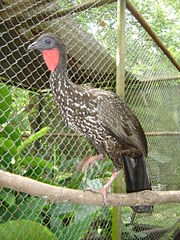
Galliformes
Galliformes are an order of heavy-bodied ground-feeding domestic or game bird, containing turkey, grouse, chicken, New and Old World Quail, ptarmigan, partridge, pheasant, and the Cracidae. Common names are gamefowl or gamebirds, landfowl, gallinaceous birds or galliforms...
. Family: Cracidae
Cracidae
The chachalacas, guans and curassows are birds in the family Cracidae.These are species of tropical and subtropical Central and South America. One species, the Plain Chachalaca, just reaches southernmost Texas in the USA...
The Cracidae are large birds, similar in general appearance to turkeys. The guans and curassows live in trees, but the smaller chachalacas are found in more open scrubby habitats. They are generally dull-plumaged, but the curassows and some guans have colourful facial ornaments. There are 50 species worldwide and 4 species which occur in Panama.
- Gray-headed Chachalaca Ortalis cinereiceps
- Crested GuanCrested GuanThe Crested Guan, Penelope purpurascens, is a member of an ancient group of birds of the Cracidae family, which are related to the Australasian mound builders. It breeds in lowlands from south Mexico and the Yucatán Peninsula to western Ecuador and southern Venezuela at up to 1850 m altitude.The...
Penelope purpurascens - Black GuanBlack GuanThe Black Guan is a species of bird in the Cracidae family.It is found in Costa Rica and Panama.Its natural habitat is subtropical or tropical moist montanes.It is threatened by habitat loss...
Chamaepetes unicolor - Great CurassowGreat CurassowThe Great Curassow is a large, pheasant-like bird from the Neotropics. At in length and in weight, this is a very large cracid. No other cracid match its maximum weight, but its length is matched by a few other cracids....
Crax rubra
New World quails
Order: GalliformesGalliformes
Galliformes are an order of heavy-bodied ground-feeding domestic or game bird, containing turkey, grouse, chicken, New and Old World Quail, ptarmigan, partridge, pheasant, and the Cracidae. Common names are gamefowl or gamebirds, landfowl, gallinaceous birds or galliforms...
. Family: Odontophoridae
The New World quail
New World quail
The New World quails or Odontophorids are small birds only distantly related to the Old World Quails, but named for their similar appearance and habits. The American species are in their own family Odontophoridae, whereas Old World Quail are in the pheasant family Phasianidae...
s are small, plump terrestrial birds only distantly related to the quails of the Old World, but named for their similar appearance and habits. There are 32 species worldwide, all found only in the Americas, and 7 species which occur in Panama.
- Crested BobwhiteCrested BobwhiteThe Crested Bobwhite is a species of bird in the Odontophoridae family.It is found in northern South America, extending through Panama to just reach Costa Rica...
Colinus cristatus - Marbled Wood-QuailMarbled Wood-quailThe Marbled Wood Quail is a species of bird in the Odontophoridae family.It is found in Bolivia, Brazil, Colombia, Costa Rica, Ecuador, French Guiana, Guyana, Panama, Peru, Suriname, and Venezuela. Its natural habitat is subtropical or tropical moist lowland forests.-References:* BirdLife...
Odontophorus gujanensis - Black-eared Wood-QuailBlack-eared Wood-quailThe Black-eared Wood Quail is a species of bird in the Odontophoridae family.It is found in Costa Rica, Honduras, Nicaragua, and Panama.-References:* BirdLife International 2004. . Downloaded on 10 July 2007....
Odontophorus melanotis - Tacarcuna Wood-QuailTacarcuna Wood-quailThe Tacarcuna Wood Quail is a species of bird in the Odontophoridae family.It is found in Colombia and Panama.Its natural habitat is subtropical or tropical moist montanes.It is threatened by habitat loss.-References:...
Odontophorus dialeucos - Black-breasted Wood-QuailBlack-breasted Wood-quailThe Black-breasted Wood Quail is a species of bird in the Odontophoridae family.It is found in Costa Rica and Panama....
Odontophorus leucolaemus - Spotted Wood-QuailSpotted Wood-QuailThe Spotted Wood Quail, Odontophorus guttatus, is a small ground-dwelling bird in the New World quail family. It is a resident breeder in the mountains of Central America from southern Mexico to western Panama....
Odontophorus guttatus - Tawny-faced QuailTawny-faced QuailThe Tawny-faced Quail is a species of bird in the Odontophoridae family, and the only species in its genus Rhynchortyx.It is found in Colombia, Costa Rica, Ecuador, Honduras, Nicaragua, and Panama...
Rhynchortyx cinctus
Limpkins
Order: GruiformesGruiformes
The Gruiformes are an order containing a considerable number of living and extinct bird families, with a widespread geographical diversity. Gruiform means "crane-like"....
. Family: Aramidae
The Limpkin resembles a large rail. It has drab brown plumage and a greyer head and neck.
- LimpkinLimpkinThe Limpkin , Aramus guarauna, is a bird that looks like a large rail but is skeletally closer to cranes. It is the only extant species in the genus Aramus and the family Aramidae. It is found mostly in wetlands in warm parts of the Americas, from Florida to northern Argentina...
Aramus guarauna
Rails, crakes, gallinules, and coots
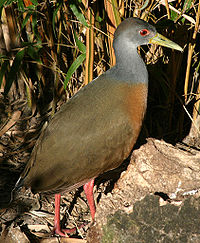
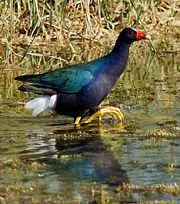
Gruiformes
The Gruiformes are an order containing a considerable number of living and extinct bird families, with a widespread geographical diversity. Gruiform means "crane-like"....
. Family: Rallidae
Rallidae
The rails, or Rallidae, are a large cosmopolitan family of small to medium-sized birds. The family exhibits considerable diversity and the family also includes the crakes, coots, and gallinules...
Rallidae is a large family of small to medium-sized birds which includes the rails, crakes, coot
Coot
Coots are medium-sized water birds that are members of the rail family Rallidae. They constitute the genus Fulica. Coots have predominantly black plumage, and, unlike many of the rails, they are usually easy to see, often swimming in open water...
s, and gallinules
Rallidae
The rails, or Rallidae, are a large cosmopolitan family of small to medium-sized birds. The family exhibits considerable diversity and the family also includes the crakes, coots, and gallinules...
. Typically they inhabit dense vegetation in damp environments near lakes, swamps, or rivers. In general they are shy and secretive birds, difficult to observe. Most species have strong legs, and have long toes which are well adapted to soft, uneven surfaces. They tend to have short, rounded wings and be weak fliers. There are 143 species worldwide and 16 species which occur in Panama.
- Ruddy CrakeRuddy CrakeThe Ruddy Crake is a bird in the rail family, Rallidae. It is a small crake, 14-16.5 cm in length. It is mostly bright chestnut in colour with a paler chin and belly, blackish crown and dark grey ear-coverts. The bill is black, the iris is red and the legs and feet are olive-green.The bird...
Laterallus ruber (A) - White-throated CrakeWhite-throated CrakeThe White-throated Crake is a species of bird in the Rallidae family.It is found in Colombia, Costa Rica, Ecuador, Honduras, Nicaragua, and Panama. Its natural habitat is swamps.-References:...
Laterallus albigularis - Gray-breasted Crake Laterallus exilis
- Black RailBlack RailThe Black Rail is a mouse-sized member of the Rallidae family of birds. It is found in scattered parts of North America and the Pacific region of South America, usually in coastal salt marshes but also in some freshwater marshes. It is extinct or threatened in many locations due to habitat loss...
Laterallus jamaicensis - Clapper RailClapper RailThe Clapper Rail is a member of the rail family, Rallidae. Some researchers believe that this bird and the similar King Rail are a single species; the two birds are known to interbreed.-Distribution and habitat:...
Rallus longirostris - Rufous-necked Wood-RailRufous-necked Wood-railThe Rufous-necked Wood Rail is a species of bird in the Rallidae family.It is found in Belize, Colombia, Costa Rica, Ecuador, El Salvador, French Guiana, Guyana, Honduras, Mexico, Nicaragua, Panama, Peru, Suriname, Trinidad and Tobago, and Venezuela.Its natural habitats are subtropical or tropical...
Aramides axillaris - Gray-necked Wood-Rail Aramides cajanea
- Uniform CrakeUniform CrakeThe Uniform Crake is a species of bird in the Rallidae family, the only member of the genus Amaurolimnas. It is found widely, but locally, in swampy forests and wetlands of southern Mexico, and Central and South America...
Amaurolimnas concolor - SoraSora (crake)The Sora is a small waterbird of the family Rallidae, sometimes also referred to as the Sora Rail or Sora Crake.Adults Soras are long, with dark-marked brown upperparts, a blue-grey face and underparts, and black and white barring on the flanks. They have a short thick yellow bill, with black...
Porzana carolina - Yellow-breasted CrakeYellow-breasted CrakeThe Yellow-breasted Crake is a species of bird in the Rallidae family.It is found in Argentina, Belize, Bolivia, Brazil, Cayman Islands, Colombia, Costa Rica, Cuba, the Dominican Republic, El Salvador, French Guiana, Guatemala, Guyana, Haiti, Jamaica, Mexico, Nicaragua, Panama, Paraguay, Puerto...
Porzana flaviventer - Colombian CrakeColombian CrakeThe Colombian Crake is a species of bird in the Rallidae family.It is found in Colombia, Ecuador, and Panama.Its natural habitats are subtropical or tropical seasonally wet or flooded lowland grassland and swamps.-References:...
Neocrex colombianus - Paint-billed CrakePaint-billed CrakeThe Paint-billed Crake, Neocrex erythrops is a species of bird in the Rallidae family.It is found in Argentina, Bolivia, Brazil, Colombia, Costa Rica, Ecuador, French Guiana, Guyana, Panama, Paraguay, Peru, Saint Helena, Suriname, Trinidad and Tobago, the United States, and Venezuela.Its natural...
Neocrex erythrops - Spotted RailSpotted RailThe Spotted Rail is a species of bird in the Rallidae family.It is found in Argentina, Belize, Bolivia, Brazil, Cayman Islands, Chile, Colombia, Costa Rica, Cuba, the Dominican Republic, Ecuador, El Salvador, French Guiana, Guyana, Haiti, Jamaica, Mexico, Panama, Paraguay, Peru, Suriname, Trinidad...
Pardirallus maculatus - Purple GallinuleAmerican Purple GallinuleThe American Purple Gallinule is a "swamp hen" in the rail family Rallidae.A medium-sized rail with big yellow feet, purple-blue plumage with a green back, and red and yellow bill. It has a pale blue forehead shield and white undertail.Juveniles are brown overall with a brownish olive back...
Porphyrio martinica - Common MoorhenCommon MoorhenThe Common Moorhen is a bird in the Rallidae family with an almost worldwide distribution. The North and South American Committees of the AOU and the IOC have voted on or before July 2011 to split the American forms into a new species Common Gallinule, however, no other committee has voted to...
Gallinula chloropus - American CootAmerican CootThe American Coot is a bird of the family Rallidae, inhabiting wetlands and open water bodies. Measuring in length and across the wings, adults have a short thick white bill and white frontal shield, which usually has a reddish-brown spot near the top of the bill between the eyes...
Fulica americana
Sungrebe
Order: GruiformesGruiformes
The Gruiformes are an order containing a considerable number of living and extinct bird families, with a widespread geographical diversity. Gruiform means "crane-like"....
. Family: Heliornithidae
Heliornithidae
The Heliornithidae are a small family of tropical birds with webbed lobes on their feet like those of grebes and coots. The family overall are known as finfoots, although one species is known as a Sungrebe. The family is composed of three species in three genera.-Description:Finfoots resemble...
The Heliornithidae are small family of tropical birds with webbed lobes on their feet similar to those of grebes and coots. There are 3 species worldwide and 1 species which occurs in Panama.
- SungrebeSungrebeThe Sungrebe or American Finfoot is a bird which breeds in tropical Central and South America from southern Mexico to northeast Argentina and southern Brazil....
Heliornis fulica
Sunbittern
Order: GruiformesGruiformes
The Gruiformes are an order containing a considerable number of living and extinct bird families, with a widespread geographical diversity. Gruiform means "crane-like"....
. Family: Eurypygidae
The Sunbittern is a bittern
Bittern
Bitterns are a classification of birds in the heron family, Ardeidae, a family of wading birds. Species named bitterns tend to be the shorter-necked, often more secretive members of this family...
-like bird
Bird
Birds are feathered, winged, bipedal, endothermic , egg-laying, vertebrate animals. Around 10,000 living species and 188 families makes them the most speciose class of tetrapod vertebrates. They inhabit ecosystems across the globe, from the Arctic to the Antarctic. Extant birds range in size from...
of tropical regions of the Americas
Americas
The Americas, or America , are lands in the Western hemisphere, also known as the New World. In English, the plural form the Americas is often used to refer to the landmasses of North America and South America with their associated islands and regions, while the singular form America is primarily...
, and the sole member of the family Eurypygidae (sometimes spelled Eurypigidae) and genus Eurypyga.
- SunbitternSunbitternThe Sunbittern, Eurypyga helias is a bittern-like bird of tropical regions of the Americas, and the sole member of the family Eurypygidae and genus Eurypyga.-Description and reproduction:...
Eurypyga helias
Jacanas
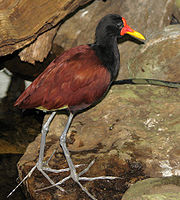
Charadriiformes
Charadriiformes is a diverse order of small to medium-large birds. It includes about 350 species and has members in all parts of the world. Most Charadriiformes live near water and eat invertebrates or other small animals; however, some are pelagic , some occupy deserts and a few are found in thick...
. Family: Jacanidae
The jacana
Jacana
The jaçanas are a group of tropical waders in the family Jacanidae. They are found worldwide within the tropical zone. See Etymology below for pronunciation....
s are a group of tropical waders in the family Jacanidae. They are found worldwide in the Tropics. They are identifiable by their huge feet and claws which enable them to walk on floating vegetation in the shallow lakes that are their preferred habitat. There 8 species worldwide and 2 species which occur in Panama.
- Northern JacanaNorthern JacanaThe Northern Jacana or Northern Jaçana is a wader which is a resident breeder from coastal Mexico to western Panama, and on Cuba, Jamaica and Hispaniola. It sometimes breeds in Texas, USA, and has also been recorded on several occasions as a vagrant in Arizona...
Jacana spinosa - Wattled JacanaWattled JacanaThe Wattled Jacana Jacana jacana is a wader which is a resident breeder from western Panama and Trinidad south through most of South America east of the Andes....
Jacana jacana
Oystercatchers
Order: CharadriiformesCharadriiformes
Charadriiformes is a diverse order of small to medium-large birds. It includes about 350 species and has members in all parts of the world. Most Charadriiformes live near water and eat invertebrates or other small animals; however, some are pelagic , some occupy deserts and a few are found in thick...
. Family: Haematopodidae
The oystercatcher
Oystercatcher
The oystercatchers are a group of waders; they form the family Haematopodidae, which has a single genus, Haematopus. They are found on coasts worldwide apart from the polar regions and some tropical regions of Africa and South East Asia...
s are large and noisy plover
Plover
Plovers are a widely distributed group of wading birds belonging to the subfamily Charadriinae. There are about 40 species in the subfamily, most of them called "plover" or "dotterel". The closely related lapwing subfamily, Vanellinae, comprises another 20-odd species.Plovers are found throughout...
-like birds, with strong bills used for smashing or prising open molluscs. There are 11 species worldwide and 1 species which occurs in Panama.
- American OystercatcherAmerican OystercatcherThe American Oystercatcher , occasionally called the American Pied Oystercatcher, is a member of family Haematopodidae. The bird is marked by its black and white body and a long, thick orange beak...
Haematopus palliatus
Avocets and stilts
Order: CharadriiformesCharadriiformes
Charadriiformes is a diverse order of small to medium-large birds. It includes about 350 species and has members in all parts of the world. Most Charadriiformes live near water and eat invertebrates or other small animals; however, some are pelagic , some occupy deserts and a few are found in thick...
. Family: Recurvirostridae
Recurvirostridae
Recurvirostridae is a family of birds in the wader suborder Charadrii. It contains two distinct groups of birds, the avocets and the stilts .-Description and diet:...
Recurvirostridae is a family of large wading birds, which includes the avocet
Avocet
The four species of Avocets are a genus, Recurvirostra, of waders in the same avian family as the stilts.Avocets have long legs and long, thin, upcurved bills which they sweep from side to side when feeding in the brackish or saline wetlands they prefer...
s and the stilt
Stilt
Stilt is a common name for several species of birds in the family Recurvirostridae, which also includes those known as avocets. They are found in brackish or saline wetlands in warm or hot climates....
s. The avocets have long legs and long up-curved bills. The stilts have extremely long legs and long, thin, straight bills. There are 9 species worldwide and 2 species which occur in Panama.
- Black-necked StiltBlack-necked StiltThe Black-necked Stilt is a locally abundant shorebird of American wetlands and coastlines. It is found from the coastal areas of California through much of the interior western United States and along the Gulf of Mexico as far east as Florida, then south through Central America and the Caribbean...
Himantopus mexicanus - American AvocetAmerican AvocetThe American Avocet is a large wader in the avocet and stilt family, Recurvirostridae.This avocet has long, thin, gray legs, giving it its colloquial name, "blue shanks". The plumage is black and white on the back with white on the underbelly. The neck and head are cinnamon colored in the summer...
Recurvirostra americana (A)
Plovers and lapwings
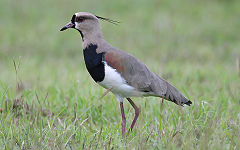
Charadriiformes
Charadriiformes is a diverse order of small to medium-large birds. It includes about 350 species and has members in all parts of the world. Most Charadriiformes live near water and eat invertebrates or other small animals; however, some are pelagic , some occupy deserts and a few are found in thick...
. Family: Charadriidae
Charadriidae
The bird family Charadriidae includes the plovers, dotterels, and lapwings, about 64 to 66 species in all.- Morphology :They are small to medium-sized birds with compact bodies, short, thick necks and long, usually pointed, wings, but most species of lapwing may have more rounded wings...
The family Charadriidae includes the plover
Plover
Plovers are a widely distributed group of wading birds belonging to the subfamily Charadriinae. There are about 40 species in the subfamily, most of them called "plover" or "dotterel". The closely related lapwing subfamily, Vanellinae, comprises another 20-odd species.Plovers are found throughout...
s, dotterels, and lapwing
Lapwing
Vanellinae are any of various crested plovers, family Charadriidae, noted for its slow, irregular wingbeat in flight and a shrill, wailing cry. Its length is 10-16 inches. They are a subfamily of medium-sized wading birds which also includes the plovers and dotterels. The Vanellinae are...
s. They are small to medium-sized birds with compact bodies, short, thick necks and long, usually pointed, wings. They are found in open country worldwide, mostly in habitats near water, although there are some exceptions. There are 66 species worldwide and 8 species which occur in Panama.
- Southern LapwingSouthern LapwingThe Southern Lapwing is a wader in the family Charadriiformes. It is a common and widespread resident throughout South America, except in densely forested regions , the higher parts of the Andes and the arid coast of a large part of western South America. This bird is particularly common in the...
Vanellus chilensis - American Golden-Plover Pluvialis dominica
- Black-bellied Plover Pluvialis squatarola
- Semipalmated PloverSemipalmated PloverThe Semipalmated Plover is a small plover.This species weighs and measures in length and across the wings. Adults have a grey-brown back and wings, a white belly, and a white breast with one black neckband...
Charadrius semipalmatus - Wilson's PloverWilson's PloverThe Wilson's Plover is a small plover.Wilson's Plover is a coastal wader which breeds on both coasts of the Americas from the equator northwards. Its range extends north to include much of the U.S. eastern seaboard, and the Pacific coast of Mexico on the west.It is a partial migrant. Birds leave...
Charadrius wilsonia - KilldeerKilldeerThe Killdeer is a medium-sized plover.Adults have a brown back and wings, a white belly, and a white breast with two black bands. The rump is tawny orange. The face and cap are brown with a white forehead. They have an orange-red eyering...
Charadrius vociferus - Snowy PloverSnowy PloverThe Snowy Plover is a small wader in the plover bird family. It breeds in Ecuador, Peru, Chile, the southern and western USA and the Caribbean...
Charadrius alexandrinus (A) - Collared PloverCollared PloverThe Collared Plover, Charadrius collaris, is a small shorebird in the plover family, Charadriidae. It lives along coasts and riverbanks of the tropical to temperate Americas, from central Mexico south to Chile and Argentina....
Charadrius collaris
Sandpipers and allies
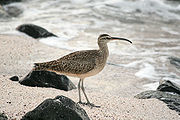

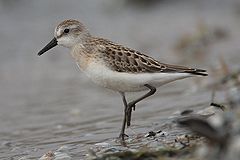
Charadriiformes
Charadriiformes is a diverse order of small to medium-large birds. It includes about 350 species and has members in all parts of the world. Most Charadriiformes live near water and eat invertebrates or other small animals; however, some are pelagic , some occupy deserts and a few are found in thick...
. Family: Scolopacidae
Scolopacidae
The sandpipers are a large family, Scolopacidae, of waders or shorebirds. They include many species called sandpipers, as well as those called by names such as curlew and snipe. The majority of these species eat small invertebrates picked out of the mud or soil...
The Scolopacidae are a large diverse family of small to medium sized shorebirds including the sandpipers, curlew
Curlew
The curlews , genus Numenius, are a group of eight species of birds, characterised by long, slender, downcurved bills and mottled brown plumage. They are one of the most ancient lineages of scolopacid waders, together with the godwits which look similar but have straight bills...
s, godwit
Godwit
The godwits are a group of large, long-billed, long-legged and strongly migratory wading birds of the genus Limosa. They form large flocks on coasts and estuaries in winter....
s, shanks
Tringa
Tringa is a genus of waders, containing the shanks and tattlers. They are mainly freshwater birds, often with brightly coloured legs as reflected in the English names of six species, as well as the specific names of two of these and the Green Sandpiper. They are typically associated with northern...
, tattlers
Tattler (bird)
The tattlers are the two very similar bird species in the shorebird genus Tringa. They formerly had their own genus, Heteroscelus. The old genus name means "different leg" in Greek, referring to the leg scales that differentiate the tattlers from their close relatives, the shanks.The species are:*...
, woodcock
Woodcock
The woodcocks are a group of seven or eight very similar living species of wading birds in the genus Scolopax. Only two woodcocks are widespread, the others being localized island endemics. Most are found in the Northern Hemisphere but a few range into Wallacea...
s, snipe
Snipe
A snipe is any of about 25 wading bird species in three genera in the family Scolopacidae. They are characterized by a very long, slender bill and crypsis plumage. The Gallinago snipes have a nearly worldwide distribution, the Lymnocryptes Jack Snipe is restricted to Asia and Europe and the...
s, dowitcher
Dowitcher
The three dowitchers are medium-sized long-billed wading birds. They resemble godwits in body and bill shape, and the reddish underparts in summer, but are much shorter legged, more like snipe to which they are also somewhat closer related...
s and phalarope
Phalarope
A phalarope or wadepiper is any of three living species of slender-necked shorebirds in the genus Phalaropus of the bird family Scolopacidae. They are close relatives of the shanks and tattlers, the Actitis and Terek Sandpipers, and also of the turnstones and calidrids...
s. The majority of species eat small invertebrates picked out of the mud or soil. Variation in length of legs and bills enable different species to feed in the same habitat, particularly on the coast, without direct competition for food. There are 89 species worldwide and 30 species which occur in Panama.
- Wilson's SnipeWilson's SnipeWilson's Snipe is a small, stocky shorebird. This species was formerly considered to be a subspecies of the Common Snipe, G. gallinago. Wilson's Snipe differs from the latter species in having a narrower white edge to the wings, and eight pairs of tail feathers instead of seven.Adults are...
Gallinago delicata - Short-billed DowitcherShort-billed DowitcherThe Short-billed Dowitcher like its congener the Long-billed Dowitcher, is a medium-sized, stocky, long-billed shorebird in the family Scolopacidae. It is an inhabitant of North America, Middle America, and northern South America. It is strongly migratory; it completely vacates in breeding areas...
Limnodromus griseus - Long-billed DowitcherLong-billed DowitcherThe Long-billed Dowitcher, Limnodromus scolopaceus, is a medium-sized shorebird.Adults have yellowish legs and a long straight dark bill. The body is dark brown on top and reddish underneath with spotted throat and breast, bars on flanks. The tail has a black and white barred pattern...
Limnodromus scolopaceus - Hudsonian GodwitHudsonian GodwitThe Hudsonian Godwit, Limosa haemastica, is a large shorebird.-Identification:Adults have long dark legs and a long pink bill with a slight upward curve and dark at the tip. The upper parts are mottled brown and the underparts are chestnut. The tail is black and the rump is white...
Limosa haemastica (A) - Marbled GodwitMarbled GodwitThe Marbled Godwit, Limosa fedoa, is a large shorebird. On average, it is the largest of the 4 species of godwit. The total length is , including a large bill of , and wingspan is . Body mass can vary from ....
Limosa fedoa - WhimbrelWhimbrelThe Whimbrel Numenius phaeopus, is a wader in the large family Scolopacidae. It is one of the mostwidespread of the curlews, breeding across much of subarctic North America, Europe and Asia as far south as Scotland....
Numenius phaeopus - Long-billed CurlewLong-billed CurlewThe Long-billed Curlew, Numenius americanus, is a large North American shorebird of the family Scolopacidae. This species was also called "sicklebird" and the "candlestick bird". The species is native to central and western North America...
Numenius americanus (A) - Upland SandpiperUpland SandpiperThe Upland Sandpiper is a large shorebird, closely related to the curlews . Older names are the Upland Plover and Bartram's Sandpiper. It is the only member of the genus Bartramia. The genus name and the old common name Bartram's Sandpiper commemorate the American naturalist William Bartram...
Bartramia longicauda - Greater YellowlegsGreater YellowlegsThe Greater Yellowlegs, Tringa melanoleuca, is a large North American shorebird, similar in appearance to the smaller Lesser Yellowlegs. Its closest relative, however, is the Greenshank, which together with the Spotted Redshank form a close-knit group...
Tringa melanoleuca - Lesser YellowlegsLesser YellowlegsThe Lesser Yellowlegs is a medium-sized shorebird similar in appearance to the larger Greater Yellowlegs. It is not closely related to this bird, however, but instead to the much larger and quite dissimilar Willet; merely the fine, clear and dense pattern of the neck shown in breeding plumage...
Tringa flavipes - Solitary SandpiperSolitary SandpiperThe Solitary Sandpiper is a small wader .-Description:This species measures long, with a wingspan up to and a body mass of . It is a dumpy wader with a dark green back, greyish head and breast and otherwise white underparts. It is obvious in flight, with wings dark above and below, and a dark...
Tringa solitaria - Spotted SandpiperSpotted SandpiperThe Spotted Sandpiper is a small shorebird, 18–20 cm long. Together with its sister species, the Common Sandpiper they make up the genus Actitis...
Actitis macularia - Wandering TattlerWandering TattlerThe Wandering Tattler, Tringa incana , is a medium-sized wading bird. It is similar in appearance to the closely related Gray-tailed Tattler, T. brevipes...
Heterosceles incanus (A) - WilletWilletThe Willet, Tringa semipalmata , is a large shorebird in the sandpiper family. It is a good-sized and stout scolopacid, the largest of the shanks...
Catoptrophorus semipalmatus - Ruddy TurnstoneRuddy TurnstoneThe Ruddy Turnstone is a small wading bird, one of two species of turnstone in the genus Arenaria. It is now classified in the sandpiper family Scolopacidae but was formerly sometimes placed in the plover family Charadriidae...
Arenaria interpres - SurfbirdSurfbirdThe Surfbird is a small stocky wader in the family Scolopacidae. It is usually classified in a genus of its own, as Aphriza virgata, and was once considered to be allied to the turnstones, but more recent data suggests it is very close genetically to the Red and Great Knots and should be included...
Aphriza virgata - Red KnotRed KnotThe Red Knot, Calidris canutus , is a medium sized shorebird which breeds in tundra and the Arctic Cordillera in the far north of Canada, Europe, and Russia. It is a large member of the Calidris sandpipers, second only to the Great Knot...
Calidris canutus - SanderlingSanderlingThe Sanderling is a small wader. It is a circumpolar Arctic breeder, and is a long-distance migrant, wintering south to South America, South Europe, Africa, and Australia...
Calidris alba - Semipalmated SandpiperSemipalmated SandpiperThe Semipalmated Sandpiper, Calidris pusilla, is a very small shorebird. It is sometimes separated with other "stints" in Erolia but although these apparently form a monophyletic group, the present species' old genus Ereunetes had been proposed before Erolia.Adults have black legs and a short stout...
Calidris pusilla - Western SandpiperWestern SandpiperThe Western Sandpiper, Calidris or Erolia mauri, is a small shorebird.Adults have dark legs and a short thin dark bill, thinner at the tip. The body is brown on top and white underneath. They are reddish-brown on the crown. This bird can be difficult to distinguish from other similar tiny...
Calidris mauri - Least SandpiperLeast SandpiperThe Least Sandpiper is the smallest shorebird.This species has greenish legs and a short thin dark bill. Breeding adults are brown with dark brown streaks on top and white underneath. They have a light line above the eye and a dark crown. In winter, Least Sandpipers are grey above...
Calidris minutilla - White-rumped SandpiperWhite-rumped SandpiperThe White-rumped Sandpiper is a small shorebird.Adults have black legs and a small thin dark bill. The body is dark brown on top and mainly white underneath, with brown streaks on the breast and a white rump. They have a white stripe over their eyes. This bird shows long wings in flight. In winter...
Calidris fuscicollis - Baird's SandpiperBaird's SandpiperThe Baird's Sandpiper is a small shorebird. It is among those calidrids sometimes separated in Erolia.Adults have black legs and a short thin dark bill. They are dark brown on top and mainly white underneath with a black patch on the rump. The head and breast are light brown with dark streaks. In...
Calidris bairdii - Pectoral SandpiperPectoral SandpiperThe Pectoral Sandpiper, Calidris melanotos, is a small wader. It is sometimes separated with the "stint" sandpipers in Erolia. This may or may not represent a good monophyletic group, depending on the placement of the phylogenetically enigmatic Curlew Sandpiper , the type species of Erolia...
Calidris melanotos - DunlinDunlinThe Dunlin, Calidris alpina, is a small wader, sometimes separated with the other "stints" in Erolia. It is a circumpolar breeder in Arctic or subarctic regions. Birds that breed in northern Europe and Asia are long-distance migrants, wintering south to Africa, southeast Asia and the Middle East...
Calidris alpina (A) - Stilt SandpiperStilt SandpiperThe Stilt Sandpiper, Calidris himantopus or Micropalama himantopus, is a small shorebird; it bears some resemblance to the smaller calidrid sandpipers or "stints". DNA sequence information is incapable of determining whether it should be placed in Calidris or in the monotypic genus Micropalama...
Calidris himantopus - Buff-breasted SandpiperBuff-breasted SandpiperThe Buff-breasted Sandpiper, Tryngites subruficollis, is a small shorebird. It is a calidrid sandpipers and currently considered to be the only member of the genus Tryngites. Indeed, it probably belongs in the genus Calidris itself, or more precisely with the small species thereof which should be...
Tryngites subruficollis - Ruff Philomachus pugnax (A)
- Wilson's PhalaropeWilson's PhalaropeThe Wilson's Phalarope, Phalaropus tricolor, is a small wader. This bird, the largest of the phalaropes, breeds in the prairies of North America in western Canada and the western United States. It is migratory, wintering around the central Andes in South America. They are passage migrants through...
Phalaropus tricolor - Red-necked PhalaropeRed-necked PhalaropeThe Red-necked Phalarope, Phalaropus lobatus, is a small wader. This phalarope breeds in the Arctic regions of North America and Eurasia. It is migratory, and, unusually for a wader, winters at sea on tropical oceans....
Phalaropus lobatus
Skuas and jaegers
Order: CharadriiformesCharadriiformes
Charadriiformes is a diverse order of small to medium-large birds. It includes about 350 species and has members in all parts of the world. Most Charadriiformes live near water and eat invertebrates or other small animals; however, some are pelagic , some occupy deserts and a few are found in thick...
. Family: Stercorariidae
The family Stercorariidae are, in general, medium to large birds, typically with grey or brown plumage, often with white markings on the wings. They nest on the ground in temperate and arctic regions and are long-distance migrants. There are 7 species worldwide and 4 species which occur in Panama.
- South Polar SkuaSouth Polar SkuaThe South Polar Skua, Stercorarius maccormicki, is a large seabird in the skua family Stercorariidae. An older name for the bird is MacCormick’s Skua, after explorer and naval surgeon Robert McCormick, who first collected the type specimen...
Stercorarius maccormicki - Pomarine Jaeger Stercorarius pomarinus
- Parasitic Jaeger Stercorarius parasiticus
- Long-tailed Jaeger Stercorarius longicaudus (A)
Gulls

Charadriiformes
Charadriiformes is a diverse order of small to medium-large birds. It includes about 350 species and has members in all parts of the world. Most Charadriiformes live near water and eat invertebrates or other small animals; however, some are pelagic , some occupy deserts and a few are found in thick...
. Family: Laridae
Laridae is a family of medium to large birds seabirds and includes gull
Gull
Gulls are birds in the family Laridae. They are most closely related to the terns and only distantly related to auks, skimmers, and more distantly to the waders...
s and kittiwake
Kittiwake
The kittiwakes are two closely related seabird species in the gull family Laridae, the Black-legged Kittiwake and the Red-legged Kittiwake . The epithets "Black-legged" and "Red-legged" are used to distinguish the two species in North America, but in Europe, where R...
s. They are typically grey or white, often with black markings on the head or wings. They have stout, longish bills and webbed feet. There are 55 species worldwide and 12 species which occur in Panama.
- Belcher's GullBelcher's GullThe Belcher's Gull , also known as the or Band-tailed Gull, is a gull found along the Pacific coast of South America. It formerly included the very similar Olrog's Gull as a subspecies. It is a medium-sized gull with a blackish mantle, white head and underparts, a black band in the otherwise white...
Larus belcheri (A) - Gray Gull Larus modestus (A)
- Ring-billed GullRing-billed GullThe Ring-billed Gull is a medium-sized gull.Adults are length and with a wingspan. The head, neck and underparts are white; the relatively short bill is yellow with a dark ring; the back and wings are silver gray; and the legs are yellow. The eyes are yellow with red rims...
Larus delawarensis - Kelp GullKelp GullThe Kelp Gull , also known as the Dominican Gull, breeds on coasts and islands through much of the southern hemisphere. The race L. d. vetula occurs around southern Africa, and nominate L. d...
Larus dominicanus (A) - Lesser Black-backed GullLesser Black-backed GullThe Lesser Black-backed Gull is a large gull that breeds on the Atlantic coasts of Europe. It is migratory, wintering from the British Isles south to West Africa...
Larus fuscus (A) - American Herring GullAmerican Herring GullThe American Herring Gull or Smithsonian Gull is a large gull which breeds in North America. It is often treated as a subspecies of the European Herring Gull but is now regarded as a separate species by some authorities.Adults are white with gray back and wings, black wingtips with white spots,...
Larus smithsonianus - Gray-headed Gull Larus cirrocephalus (A)
- Bonaparte's GullBonaparte's GullThe Bonaparte's Gull is a small gull.The Bonaparte's Gull is a small species, larger only than the Little Gull and the Saunders's Gull among all gull species. Adults are long with a wingspan and a body mass of . They have a black hood and a short thin dark bill. The body is mainly white with...
Larus philadelphia (A) - Laughing GullLaughing GullThe Laughing Gull, Leucophaeus atricilla, is a medium-sized gull of North and South America. It breeds on the Atlantic coast of North America, the Caribbean, and northern South America. Northernmost populations migrate further south in winter, and this species occurs as a rare vagrant to western...
Larus atricilla - Franklin's GullFranklin's GullThe Franklin's Gull is a small gull.-Description:It breeds in central provinces of Canada and adjacent states of the northern United States...
Larus pipixcan - Sabine's GullSabine's GullThe Sabine's Gull is a small gull. Its generic placement is disputed; some authors treat it as the sole species in the genus Xema as Xema sabini, while others retain it in the genus Larus as Larus sabini. It breeds in the arctic and has a circumpolar distribution through northernmost North America...
Xema sabini - Swallow-tailed GullSwallow-tailed GullThe Swallow-tailed Gull is an equatorial seabird in the gull family Laridae. It is the only species in the genus Creagrus, which derives from the Latin Creagra and the Greek kreourgos which means butcher, also from kreas, meat; according to Jobling it would mean "hook for meat" referring to the...
Creagrus furcatus (A)
Terns
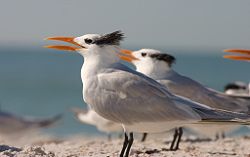
Charadriiformes
Charadriiformes is a diverse order of small to medium-large birds. It includes about 350 species and has members in all parts of the world. Most Charadriiformes live near water and eat invertebrates or other small animals; however, some are pelagic , some occupy deserts and a few are found in thick...
. Family: Sternidae
Tern
Tern
Terns are seabirds in the family Sternidae, previously considered a subfamily of the gull family Laridae . They form a lineage with the gulls and skimmers which in turn is related to skuas and auks...
s are a group of generally general medium to large sea-birds typically with grey or white plumage, often with black markings on the head. Most terns hunt fish by diving but some pick insects off the surface of fresh water. Terns are generally long-lived birds, with several species now known to live in excess of 25 to 30 years. There are 44 species worldwide and 18 species which occur in Panama.
- Gull-billed TernGull-billed TernThe Gull-billed Tern formerly Sterna nilotica , is a seabird of the tern family Sternidae...
Sterna nilotica - Caspian TernCaspian TernThe Caspian Tern is a species of tern, with a subcosmopolitan but scattered distribution. Despite its extensive range, it is monotypic of its genus, and has no subspecies accepted either...
Sterna caspia - Elegant TernElegant TernThe Elegant Tern is a seabird of the tern family Sternidae. It breeds on the Pacific coasts of the southern USA and Mexico and winters south to Peru, Ecuador and Chile....
Sterna elegans - Sandwich Tern Sterna sandvicensis
- Royal TernRoyal TernThe Royal Tern is a seabird in the tern family Sternidae. This bird has two distinctive subspecies. T. m. maximus breeds on the Atlantic and Pacific coasts of the southern USA and Mexico into the Caribbean. The slightly smaller T. m. albididorsalis breeds in coastal west Africa...
Sterna maxima - Arctic TernArctic TernThe Arctic Tern is a seabird of the tern family Sternidae. This bird has a circumpolar breeding distribution covering the Arctic and sub-Arctic regions of Europe, Asia, and North America...
Sterna paradisaea (A) - Common TernCommon TernThe Common Tern is a seabird of the tern family Sternidae. This bird has a circumpolar distribution, breeding in temperate and sub-Arctic regions of Europe, Asia and east and central North America. It is strongly migratory, wintering in coastal tropical and subtropical regions. It is sometimes...
Sterna hirundo - Forster's TernForster's TernThe Forster's Tern, Sterna forsteri, is a member of the tern family Sternidae. It breeds inland in North America and winters south to the Caribbean and northern South America....
Sterna forsteri (A) - Least Tern Sterna antillarum
- Yellow-billed TernYellow-billed TernThe Yellow-billed Tern is a species of tern in the Sternidae family.It is found in Argentina, Bolivia, Brazil, Colombia, Ecuador, French Guiana, Guyana, Panama, Paraguay, Peru, Suriname, Trinidad and Tobago, Uruguay, and Venezuela.Its natural habitats are rivers, swamps, and freshwater...
Sterna superciliaris (A) - Bridled TernBridled TernThe Bridled Tern is a seabird of the tern family Sternidae. It is a bird of the tropical oceans.-Description:...
Sterna anaethetus - Sooty TernSooty TernThe Sooty Tern, Onychoprion fuscatus , is a seabird of the tern family . It is a bird of the tropical oceans, breeding on islands throughout the equatorial zone. Colloquially, it is known as the Wideawake Tern or just wideawake...
Sterna fuscata - Black TernBlack TernThe Black Tern, Chlidonias niger, is a small tern generally found in or near inland water in Europe and North America. As its name suggests, it has predominantly dark plumage.- Description :...
Chlidonias niger - Large-billed TernLarge-billed TernThe Large-billed Tern is a species of tern in the Sternidae family. It belongs to the monotypic genus Phaetusa....
Phaetusa simplex (A) - Brown NoddyBrown NoddyThe Brown Noddy or Common Noddy is a seabird from the tern family. The largest of the noddies, it can be told from the closely related Black Noddy by its larger size and plumage, which is dark brown rather than black...
Anous stolidus - Black NoddyBlack NoddyThe Black Noddy or White-capped Noddy is a seabird from the tern family. It resembles the closely related Brown or Common Noddy , but is smaller with darker plumage, a whiter cap, a longer, straighter beak and shorter tail...
Anous minutus (A) - White TernWhite TernThe White Tern is a small seabird found across the tropical oceans of the world. It is sometimes known as the Fairy Tern although this name is potentially confusing as it is the common name of the Fairy Tern Sternula nereis...
Gygis alba (A) - Inca TernInca TernThe Inca Tern is a seabird in the family Sternidae. It is the only member of the genus Larosterna.This uniquely-plumaged bird breeds on the coasts of Peru and Chile, and is restricted to the Humboldt current...
Larosterna inca (A)
Skimmers
Order: CharadriiformesCharadriiformes
Charadriiformes is a diverse order of small to medium-large birds. It includes about 350 species and has members in all parts of the world. Most Charadriiformes live near water and eat invertebrates or other small animals; however, some are pelagic , some occupy deserts and a few are found in thick...
. Family: Rynchopidae
Skimmer
Skimmer
The Skimmers, Rynchopidae, are a small family of tern-like birds in the order Charadriiformes, which also includes the waders, gulls and auks. The family comprises three species found in South Asia, Africa, and the Americas....
s are a small family of tropical tern-like birds. They have an elongated lower mandible which they use to feed by flying low over the water surface and skimming the water for small fish. There are 3 species worldwide and 1 species which occurs in Panama.
- Black SkimmerBlack SkimmerThe Black Skimmer, Rynchops niger, is a tern-like seabird, one of three very similar birds species in the skimmer family. It breeds in North and South America...
Rynchops niger (A)
Pigeons and doves

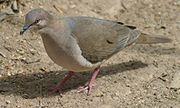
Columbiformes
Columbiformes are an avian order that includes the very widespread and successful doves and pigeons, classified in the family Columbidae, and the extinct Dodo and the Rodrigues Solitaire, long classified as a second family Raphidae. 313 species, found worldwide, comprise the Columbiformes order....
. Family: Columbidae
Pigeons and dove
Dove
Pigeons and doves constitute the bird family Columbidae within the order Columbiformes, which include some 300 species of near passerines. In general terms "dove" and "pigeon" are used somewhat interchangeably...
s are stout-bodied birds with short necks and short slender bills with a fleshy cere
Cère
The Cère is a long river in south-western France, left tributary of the Dordogne River. Its source is in the south-western Massif Central, near the mountain Plomb du Cantal...
. There are 308 species worldwide and 28 species which occur in Panama.
- Rock PigeonRock PigeonThe Rock Dove or Rock Pigeon, is a member of the bird family Columbidae . In common usage, this bird is often simply referred to as the "pigeon"....
Columba livia (I) - White-crowned PigeonWhite-crowned PigeonThe White-crowned Pigeon is a species of bird in the family Columbidae . It inhabits the northern and central Caribbean islands and some places on the North and Central American mainland...
Patagioenas leucocephala - Scaled PigeonScaled PigeonThe Scaled Pigeon, Patagioenas speciosa , is a large New World tropical dove. It is a resident breeder from southern Mexico south to western Ecuador, southern Brazil, northern Argentina, and Trinidad....
Patagioenas speciosa - Band-tailed PigeonBand-tailed PigeonThe Band-tailed Pigeon, Patagioenas fasciata, is a medium-sized bird of the Americas. Its closest relatives are the Chilean Pigeon and the Ring-tailed Pigeon, which form a clade of Patagioenas with a terminal tail band and iridescent plumage on their necks.It ranges from British Columbia, Utah, and...
Patagioenas fasciata - Pale-vented PigeonPale-vented PigeonThe Pale-vented Pigeon, Patagioenas cayennensis, is a large pigeon found in the tropical American. Formerly often placed in Columba, it actually belongs to a clade of the older New World genus Patagioenas. With its relatives it represents an evolutionary radiation extending through most of the...
Patagioenas cayennensis - Plumbeous PigeonPlumbeous PigeonThe Plumbeous Pigeon is a species of bird in the Columbidae family. It is found in Bolivia, Brazil, Colombia, Ecuador, French Guiana, Guyana, Panama, Paraguay, Peru, Suriname, and Venezuela....
Patagioenas plumbea - Short-billed PigeonShort-billed PigeonThe Short-billed Pigeon, Patagioenas nigrirostris , is a largish pigeon which breeds from southern Mexico south to northwestern Colombia...
Patagioenas nigrirostris - Ruddy PigeonRuddy PigeonThe Ruddy Pigeon, Patagioenas subvinacea, is a largish pigeon which breeds from Costa Rica south to western Ecuador, Bolivia and central Brazil. It belongs to a clade of small and rather plain species of Patagioenas with characteristic calls that constitute the subgenus Oenoenas...
Patagioenas subvinacea - Dusky PigeonDusky PigeonThe Dusky Pigeon is a species of bird in the Columbidae family.It is found in Colombia, Ecuador, and Panama.Its natural habitats are subtropical or tropical moist lowland forests and subtropical or tropical moist montanes....
Patagioenas goodsoni - Mourning DoveMourning DoveThe Mourning Dove is a member of the dove family . The bird is also called the Turtle Dove or the American Mourning Dove or Rain Dove, and formerly was known as the Carolina Pigeon or Carolina Turtledove. It is one of the most abundant and widespread of all North American birds...
Zenaida macroura - Eared DoveEared DoveThe Eared Dove, Zenaida auriculata, is a New World tropical dove. It is a resident breeder throughout South America from Colombia to southern Argentina and Chile, and on the offshore islands from the Grenadines southwards. It may be a relatively recent colonist of Tobago and Trinidad...
Zenaida auriculata (A) - White-winged DoveWhite-winged DoveThe White-winged Dove is a dove whose native range extends from the south-western USA through Mexico, Central America, and the Caribbean. In recent years with increasing urbanization and backyard feeding, it has expanded throughout Texas and into Louisiana...
Zenaida asiatica - Common Ground-Dove Columbina passerina
- Plain-breasted Ground-DovePlain-breasted Ground-doveThe Plain-breasted Ground Dove is a species of bird in the Columbidae family. They lack the scaled appearance to the feathers of the similar and typically more abundant Common Ground Dove...
Columbina minuta - Ruddy Ground-Dove Columbina talpacoti
- Blue Ground-Dove Claravis pretiosa
- Maroon-chested Ground-DoveMaroon-chested Ground-doveThe Maroon-chested Ground Dove is a species of bird in the Columbidae family. It is found in Bolivia, Colombia, Costa Rica, Ecuador, El Salvador, Guatemala, Honduras, Mexico, Panama, Peru, and Venezuela....
Claravis mondetoura - White-tipped DoveWhite-tipped DoveThe White-tipped Dove is a large New World tropical dove. It is a resident breeder from the southernmost Texas in the USA through Mexico and Central America south to western Peru and central Argentina. It also breeds on the offshore islands of northern South America, including Trinidad and Tobago...
Leptotila verreauxi - Gray-headed Dove Leptotila plumbeiceps
- Brown-backed DoveBrown-backed DoveThe Azuero Dove or Brown-backed Dove is a species of bird in the Columbidae family.It is endemic to Panama.Its natural habitats are subtropical or tropical moist lowland forests and subtropical or tropical swamps....
Leptotila battyi (E) - Gray-chested Dove Leptotila cassini
- Purplish-backed Quail-DovePurplish-backed Quail-doveThe Purplish-backed Quail-Dove is a species of bird in the Columbidae family.It is endemic to the highlands of Central America, more specifically those of Costa Rica and Panama...
Geotrygon lawrencii - Buff-fronted Quail-DoveBuff-fronted Quail-doveThe Buff-fronted Quail-Dove or Costa Rica Quail-Dove is a species of bird in the Columbidae family.It is found in Costa Rica and Panama.Its natural habitat is subtropical or tropical moist montanes.-References:...
Geotrygon costaricensis - Russet-crowned Quail-DoveRusset-crowned Quail-doveThe Russet-crowned Quail-Dove is a species of bird in the Columbidae family.It is found in Colombia and Panama.Its natural habitat is subtropical or tropical moist montanes.It is threatened by habitat loss.-References:...
Geotrygon goldmani - Rufous-breasted Quail-DoveRufous-breasted Quail-doveThe Chiriquí Quail-Dove or Rufous-breasted Quail-Dove is a species of bird in the Columbidae family.It is found in Costa Rica and Panama.Its natural habitat is subtropical or tropical moist montane forests.-References:...
Geotrygon chiriquensis - Olive-backed Quail-DoveOlive-backed Quail-doveThe Olive-backed Quail-Dove is a species of bird in the Columbidae family.It is found in Colombia, Costa Rica, Ecuador, Nicaragua, and Panama. Its natural habitat is lowland tropical and subtropical moist broadleaf forests....
Geotrygon veraguensis - Violaceous Quail-DoveViolaceous Quail-doveThe Violaceous Quail-Dove is a species of bird in the Columbidae family.It is found in Argentina, Bolivia, Brazil, Colombia, Costa Rica, Ecuador, Nicaragua, Panama, Paraguay, Peru, Suriname, and Venezuela....
Geotrygon violacea - Ruddy Quail-DoveRuddy Quail-DoveThe Ruddy Quail-Dove is a member of the bird family Columbidae, which includes doves and pigeons.It breeds throughout the West Indies, Central America, and tropical South America. It has appeared as a vagrant in Florida and southern Texas. It lays two buff colored eggs on a flimsy platform...
Geotrygon montana
Parrots, macaws and allies

Parrot
Parrot
Parrots, also known as psittacines , are birds of the roughly 372 species in 86 genera that make up the order Psittaciformes, found in most tropical and subtropical regions. The order is subdivided into three families: the Psittacidae , the Cacatuidae and the Strigopidae...
s are small to large birds with a characteristic curved beak shape. Their upper mandibles have slight mobility in the joint with the skull and the have a generally erect stance. All parrots are zygodactyl, having the four toes on each foot placed two at the front and two back. There are 335 species worldwide and 22 species which occur in Panama.
- Blue-and-yellow MacawBlue-and-yellow MacawThe Blue-and-Yellow Macaw , also known as the Blue-and-Gold Macaw, is a member of the group of large Neotropical parrots known as macaws. It breeds in forest and woodland of tropical South America from Trinidad and Venezuela south to Peru, Brazil, Bolivia, and Paraguay...
Ara ararauna - Great Green MacawGreat Green MacawThe Great Green Macaw, Ara ambiguus, also known as Buffon's Macaw or the Great Military Macaw, is a Central and South American parrot found in Nicaragua, Honduras, Costa Rica, Panama, Colombia and Ecuador. Two allopatric subspecies are recognized, the nominate subspecies is found in Central America...
Ara ambigua - Scarlet MacawScarlet MacawThe Scarlet Macaw is a large, colorful macaw. It is native to humid evergreen forests in the American tropics. Range extends from extreme south-eastern Mexico to Amazonian Peru, Bolivia and Brazil in lowlands up to up to...
Ara - Red-and-green MacawRed-and-green MacawThe Red-and-green Macaw , also known as the Green-winged Macaw, is a large mostly-red macaw of the Ara genus.This is the largest of the Ara genus, widespread in the forests and woodlands of northern and central South America...
Ara chloroptera - Chestnut-fronted MacawChestnut-fronted MacawThe Chestnut-fronted Macaw or Severe Macaw is one of the largest of the Mini-Macaws. It reaches a size of around of which around half is the length of the tail....
Ara severa - Crimson-fronted ParakeetCrimson-fronted ParakeetThe Finsch's Parakeet also called Finsch's Conure or Crimson-fronted Parakeet is a species of parrot in the Psittacidae family. It is found in Guatemala, El Salvador, Nicaragua, and some parts of Costa Rica and Panama....
Aratinga finschi - Brown-throated ParakeetBrown-throated ParakeetThe Brown-throated Parakeet , commonly known as the St. Thomas Conure or Brown-throated Conure in aviculture, is a species of parrot in the Psittacidae family...
Aratinga pertinax - Olive-throated ParakeetOlive-throated ParakeetThe Olive-throated Parakeet , also known as the Olive-throated Conure in aviculture, is a species of parrot in the Psittacidae family...
Aratinga nana - Azuero Parakeet Pyrrhura eisenmanni (E)
- Sulphur-winged ParakeetSulphur-winged ParakeetThe Sulphur-winged Parakeet , also known as the Hoffmann's Conure in aviculture, is a medium-small parrot endemic to humid highland forests and woodlands in Costa Rica and western Panama. It occurs up to 3000 m asl, and locally down to 1300 m in the wet season...
Pyrrhura hoffmanni - Barred ParakeetBarred ParakeetThe Barred Parakeet , also known as Lineolated Parakeet, Catherine Parakeet or 'Linnies' for short, is a small parrot found disjunctly in highland forests from southern Mexico to Panama, in the Andes from western Venezuela to southern Peru, the Santa Marta Mountains in Colombia and the Venezuelan...
Bolborhynchus lineola - Spectacled ParrotletSpectacled ParrotletThe Spectacled Parrotlet is a species of parrot in the Psittacidae family.It is found in Colombia, Panama, and Venezuela....
Forpus conspicillatus - Orange-chinned ParakeetOrange-chinned ParakeetThe Orange-chinned Parakeet , also known as the Tovi Parakeet, is a small mainly green parrot of the Brotogeris genus. It is found in Colombia, Costa Rica, El Salvador, Guatemala, Honduras, Mexico, Nicaragua, Panama, and Venezuela...
Brotogeris jugularis - Red-fronted ParrotletRed-fronted ParrotletThe Red-fronted Parrotlet, Touit costaricensis, is a parrot in Central America in Costa Rica and Panama. It is 15cm, green with a short tail, red forehead, lores, and under eye, red shoulders and leading edge of underwing, and the remaining underwing coverts yellow...
Touit costaricensis - Blue-fronted ParrotletBlue-fronted ParrotletThe Blue-fronted Parrotlet, Touit dilectissimus, is also known as the Red-winged Parrotlet . It is a parrot in N. South America from E. Panama down the west coastal Andes to Peru, with a second population around and south of Lake Maracaibo...
Touit dilectissima - Brown-hooded ParrotBrown-hooded ParrotThe Brown-hooded Parrot is a small parrot which is a resident breeding species from southeastern Mexico to north-western Colombia. Until recently, it was placed in the genus Pionopsitta, which now is restricted to the type species, the Pileated Parrot. It is sometimes considered conspecific with...
Pionopsitta haematotis - Saffron-headed ParrotSaffron-headed ParrotThe Saffron-headed Parrot is a species of parrot in the family Psittacidae. It was previously placed in the genus Pionopsitta, but moved out, as it is not as close to the type species Pionopsitta pileata as it was believed...
Pionopsitta pyrilia - Blue-headed ParrotBlue-headed ParrotThe Blue-headed Parrot, also known as the Blue-headed Pionus, Pionus menstruus, is a medium large parrot. It is about 27 cm long and they are mainly green with a blue head and neck, and red under tail feathers. It is a resident bird in tropical and subtropical South America and southern...
Pionus menstruus - White-crowned ParrotWhite-crowned ParrotThe White-crowned Parrot , also known as the White-crowned Pionus in aviculture, is a small parrot which is a resident breeding species from eastern Mexico to western Panama....
Pionus senilis - Red-lored Amazon Amazona autumnalis
- Yellow-crowned AmazonYellow-crowned AmazonThe Yellow-crowned Amazon or Yellow-crowned Parrot , is a species of parrot, native to the tropical South America and Panama. The taxonomy is highly complex, and the Yellow-headed and Yellow-naped Amazon are sometimes considered subspecies of the Yellow-crowned Amazon...
Amazona ochrocephala - Mealy Amazon Amazona farinosa
Cuckoos and anis
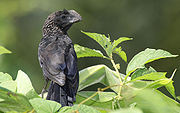
Cuculiformes
The near passerine bird order Cuculiformes traditionally included three families as below:* Musophagidae - turacos and allies* Cuculidae - cuckoos, coucals, roadrunners and anis* Opisthocomidae - Hoatzin...
. Family: Cuculidae
The family Cuculidae includes cuckoo
Cuckoo
The cuckoos are a family, Cuculidae, of near passerine birds. The order Cuculiformes, in addition to the cuckoos, also includes the turacos . Some zoologists and taxonomists have also included the unique Hoatzin in the Cuculiformes, but its taxonomy remains in dispute...
s, roadrunners
Geococcyx
The roadrunners are two species of bird in the genus Geococcyx of the cuckoo family, Cuculidae, native to North and Central America...
and anis
Ani (bird)
The anis are the three species of near-passerine birds in the genus Crotophaga of the cuckoo family. They are essentially tropical New world birds, although the range of two species just reaches the United States...
. These birds are of variable size with slender bodies, long tails and strong legs. Unlike the cuckoo species of the Old World, North American cuckoos are not brood parasites. There are 138 species worldwide and 14 species which occur in Panama.
- Dwarf CuckooDwarf CuckooThe Dwarf Cuckoo is a tropical American bird species of the cuckoo family .It was formerly placed in the genus Coccyzus or Micrococcyx. Following the discovery that it belongs to a distinct lineage around the Little Cuckoo, the genus Coccycua has been reinstated for these.It is found in Brazil,...
Coccyzus pumilus (A) - Black-billed CuckooBlack-billed CuckooThe Black-billed Cuckoo, Coccyzus erythropthalmus, is a cuckoo.Adults have a long brown tail and a black bill. The head and upper parts are brown and the underparts are white. There is a red ring around the eye. Juveniles are drabber, and the eye ring is greenish.Their breeding habitat is edges of...
Coccyzus erythropthalmus - Yellow-billed CuckooYellow-billed CuckooThe Yellow-billed Cuckoo, Coccyzus americanus, is a cuckoo. Common folk-names for this bird in the southern United States are Rain Crow and Storm Crow...
Coccyzus americanus - Mangrove CuckooMangrove CuckooThe Mangrove Cuckoo, Coccyzus minor, is a species of cuckoo that is native to the Neotropics.Adults have a long tail, brown above and black-and-white below, and a black curved bill with yellow on the lower mandible. The head and upper parts are brown. There is a yellow ring around the eye...
Coccyzus minor - Dark-billed CuckooDark-billed CuckooThe Dark-billed Cuckoo is a species of bird in the Cuculidae family, the cuckoos.It is found in Argentina, Bolivia, Brazil, Colombia, Ecuador, French Guiana, Guyana, Paraguay, Peru, Suriname, Trinidad and Tobago, Uruguay and Venezuela...
Coccyzus melacoryphus (A) - Gray-capped Cuckoo Coccyzus lansbergi (A)
- Squirrel CuckooSquirrel CuckooThe Squirrel Cuckoo, Piaya cayana, is a large and active species of cuckoo found in wooded habitats from northwestern Mexico to northern Argentina and Uruguay, and on Trinidad.-Description:...
Piaya cayana - Little CuckooLittle CuckooThe Little Cuckoo is a species of bird in the cuckoo family from South America and Panama. It was formerly placed in the genus Piaya but a monotypic genus Coccycua was once erected for it...
Piaya minuta - Greater AniGreater AniThe Greater Ani, Crotophaga major, is a large bird in the cuckoo family. It is a breeding species from Panama and Trinidad through tropical South America to northern Argentina. It is sometimes referred to as the Black cuckoo....
Crotophaga major - Smooth-billed AniSmooth-billed AniThe Smooth-billed Ani is a large near passerine bird in the cuckoo family. It is a resident breeding species from southern Florida, the Bahamas, the Caribbean, parts of Central America, south to western Ecuador, Brazil, and northern Argentina.This ani is found in open and semi-open country and...
Crotophaga ani - Groove-billed AniGroove-billed AniThe Groove-billed Ani, Crotophaga sulcirostris, is an odd-looking tropical bird in the cuckoo family with a long tail and a large, curved beak. It is a resident species throughout most of its range, from southern Texas and central Mexico through Central America, to northern Colombia and Venezuela,...
Crotophaga sulcirostris - Striped CuckooStriped CuckooThe Striped Cuckoo is a near-passerine bird, the only member of the genus Tapera. This resident cuckoo is found from Mexico and Trinidad south to Bolivia and Argentina....
Tapera naevia - Pheasant CuckooPheasant CuckooThe Pheasant Cuckoo is a species of cuckoo in the Cuculidae family.It is found in Argentina, Belize, Bolivia, Brazil, Colombia, Costa Rica, Ecuador, El Salvador, French Guiana, Guatemala, Guyana, Honduras, Mexico, Nicaragua, Panama, Paraguay, Peru, Suriname, and Venezuela.Its natural habitats are...
Dromococcyx phasianellus - Rufous-vented Ground-CuckooRufous-vented Ground-cuckooThe Rufous-vented Ground Cuckoo is a large terrestrial species of cuckoo in the Cuculidae family. It is found in humid primary forests from southern Nicaragua, through Costa Rica and Panama, into north-western Colombia...
Neomorphus geoffroyi
Barn owls
Order: Strigiformes. Family: TytonidaeTytonidae
Barn-owls are one of the two families of owls, the other being the true owls, Strigidae. They are medium to large sized owls with large heads and characteristic heart-shaped faces. They have long, strong legs with powerful talons...
Barn owl
Barn Owl
The Barn Owl is the most widely distributed species of owl, and one of the most widespread of all birds. It is also referred to as Common Barn Owl, to distinguish it from other species in the barn-owl family Tytonidae. These form one of two main lineages of living owls, the other being the typical...
s are medium to large sized owls with large heads and characteristic heart-shaped faces. They have long strong legs with powerful talons. There are 16 species worldwide and 1 species which occurs in Panama.
- Barn OwlBarn OwlThe Barn Owl is the most widely distributed species of owl, and one of the most widespread of all birds. It is also referred to as Common Barn Owl, to distinguish it from other species in the barn-owl family Tytonidae. These form one of two main lineages of living owls, the other being the typical...
Tyto alba
Typical owls
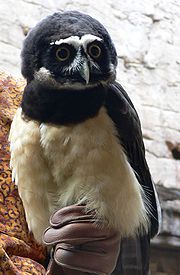
Typical owl
Typical owl
True owl or Typical owl are one of the two generally accepted families of Owls, the other being the barn owls . The Sibley-Ahlquist taxonomy unites the Caprimulgiformes with the owl order; here, the typical owls are a subfamily Strigidae...
s are small to large solitary nocturnal birds of prey. They have large forward-facing eyes and ears, a hawk-like beak, and a conspicuous circle of feathers around each eye called a facial disk. There are 195 species worldwide and 14 species which occur in Panama.
- Tropical Screech-OwlTropical Screech-owlThe Tropical Screech Owl is a small species of owl in the Strigidae family.-Range and habitat:It is found throughout South America , except in the Andes, the arid Pacific lowlands, and the far south. Its distribution also extends into southern Central America in Costa Rica and Panama...
Megascops choliba - Bare-shanked Screech-OwlBare-shanked Screech-owlThe Bare-shanked Screech Owl is a species of owl in the Strigidae family.It is found in Colombia, Costa Rica, and Panama.Its natural habitat is subtropical or tropical moist montanes.-References:...
Megascops clarkii - Vermiculated Screech-Owl Megascops vermiculatus
- Great Horned OwlGreat Horned OwlThe Great Horned Owl, , also known as the Tiger Owl, is a large owl native to the Americas. It is an adaptable bird with a vast range and is the most widely distributed true owl in the Americas.-Description:...
Bubo virginianus (A) - Mottled OwlMottled OwlThe Mottled Owl is a medium-sized owl found from Mexico to Brazil and Argentina. The body has vertical bars on the chest and throat and white markings in the back. The eyes are dark and the head is round and they do not have ear tufts.It is thirteen to fifteen inches in length...
Ciccaba virgata - Black-and-white OwlBlack-and-white OwlThe Black-and-white Owl is a species of owl in the Strigidae family.Compare with ITIS: It is found in Belize, Colombia, Costa Rica, Ecuador, El Salvador, Guatemala, Honduras, Mexico, Nicaragua, Panama, Peru, and Venezuela....
Ciccaba nigrolineata - Crested OwlCrested OwlThe Crested Owl is a species of owl in the family Strigidae. It is the only species , in the genus Lophostrix....
Lophostrix cristata - Spectacled OwlSpectacled OwlThe Spectacled Owl, Pulsatrix perspicillata, is a large tropical owl. It is a resident breeder from southern Mexico and Trinidad, through Central America, south to southern Brazil, Paraguay and northwestern Argentina...
Pulsatrix perspicillata - Costa Rican Pygmy-OwlCosta Rican Pygmy-owlThe Costa Rican Pygmy Owl is a species of owl in the Strigidae family.It is found in Costa Rica and Panama.-Range and Habitat:...
Glaucidium costaricanum - Central American Pygmy-OwlCentral American Pygmy-owlThe Central American Pygmy Owl is a species of owl in the Strigidae family.It is found in Belize, Colombia, Costa Rica, Ecuador, Guatemala, Honduras, Mexico, Nicaragua, and Panama....
Glaucidium griseiceps - Ferruginous Pygmy-Owl Glaucidium brasilianum
- Burrowing OwlBurrowing OwlThe Burrowing Owl is a tiny but long-legged owl found throughout open landscapes of North and South America. Burrowing Owls can be found in grasslands, rangelands, agricultural areas, deserts, or any other open dry area with low vegetation. They nest and roost in burrows, such as those excavated...
Athene cunicularia (A) - Unspotted Saw-whet OwlUnspotted Saw-whet OwlThe Unspotted Saw-whet Owl, Aegolius ridgwayi, is a small owl. It is a resident breeder in the highlands of Central America from southern Mexico south to western Panama, mainly above 2500 m. it has occasionally been considered conspecific with the Northern Saw-whet Owl...
Aegolius ridgwayi (A) - Striped OwlStriped OwlThe Striped Owl is a medium-sized owl with large ear tufts and a brownish-white facial disk rimmed with black. Its beak is black, and it has cinnamon-colored eyes. It has shorter, rounder wings than most of its close relatives. The upperparts are cinnamon with fine black vermiculation and heavy...
Pseudoscops clamator
Oilbird
Order: CaprimulgiformesCaprimulgiformes
The Caprimulgiformes is an order of birds that includes a number of birds with global distribution . They are generally insectivorous and nocturnal...
. Family: Steatornithidae
The Oilbird is a slim, long-winged bird related to the nightjars. It is nocturnal and a specialist feeder on the fruit of the Oil palm
Oil palm
The oil palms comprise two species of the Arecaceae, or palm family. They are used in commercial agriculture in the production of palm oil. The African Oil Palm Elaeis guineensis is native to West Africa, occurring between Angola and Gambia, while the American Oil Palm Elaeis oleifera is native to...
.
- OilbirdOilbirdThe Oilbird , also known as Guácharo, is a bird found in the northern areas of South America . They are nocturnal feeders on the fruits of the Oil Palm and tropical laurels, and are the only nocturnal fruit eating birds in the world...
Steatornis caripensis (A)
Potoos
Order: CaprimulgiformesCaprimulgiformes
The Caprimulgiformes is an order of birds that includes a number of birds with global distribution . They are generally insectivorous and nocturnal...
. Family: Nyctibiidae
The potoos (sometimes called Poor-Me-Ones) are large near passerine
Near passerine
Near passerine or higher land-bird assemblage are terms often given to arboreal birds or those most often believed to be related to the true passerines due to ecological similarities; the group corresponds to some extent with the Anomalogonatae of Garrod All near passerines are land birds...
birds related to the nightjars and frogmouths. They are nocturnal insectivores which lack the bristles around the mouth found in the true nightjars. There are 5 species, all of which are from the South American tropical region, and 2 species which occur in Panama.
- Great PotooGreat PotooThe Great Potoo is a bird, both the largest potoo species and the largest member of the order Caprimulgiformes . It occurs in tropical America.-Description:...
Nyctibius grandis - Common Potoo Nyctibius griseus
Nightjars
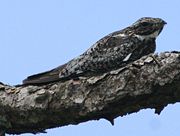
Caprimulgiformes
The Caprimulgiformes is an order of birds that includes a number of birds with global distribution . They are generally insectivorous and nocturnal...
. Family: Caprimulgidae
Nightjar
Nightjar
Nightjars are medium-sized nocturnal or crepuscular birds with long wings, short legs and very short bills. They are sometimes referred to as goatsuckers from the mistaken belief that they suck milk from goats . Some New World species are named as nighthawks...
s are medium-sized nocturnal birds with long wings, short legs and very short bills that usually nest on the ground. Most have small feet, of little use for walking, and long pointed wings. Their soft plumage is camouflaged to resemble bark or leaves. There are 86 species worldwide and 10 species which occur in Panama.
- Short-tailed NighthawkShort-tailed NighthawkThe Short-tailed Nighthawk is a species of nightjar in the Caprimulgidae family.-Distribution and habitat:...
Lurocalis semitorquatus - Lesser NighthawkLesser NighthawkThe Lesser Nighthawk, Chordeiles acutipennis, is a nightjar found throughout a large part of the Americas.The adults are dark with brown, grey and white patterning on the upperparts and breast; the long upperwings are black and show a white bar in flight. The tail is dark with white barring; the...
Chordeiles acutipennis - Common NighthawkCommon NighthawkThe Common Nighthawk is a medium-sized crepuscular or nocturnal bird, whose presence and identity are best revealed by its vocalization. Typically dark , displaying cryptic colouration and intricate patterns, this bird becomes invisible by day. Once aerial, with its buoyant but erratic flight,...
Chordeiles minor - PauraquePauraqueThe Pauraque – also called the Common Pauraque to distinguish it from similar species – is a nightjar species, the only bird in the genus Nyctidromus...
Nyctidromus albicollis - Ocellated PoorwillOcellated PoorwillThe Ocellated Poorwill is a species of nightjar in the Caprimulgidae family.It is found in Argentina, Bolivia, Brazil, Colombia, Costa Rica, Ecuador, Honduras, Nicaragua, Paraguay, and Peru....
Nyctiphrynus ocellatus (A) - Chuck-will's-widowChuck-will's-widowThe Chuck-will's-widow, Caprimulgus carolinensis is a nocturnal bird of the nightjar family Caprimulgidae. It is found in the southeastern United States near swamps, rocky uplands, and pine woods...
Caprimulgus carolinensis - Rufous NightjarRufous NightjarThe Rufous Nightjar is a species of nightjar in the Caprimulgidae family.It is found in Argentina, Bolivia, Brazil, Colombia, Costa Rica, Ecuador, French Guiana, Guyana, Panama, Paraguay, Peru, Saint Lucia, Suriname, Trinidad and Tobago, and Venezuela.Its natural habitats are subtropical or...
Caprimulgus rufus - Whip-poor-willWhip-poor-willThe Eastern Whip-poor-will, Caprimulgus vociferus, is a medium-sized nightjar from North and Central America. The whip-poor-will is commonly heard within its range, but less often seen because of its superior camouflage...
Caprimulgus vociferus (A) - Dusky NightjarDusky NightjarThe Dusky Nightjar is a species of nightjar in the Caprimulgidae family.It is found in Costa Rica and Panama.Its natural habitats are subtropical or tropical moist montanes and heavily degraded former forest.-References:...
Caprimulgus saturatus - White-tailed NightjarWhite-tailed NightjarThe White-tailed Nightjar is a species of nightjar in the Caprimulgidae family.It is found in Aruba, Barbados, Brazil, Colombia, Costa Rica, Ecuador, French Guiana, Guyana, Martinique, Netherlands Antilles, Panama, Suriname, Trinidad and Tobago and Venezuela.Its natural habitats are subtropical or...
Caprimulgus cayennensis
Swifts
Order: ApodiformesApodiformes
Traditionally, the bird order Apodiformes contained three living families: the swifts , the tree swifts , and the hummingbirds . In the Sibley-Ahlquist taxonomy, this order is raised to a superorder Apodimorphae in which hummingbirds are separated as a new order, Trochiliformes...
. Family: Apodidae
Swift
Swift
The swifts are a family, Apodidae, of highly aerial birds. They are superficially similar to swallows, but are actually not closely related to passerine species at all; swifts are in the separate order Apodiformes, which they share with hummingbirds...
s are small aerial birds, spending the majority of their lives flying. These birds have very short legs and never settle voluntarily on the ground, perching instead only on vertical surfaces. Many swifts have long swept-back wings that resemble a crescent or a boomerang. There are 98 species worldwide and 13 species which occur in Panama.
- Black SwiftBlack SwiftThe American Black Swift or more simply Black Swift is found from northern British Columbia in Canada through the United States and Mexico to Costa Rica. It is also found on islands in the West Indies....
Cypseloides niger (A) - White-chinned SwiftWhite-chinned SwiftThe White-chinned Swift is a species of swift in the Apodidae family.It is found in Belize, Colombia, Costa Rica, Ecuador, Guyana, Honduras, Mexico, Nicaragua, Panama, Peru, and Venezuela....
Cypseloides cryptus (A) - Chestnut-collared SwiftChestnut-collared SwiftThe Chestnut-collared Swift, Streptoprocne rutila, is a resident breeding bird from Mexico and Trinidad south to Peru and Bolivia. It was one of the species of Cypseloides controversially moved to Streptoprocne by the AOU ....
Streptoprocne rutila - White-collared SwiftWhite-collared SwiftThe White-collared Swift, Streptoprocne zonaris, is a resident breeding bird from central Mexico, the Greater Antilles and Trinidad south to Peru, northern Argentina and southeastern Brazil....
Streptoprocne zonaris - Band-rumped SwiftBand-rumped SwiftThe Band-rumped Swift, Chaetura spinicaudus, is a small swift.This species breeds in forested areas from Costa Rica south and east to Colombia, Ecuador, Venezuela, the Guianas, Trinidad and northeast Brazil...
Chaetura spinicaudus - Gray-rumped SwiftGray-rumped SwiftThe Grey-rumped Swift, Chaetura cinereiventris, is a small swift.This species breeds in hill forests from Nicaragua south to Peru, Brazil and northern Argentina, and Grenada, Trinidad and Tobago. The nest is a half saucer of twigs glued to the inside of a tree hole, chimney or similar shaded...
Chaetura cinereiventris - Chimney SwiftChimney SwiftThe Chimney Swift is a small bird .-Physical description:In flight, this bird looks like a flying cigar with long slender curved wings. The plumage is a sooty grey-brown; the throat, breast, underwings and rump are paler. They have short tails.-Reproduction:The breeding season of Chimney Swifts is...
Chaetura pelagica - Vaux's SwiftVaux's SwiftVaux's Swift is a small swift native to North America and northern South America. It was named for the American scientist William Sansom Vaux.-Description:...
Chaetura vauxi - Chapman's SwiftChapman's SwiftThe Chapman's Swift is a species of swift in the Apodidae family.It is found in Brazil, Colombia, French Guiana, Guyana, Panama, Suriname, Trinidad and Tobago, and Venezuela....
Chaetura chapmani (A) - Short-tailed SwiftShort-tailed SwiftThe Short-tailed Swift is a bird in the Apodidae, or swift family.-Taxonomy:The subspecies C. b. ocypetes is sometimes considered a full species, the Tumbes Swift Chaetura ocypetes Zimmer, 1953....
Chaetura brachyura - Ashy-tailed SwiftSick's SwiftThe Sick's Swift is a species of swift in the Apodidae family. It was previously considered conspecific with the smaller Ashy-tailed Swift, but Marín found that Sick's Swift was closer to the Chimney Swift....
Chaetura andrei (A) - Lesser Swallow-tailed SwiftLesser Swallow-tailed SwiftThe Lesser Swallow-tailed Swift or Cayenne Swift, Panyptila cayennensis, is a resident breeding bird from southern Mexico and Tobago south to Ecuador, eastern Peru and Brazil....
Panyptila cayennensis - Costa Rican SwiftCosta Rican SwiftThe Costa Rican Swift is a species of swift in the Apodidae family.It is found in Colombia, Costa Rica, and Panama.Its natural habitat is subtropical or tropical moist lowland forests....
Chaetura fumosa
Hummingbirds
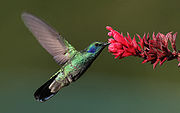
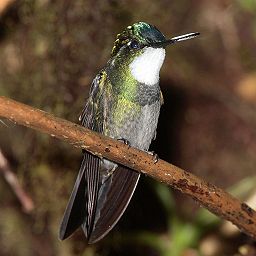

Hummingbird
Hummingbird
Hummingbirds are birds that comprise the family Trochilidae. They are among the smallest of birds, most species measuring in the 7.5–13 cm range. Indeed, the smallest extant bird species is a hummingbird, the 5-cm Bee Hummingbird. They can hover in mid-air by rapidly flapping their wings...
s are small birds capable of hovering in mid-air due to the rapid flapping of their wings. They are the only birds that can fly backwards. There are 337 species worldwide and 59 species which occur in Panama.
- White-tipped SicklebillWhite-tipped SicklebillThe White-tipped Sicklebill is a species of hummingbird in the Trochilidae family.It is found in Costa Rica and Panama of Central America, and Colombia, Ecuador, and far northern Peru. There is also a single recent record from Mérida in Venezuela.Its natural habitat is the undergrowth of...
Eutoxeres aquila - Rufous-breasted HermitRufous-breasted HermitThe Rufous-breasted Hermit or Hairy Hermit is a hummingbird that breeds from Panama south to Bolivia, and on Trinidad, Tobago and Grenada. It is a widespread and generally common species, though local populations may change in numbers and disappear altogether in marginal habitat-Description:It...
Glaucis hirsuta - Bronzy HermitBronzy HermitThe Bronzy Hermit is a species of hummingbird in the Trochilidae family. It is found in forests and thickets from eastern Honduras south to western Panama, and in the Chocó of western Colombia and north-western Ecuador. It closely resembles the larger Rufous-breasted Hermit.-References:*A Guide to...
Glaucis aenea - Band-tailed BarbthroatBand-tailed BarbthroatThe Band-tailed Barbthroat is a medium-sized hummingbird which is a resident breeder from southeastern Guatemala and Belize to western Ecuador and western Venezuela....
Threnetes ruckeri - White-whiskered HermitWhite-whiskered HermitThe White-whiskered Hermit, Phaethornis yaruqui, is a hummingbird that is found in Colombia and Ecuador....
Phaethornis yaruqui - Green HermitGreen HermitThe Green Hermit is a large hummingbird that is a resident breeder from southern Central America south to northwestern South America It is 5.3 in long and weighs 0.22 oz . The male Green Hermit is mainly dark green with a blue-green rump...
Phaethornis guy - Western Long-tailed Hermit Phaethornis longirostris
- Pale-bellied HermitPale-bellied HermitThe Pale-bellied Hermit is a species of hummingbird in the Trochilidae family.It is found in Colombia, Panama, and Venezuela. Its natural habitats are subtropical or tropical moist lowland forests and heavily degraded former forest.-References:* BirdLife International 2004. . Downloaded on 10...
Phaethornis anthophilus - Stripe-throated HermitStripe-throated HermitThe Stripe-throated Hermit is a species of hummingbird from Central America and north-western South America. It is generally fairly common and considered Least Concern by BirdLife International....
Phaethornis striigularis - Tooth-billed HummingbirdTooth-billed HummingbirdThe Tooth-billed Hummingbird is a species of bird from the family Trochilidae. It is monotypic within the genus Androdon. It is found in humid forests in western Colombia, north-western Ecuador , and far eastern Panama...
Androdon aequatorialis - Green-fronted LancebillGreen-fronted LancebillThe Green-fronted Lancebill is a species of hummingbird in the Trochilidae family.It is found in Bolivia, Colombia, Costa Rica, Ecuador, Panama, Peru, and Venezuela...
Doryfera ludovicae - Scaly-breasted HummingbirdScaly-breasted HummingbirdThe Scaly-breasted Hummingbird is a species of hummingbird in the Trochilidae family. It is monotypic for its genus.-Distribution and habitat:...
Phaeochroa cuvierii - Violet SabrewingViolet SabrewingThe Violet Sabrewing, Campylopterus hemileucurus,is a very large hummingbird native to southern Mexico and Central America as far south as Costa Rica and western Panama....
Campylopterus hemileucurus - White-necked JacobinWhite-necked JacobinThe White-necked Jacobin is a large and attractive hummingbird that ranges from Mexico south to Peru, Bolivia and south Brazil...
Florisuga mellivora - Brown Violet-earBrown Violet-earThe Brown Violetear is a large hummingbird that breeds at middle elevations in the mountains in Central America, and western and northern South America with isolated populations on Trinidad and in the Brazilian state Bahia.The breeding habitat is forest at altitudes between 400-1600 m, but the...
Colibri delphinae - Green Violet-earGreen Violet-ear- Introduction :The Green Violetear is a medium-sized, metallic green hummingbird species commonly found in forested areas from Mexico to northern South America.- Taxonomy :...
Colibri thalassinus - Green-breasted MangoGreen-breasted MangoThe Green-breasted Mango is a hummingbird from tropical America. The scientific name of this bird commemorates the French naturalist Florent Prévost.- Description :...
Anthracothorax prevostii - Black-throated MangoBlack-throated MangoThe Black-throated Mango is a mainly South American hummingbird species.-Description:It is 10.2 cm long and weighs 7.2g. The longish black bill is slightly decurved. The tail in both sexes has dark central feathers, the outer tail being wine-red tipped with black.The male has glossy bright...
Anthracothorax nigricollis - Veraguan MangoVeraguan MangoThe Veraguan Mango is a species of hummingbird in the Trochilidae family.It is found in Panama and recently in Costa Rica ....
Anthracothorax veraguensis (E) - Ruby-topaz HummingbirdRuby-topaz HummingbirdThe Ruby-topaz Hummingbird , commonly referred to simply as the Ruby Topaz, is a small bird that breeds in the Lesser Antilles and tropical northern South America from Colombia, Venezuela and the Guyanas, south to central Brazil and northern Bolivia; also from Colombia into southern Panama. It is...
Chrysolampis mosquitus (A) - Violet-headed HummingbirdViolet-headed HummingbirdThe Violet-headed Hummingbird is a species of hummingbird in the Trochilidae family. It is monotypic of the genus, Klais.It is found in Bolivia, Brazil, Colombia, Costa Rica, Ecuador, Honduras, Nicaragua, Panama, Peru, and Venezuela...
Klais guimeti - Rufous-crested CoquetteRufous-crested CoquetteThe Rufous-Crested Coquette is a species of hummingbird in the Trochilidae family.It is found in Bolivia, Colombia, Costa Rica, Ecuador, Panama, and Peru. Its natural habitats are subtropical or tropical moist lowland forests, subtropical or tropical moist montane forests, and heavily degraded...
Lophornis delattrei - White-crested CoquetteWhite-crested CoquetteThe White-crested Coquette is a species of hummingbird in the Trochilidae family.It is found in Costa Rica and Panama.Its natural habitats are subtropical or tropical moist lowland forests and heavily degraded former forest....
Lophornis adorabilis - Green ThorntailGreen ThorntailThe Green Thorntail is a small hummingbird that is a resident breeder from Costa Rica to western Ecuador. It occurs at middle elevations from 700-1400 m but may descend lower early in the wet season. In Costa Rica and Panama it is confined to the Caribbean slopes.This is a forest canopy species...
Discosura conversii - Garden EmeraldGarden EmeraldThe Garden Emerald is a small hummingbird that is an endemic resident breeder in Costa Rica and western Panama. It was formerly considered to be a subspecies of the Blue-tailed Emerald....
Chlorostilbon assimilis - Fiery-throated HummingbirdFiery-throated HummingbirdThe Fiery-throated Hummingbird is a medium-sized hummingbird which breeds only in the mountains of Costa Rica and western Panama...
Panterpe insignis - White-tailed EmeraldWhite-tailed EmeraldThe White-Tailed Emerald is a species of hummingbird in the Trochilidae family.It is found in Costa Rica and Panama....
Elvira chionura - Stripe-tailed HummingbirdStripe-tailed HummingbirdThe Stripe-tailed Hummingbird is a species of hummingbird endemic to subtropical moist forests and adjacent clearings of Middle America, from the Gulf slope of southeastern Mexico to Panama....
Eupherusa eximia - Black-bellied HummingbirdBlack-bellied HummingbirdThe Black-bellied Hummingbird is a species of hummingbird in the Trochilidae family.It is found in moist forest and edge at middle elevations on the Caribbean slope in Costa Rica and Panama-References:...
Eupherusa nigriventris - Rufous-cheeked HummingbirdRufous-cheeked HummingbirdThe Pirre Hummingbird , also somewhat misleadingly known as the Rufous-cheeked Hummingbird, is a species of hummingbird in the Trochilidae family. It is the only species in its genus....
Goethalsia bella - Violet-capped HummingbirdViolet-capped HummingbirdThe Violet-capped Hummingbird is a species of hummingbird in the Trochilidae family. It is found in Colombia and Panama.Its natural habitat is subtropical or tropical moist lowland forests.-References:...
Goldmania violiceps - Violet-crowned WoodnymphViolet-crowned WoodnymphThe Violet-crowned Woodnymph , also known as the Purple-crowned Woodnymph, is a medium-sized hummingbird found from Guatemala and Belize to northern Colombia and western Venezuela. It formerly included the Mexican and Green-crowned Woodnymphs as subspecies...
Thalurania colombica - Green-crowned WoodnymphGreen-crowned WoodnymphThe Green-crowned Woodnymph is a species of hummingbird in the Trochilidae family. It is found in humid forest and tall second growth from eastern Panama, south through western Colombia and Ecuador, to far north-western Peru...
Thalurania fannyi - Violet-bellied HummingbirdViolet-bellied HummingbirdThe Violet-bellied Hummingbird is a species of hummingbird in the Trochilidae family. It is monotypical for genus Damophila.It is found in Colombia, Ecuador, Panama, and Peru; it can occasionally be seen in Costa Rica....
Damophila julie - Sapphire-throated HummingbirdSapphire-throated HummingbirdThe Sapphire-Throated Hummingbird is a species of hummingbird in the Trochilidae family.It is found in Colombia, Costa Rica, and Panama....
Lepidopyga coeruleogularis - Blue-throated GoldentailBlue-throated GoldentailThe Blue-throated Sapphire , also known as the Blue-Throated Goldentail, is a species of hummingbird in the Trochilidae family. It is found in Belize, Colombia, Costa Rica, El Salvador, Guatemala, Honduras, Mexico, Nicaragua, and Panama...
Hylocharis eliciae - Humboldt's SapphireHumboldt's SapphireThe Humboldt's Sapphire is a species of hummingbird in the Trochilidae family.It is found in Colombia, Ecuador, and Panama.Its natural habitat is subtropical or tropical mangrove forests.-References:...
Hylocharis humboldtii - Rufous-tailed HummingbirdRufous-tailed HummingbirdThe Rufous-tailed Hummingbird is a medium-sized hummingbird that breeds from east-central Mexico, through Central America and Colombia, east to western Venezuela and south through western Ecuador to near the border with Peru...
Amazilia tzacatl - Escudo HummingbirdEscudo HummingbirdThe Escudo Hummingbird is a hummingbird in the subfamily Trochilinae. It was long considered a doubtfully distinct species, but more recently it is generally treated as a subspecies of the Rufous-tailed Hummingbird, A. tzacatl.It is endemic to Isla Escudo de Veraguas in Panama...
Amazilia handleyi (E) - Blue-chested HummingbirdBlue-chested HummingbirdThe Blue-Chested Hummingbird is a species of hummingbird in the Trochilidae family.It is found in Colombia, Costa Rica, Ecuador, Nicaragua, and Panama....
Polyerata amabilis - Charming HummingbirdCharming HummingbirdThe Charming Hummingbird is a species of hummingbird in the Trochilidae family.It is found in Costa Rica and Panama.Its natural habitats are subtropical or tropical moist lowland forests and heavily degraded former forest....
Polyerata decora - Snowy-bellied Hummingbird Saucerottia edward
- SnowcapSnowcapThe Snowcap is a small hummingbird which is a resident breeder in Honduras, Nicaragua, Costa Rica and western Panama. It is the only member of the genus Microchera....
Microchera albocoronata - White-vented PlumeleteerWhite-vented PlumeleteerThe White-vented Plumeleteer is a species of hummingbird in the Trochilidae family.It is found in Colombia, Ecuador, Panama, Peru, and Venezuela....
Chalybura buffonii - Bronze-tailed Plumeleteer Chalybura urochrysia
- White-bellied Mountain-gemWhite-bellied Mountain-gemThe White-bellied Mountaingem is a species of hummingbird in the Trochilidae family. It is found in Costa Rica and Panama.Its natural habitat is subtropical or tropical moist montanes.-References:...
Lampornis hemileucus - White-throated Mountain-gemWhite-throated Mountain-gemThe White-throated Mountaingem is a hummingbird which breeds in the mountains of western Panama. It is replaced in southern Costa Rica by a distinct subspecies, the Gray-tailed Mountaingem, L. castaneoventris cinereicauda, which is very close to becoming a distinct species...
Lampornis castaneoventris - Purple-throated Mountain-gemPurple-throated Mountain-gemThe Purple-throated Mountaingem is a hummingbird which breeds in the mountains of southern Nicaragua, northern Costa Rica and western Panama...
Lampornis calolaema - Green-crowned BrilliantGreen-crowned BrilliantThe Green-crowned Brilliant is a large robust hummingbird that is a resident breeder in the highlands from Costa Rica to western Ecuador.This hummingbird inhabits wet mountain forests including edges, gaps and tall second growth...
Heliodoxa jacula - Magnificent HummingbirdMagnificent HummingbirdThe Magnificent Hummingbird is a large hummingbird that breeds in mountains from the southwestern United States to western Panama. It is the only member of the genus Eugenes, although the northern, nominate subspecies E. fulgens fulgens has on occasion been separated from the larger, southern race...
Eugenes fulgens - Greenish PufflegGreenish PufflegThe Greenish Puffleg is a species of hummingbird in the Trochilidae family.It is found in Colombia, Ecuador, and Panama....
Haplophaedia aureliae - Purple-crowned FairyPurple-crowned FairyThe Purple-crowned Fairy is a large hummingbird that breeds in the lowlands and hills from southeastern Mexico south to southwestern Ecuador....
Heliothryx barroti - Long-billed StarthroatLong-billed StarthroatThe Long-billed Starthroat, Heliomaster longirostris, is a hummingbird that breeds from southern Mexico to Panama, from Colombia south and east to Bolivia and Brazil, and on Trinidad...
Heliomaster longirostris - Magenta-throated WoodstarMagenta-throated WoodstarThe Magenta-throated Woodstar is an attractive hummingbird that is a resident breeder in forest edge and scrub in Costa Rica and western Panama. Its nest is undescribed....
Calliphlox bryantae - Purple-throated WoodstarPurple-throated WoodstarThe Purple-throated Woodstar, Calliphlox mitchellii, is a species of hummingbird, and it is one of the four Calliphlox genera, the woodstars. The species is found in Colombia and Ecuador, and a minor localized population in Panama, 600 km from its main species distribution.- External links :* on...
Calliphlox mitchellii - Ruby-throated HummingbirdRuby-throated HummingbirdThe Ruby-throated Hummingbird , is a small hummingbird. It is the only species of hummingbird that regularly nests east of the Mississippi River in North America.- Description :...
Archilochus colubris (A) - Scintillant HummingbirdScintillant HummingbirdThe Scintillant Hummingbird is the smallest hummingbird within its range, which includes only the mountains of Costa Rica and western Panama....
Selasphorus scintilla - Glow-throated HummingbirdGlow-throated HummingbirdThe Glow-Throated Hummingbird, Colibri Ardent, or ColibrÍ Ardiente is a species of hummingbird in the Trochilidae family.It is found only in Panama....
Selasphorus ardens (E) - Volcano HummingbirdVolcano HummingbirdThe Volcano Hummingbird is a very small hummingbird which breeds only in the mountains of Costa Rica and Chiriqui, Panama....
Selasphorus flammula
Trogons and quetzals
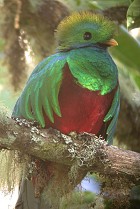
The family Trogonidae includes trogons and quetzals. Found in tropical woodlands worldwide, they feed on insects and fruit, and their broad bills and weak legs reflect their diet and arboreal habits. Although their flight is fast, they are reluctant to fly any distance. Trogons have soft, often colourful, feathers with distinctive male and female plumage. There are 33 species worldwide and 11 species which occur in Panama.
- White-tailed TrogonWhite-tailed TrogonThe White-tailed Trogon , also known as the Western White-tailed Trogon, is a near passerine bird in the trogon family. It is found in tropical humid forests of the Chocó, ranging from Panama, through western Colombia, to western Ecuador. It was formerly considered a subspecies of T...
Trogon viridis - Baird's TrogonBaird's TrogonThe Baird's Trogon is a species of bird in the Trogonidae family.It is found in Costa Rica and Panama.Its natural habitat is subtropical or tropical moist lowland forests.It is threatened by habitat loss.-References:...
Trogon bairdii - Violaceous TrogonViolaceous TrogonThe Violaceous Trogon , also known as the Guianan Trogon, is a near passerine bird in the trogon family, Trogonidae. It is found in humid forests in the Amazon Basin of South America and on the island of Trinidad, although some authorities have argued for treating the west Amazonian population as...
Trogon violaceus - Collared TrogonCollared TrogonThe Collared Trogon, Trogon collaris, is a near passerine bird in the trogon family, Trogonidae. It is found in the warmer parts of the Neotropics, and includes numerous subspecies, including T. c...
Trogon collaris - Orange-bellied TrogonOrange-bellied TrogonThe Orange-bellied Trogon is a species of bird in the Trogonidae family. It has been considered a morph of the Collared Trogon, but most maintain its status as a separate species...
Trogon aurantiiventris - Black-throated TrogonBlack-throated TrogonThe Black-throated Trogon, Trogon rufus, is a near passerine bird in the trogon family, Trogonidae. It is also called "Yellow-bellied Trogon", but as it is not the only trogon with a yellow belly this should be avoided...
Trogon rufus - Black-tailed TrogonBlack-tailed TrogonThe Black-tailed Trogon, Trogon melanurus, is a species of bird in the Trogonidae family. It is found in humid forest in the Amazon Basin, north-western South America and adjacent Panama...
Trogon melanurus - Slaty-tailed TrogonSlaty-tailed TrogonThe Slaty-tailed Trogon, Trogon massena, is a near passerine bird in the trogon family, Trogonidae. It breeds in lowlands from southeastern Mexico south through Central America, to Colombia, and a small region of northwestern Ecuador....
Trogon massena - Lattice-tailed TrogonLattice-tailed TrogonThe Lattice-tailed Trogon is a species of bird in the Trogonidae family.It is found in Costa Rica and Panama.Its natural habitat is subtropical or tropical moist lowland forests.-References:...
Trogon clathratus - Resplendent QuetzalResplendent QuetzalThe Resplendent Quetzal, Pharomachrus mocinno, is a bird in the trogon family. It is found from southern Mexico to western Panama . It is well known for its colorful plumage. There are two subspecies, P. m. mocinno and P. m...
Pharomachrus mocinno - Golden-headed QuetzalGolden-headed QuetzalThe Golden-Headed Quetzal is a colorful bird native to highlands forests in South America.- Description :Males and females are approximately the same size, having a total length of ca. 35 cm and a weight of 160 g. as adults. Adult males are iridescent green with a golden cast to their heads,...
Pharomachrus auriceps
Kingfishers
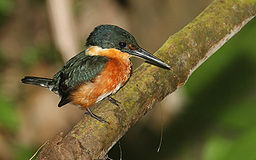
Coraciiformes
The Coraciiformes are a group of usually colorful near passerine birds including the kingfishers, the Hoopoe, the bee-eaters, the rollers, and the hornbills...
. Family: Alcedinidae
Kingfishers are medium-sized birds with large heads, long pointed bills, short legs, and stubby tails. There are 93 species worldwide and 6 species which occur in Panama.
- Belted KingfisherBelted KingfisherThe Belted Kingfisher is a large, conspicuous water kingfisher, the only member of that group commonly found in the northern United States and Canada. It is depicted on the 1986 series Canadian $5 note. All kingfishers were formerly placed in one family, Alcedinidae, but recent research suggests...
Ceryle alcyon - Ringed KingfisherRinged KingfisherThe Ringed Kingfisher is a large, conspicuous and noisy kingfisher, commonly found along the lower Rio Grande River valley in southeasternmost Texas in the United States through Central America to Tierra del Fuego in South America....
Ceryle torquatus - Amazon KingfisherAmazon KingfisherThe Amazon Kingfisher, Chloroceryle amazona, is a resident breeding bird in the lowlands of the American tropics from southern Mexico south through Central America to northern Argentina, with at least one bird having strayed north to Texas. Records from Trinidad are thought to be erroneous.This...
Chloroceryle amazona - Green KingfisherGreen KingfisherThe Green Kingfisher, Chloroceryle americana, is a resident breeding bird which occurs from southern Texas in the USA south through Central and South Americal to central Argentina....
Chloroceryle americana - Green-and-rufous KingfisherGreen-and-rufous KingfisherThe Green-and-rufous Kingfisher, Chloroceryle inda, is a resident breeding bird in the lowlands of the American tropics from southeastern Nicaragua south to southern Brazil.-Description:...
Chloroceryle inda - American Pygmy KingfisherAmerican Pygmy KingfisherThe American Pygmy Kingfisher, Chloroceryle aenea, is a resident breeding bird which occurs in the American tropics from southern Mexico south through Central America to western Ecuador, and then around the northern Andes cordillera in the east to central Bolivia and central Brazil...
Chloroceryle aenea
Motmots
Order: CoraciiformesCoraciiformes
The Coraciiformes are a group of usually colorful near passerine birds including the kingfishers, the Hoopoe, the bee-eaters, the rollers, and the hornbills...
. Family: Momotidae

- Tody MotmotTody MotmotThe Tody Motmot is a species of bird in the Momotidae family. It is monotypic within the genus Hylomanes.It is found in Belize, Colombia, Costa Rica, El Salvador, Guatemala, Honduras, Mexico, Nicaragua, and Panama....
Hylomanes momotula - Blue-crowned MotmotBlue-crowned MotmotThe Blue-crowned Motmot, Momotus momota, is a colourful near-passerine bird found in forests and woodlands of eastern Mexico, Central America, northern and central South America, and Trinidad and Tobago...
Momotus momota - Rufous MotmotRufous MotmotThe Rufous Motmot, Baryphthengus martii, is a near-passerine bird which is a resident breeder in rain forests from northeastern Honduras south to western Ecuador, northeastern Bolivia, and southwestern Brazil....
Baryphthengus martii - Broad-billed MotmotBroad-billed MotmotThe Broad-billed Motmot is a species of bird in the Momotidae family.It is found in Bolivia, Brazil, Colombia, Costa Rica, Ecuador, Honduras, Nicaragua, Panama, and Peru. Its natural habitats are subtropical or tropical moist lowland forests and heavily degraded former forest.-References:*...
Electron platyrhynchum
Jacamars
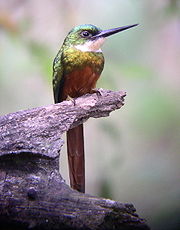
Piciformes
Nine families of largely arboreal birds make up the order Piciformes, the best-known of them being the Picidae, which includes the woodpeckers and close relatives...
. Family: Galbulidae
The jacamars are near passerine birds from tropical South America, with a range that extends up to Mexico. They are glossy elegant birds with long bills and tails, which feed on insects caught on the wing. In appearance and behaviour they show resemblances to the Old World bee-eater
Bee-eater
The bee-eaters are a group of near-passerine birds in the family Meropidae. Most species are found in Africa and Asia but others occur in southern Europe, Australia, and New Guinea. They are characterised by richly coloured plumage, slender bodies, and usually elongated central tail feathers...
s, although they are more closely related to woodpeckers. There are 18 species and 3 species that occur in Panama.
- Dusky-backed JacamarDusky-backed JacamarThe Dusky-backed Jacamar is a species of bird in the Galbulidae family.It is found in Colombia and Panama. Its natural habitats are subtropical or tropical moist lowland forests and heavily degraded former forest....
Brachygalba salmoni - Rufous-tailed JacamarRufous-tailed JacamarThe Rufous-tailed Jacamar, Galbula ruficauda, is a near-passerine bird which breeds in the tropical New World in southern Mexico, Central America and South America as far south as southern Brazil and Ecuador....
Galbula ruficauda - Great JacamarGreat JacamarThe Great Jacamar is a species of bird in the Galbulidae family. It is placed in the monotypic genus Jacamerops....
Jacamerops aureus
Puffbirds

Piciformes
Nine families of largely arboreal birds make up the order Piciformes, the best-known of them being the Picidae, which includes the woodpeckers and close relatives...
. Family: Bucconidae
The puffbirds are related to the jacamars, and have the same range, but lack the iridescent colours of that family. They are mainly brown, rufous or grey, with large heads and flattened bills with a hooked tip. The loose abundant plumage and short tails makes them look stout and puffy, giving rise to the English common name of the family. There are 34 species and 8 species which occur in Panama.
- White-necked PuffbirdWhite-necked PuffbirdThe White-necked Puffbird is a species of puffbird in the Bucconidae family.It is found in forest and woodland from southern Mexico, through Central America, to the Chocó, northern Colombia , northern Venezuela, and the western and southern Amazon Basin.It was formerly considered a subspecies of N...
Notharchus macrorhynchos - Black-breasted PuffbirdBlack-breasted PuffbirdThe Black-breasted Puffbird is a species of puffbird in the Bucconidae family.It is found in Colombia, Ecuador, and Panama. Its natural habitats are subtropical or tropical moist lowland forests and heavily degraded former forest.-References:* BirdLife International 2004. . Downloaded on 24...
Notharchus pectoralis - Pied PuffbirdPied PuffbirdThe Pied Puffbird is a species of puffbird in the Bucconidae family.It is found in Bolivia, Brazil, Colombia, Costa Rica, Ecuador, French Guiana, Guyana, Panama, Peru, Suriname, and Venezuela....
Notharchus tectus - Barred PuffbirdBarred PuffbirdThe Barred Puffbird is a species of puffbird in the Bucconidae family. It occurs in forests in the Tumbes-Chocó-Magdalena of Panama, Colombia and Ecuador.-References:...
Nystalus radiatus - White-whiskered PuffbirdWhite-whiskered PuffbirdThe White-whiskered Puffbird is a bird which is a resident breeding species from southeastern Mexico to central Ecuador. It is sometimes known as White-whiskered Softwing....
Malacoptila panamensis - Lanceolated MonkletLanceolated MonkletThe Lanceolated Monklet is a species of bird in the Bucconidae family, the puffbirds. It is the only member of the genus Micromonacha.It is found in Bolivia, Brazil, Colombia, Costa Rica, Ecuador, Panama, and Peru...
Micromonacha lanceolata - Gray-cheeked Nunlet Nonnula frontalis
- White-fronted NunbirdWhite-fronted NunbirdThe White-fronted Nunbird is a species of near passerine bird in the puffbird family . It is found in the tropical Americas....
Monasa morphoeus
Barbets
Order: PiciformesPiciformes
Nine families of largely arboreal birds make up the order Piciformes, the best-known of them being the Picidae, which includes the woodpeckers and close relatives...
. Family: Capitonidae
The barbets are plump birds, with short necks and large heads. They get their name from the bristles which fringe their heavy bills. Most species are brightly coloured. There are 84 species worldwide and 3 species which occur in Panama.
- Spot-crowned BarbetSpot-crowned BarbetThe Spot-crowned Barbet is a species of bird in the Capitonidae family.It is found in Colombia and Panama.Its natural habitats are subtropical or tropical moist lowland forests and heavily degraded former forest....
Capito maculicoronatus - Red-headed BarbetRed-headed BarbetThe Red-headed Barbet is a species of bird in the Capitonidae family. It is found in humid highland forest in Costa Rica and Panama, as well as the Andes in western Venezuela, Colombia, Ecuador and far northern Peru. The diet of the Red-headed Barbet may include bananas and various other...
Eubucco bourcierii - Prong-billed BarbetProng-billed BarbetThe Prong-billed Barbet is a distinctive, relatively large-billed bird native to humid highland forest in Costa Rica and western Panama.It often has been placed with the other barbets in the Capitonidae...
Semnornis frantzii
Toucans
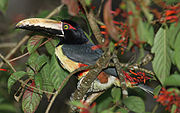
Piciformes
Nine families of largely arboreal birds make up the order Piciformes, the best-known of them being the Picidae, which includes the woodpeckers and close relatives...
. Family: Ramphastidae
Toucans are near passerine birds from the neotropics. They are brightly marked and have enormous, colourful bills which in some species may amount to half their body length. There are 40 species worldwide and 8 species which occur in Panama.
- Collared AracariCollared AracariThe Collared Aracari, Pteroglossus torquatus, is a toucan, a near-passerine bird which breeds from southern Mexico to Panama; also Ecuador, Colombia and Venezuela.-Description:...
Pteroglossus torquatus - Fiery-billed AracariFiery-billed AracariThe Fiery-billed Aracari, Pteroglossus frantzii, is a toucan, a near-passerine bird which breeds only on the Pacific slopes of southern Costa Rica and western Panama. The binomial commemorates the German naturalist Alexander von Frantzius.-Description:...
Pteroglossus frantzii - Yellow-eared ToucanetYellow-eared ToucanetThe Yellow-eared Toucanet is a species of bird in the Ramphastidae family. It is found in humid forests in Central America and the Chocó...
Selenidera spectabilis - Keel-billed ToucanKeel-billed ToucanThe Keel-billed Toucan , also known as Sulfur-breasted Toucan or Rainbow-billed Toucan, is a colorful Latin American member of the toucan family. It is the national bird of Belize.- Description :...
Ramphastos sulfuratus - Choco ToucanChoco ToucanThe Choco Toucan is a large, mainly black bird found in humid lowland and foothill forests on the Pacific slope of Colombia and Ecuador...
Ramphastos brevis - Chestnut-mandibled ToucanChestnut-mandibled ToucanThe Chestnut-mandibled Toucan, or Swainson’s Toucan is a near-passerine bird which breeds from eastern Honduras to northern Colombia to western Ecuador. This subspecies is replaced from southern Colombia to eastern Peru by the nominate subspecies Black-mandibled Toucan, R. ambiguus ambiguus...
Ramphastos swainsonii - Blue-throated ToucanetBlue-throated ToucanetThe Blue-throated Toucanet, Aulacorhynchus caeruleogularis, is a near-passerine bird living in the mountain forests of Costa Rica and western Panama...
Aulacorhynchus caeruleogularis - Violet-throated Toucanet Aulacorhynchus cognatus
Woodpeckers and allies
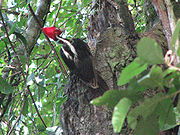
Piciformes
Nine families of largely arboreal birds make up the order Piciformes, the best-known of them being the Picidae, which includes the woodpeckers and close relatives...
. Family: Picidae
Picidae
The woodpeckers, piculets and wrynecks are a family, Picidae, of near-passerine birds. Members of this family are found worldwide, except for Australia and New Zealand, Madagascar, and the extreme polar regions...
Woodpeckers are small to medium sized birds with chisel like beaks, short legs, stiff tails and long tongues used for capturing insects. Some species have feet with two toes pointing forward, and two backward, while several species have only three toes. Many woodpeckers have the habit of tapping noisily on tree trunks with their beaks. There are 218 species worldwide and 20 species which occur in Panama.
- Olivaceous PiculetOlivaceous PiculetThe Olivaceous Piculet is a species of bird in the Picidae family. Etymologically, piculet is as a double diminutive of the Latin picus woodpecker, see also Picus...
Picumnus olivaceus - Acorn WoodpeckerAcorn WoodpeckerThe Acorn woodpecker is a medium-sized woodpecker, 21 cm long with an average weight of 85 g.-Description:...
Melanerpes formicivorus - Golden-naped WoodpeckerGolden-naped WoodpeckerThe Golden-naped Woodpecker is a species of bird in the Picidae family.It is found in Costa Rica and Panama.Its natural habitats are subtropical or tropical moist lowland forests and heavily degraded former forest....
Melanerpes chrysauchen - Black-cheeked WoodpeckerBlack-cheeked WoodpeckerThe Black-cheeked Woodpecker, Melanerpes pucherani, is a resident breeding bird from southeastern Mexico south to western Ecuador.This woodpecker occurs in the higher levels of wet forests, semi-open woodland and old second growth. It nests in an unlined hole 6–30 m high in a dead tree. The clutch...
Melanerpes pucherani - Red-crowned WoodpeckerRed-crowned WoodpeckerThe Red-crowned Woodpecker, Melanerpes rubricapillus, is a resident breeding bird from southwestern Costa Rica south to Colombia, Venezuela, the Guianas and Tobago....
Melanerpes rubricapillus - Yellow-bellied SapsuckerYellow-bellied SapsuckerThe Yellow-bellied Sapsucker is a medium-sized woodpecker found in North America, Central America and the Caribbean.-Taxonomy:...
Sphyrapicus varius - Hairy WoodpeckerHairy WoodpeckerThe Hairy Woodpecker is a medium-sized woodpecker, averaging approximately 250 mm in length with a 380 mm wingspan...
Picoides villosus - Smoky-brown WoodpeckerSmoky-brown WoodpeckerThe Smoky-brown Woodpecker or Brown Woodpecker is a species of bird in the Picidae family.It is found in Argentina, Belize, Bolivia, Colombia, Costa Rica, Ecuador, El Salvador, Guatemala, Honduras, Mexico, Nicaragua, Panama, Peru, and Venezuela.-Habitat:Its natural habitats are subtropical or...
Veniliornis fumigatus - Red-rumped WoodpeckerRed-rumped WoodpeckerThe Red-rumped Woodpecker, Veniliornis kirkii, is a resident breeding bird from Costa Rica south and east to Ecuador, Venezuela, Trinidad and Tobago....
Veniliornis kirkii - Rufous-winged WoodpeckerRufous-winged WoodpeckerThe Rufous-winged Woodpecker is a species of bird in the Picidae family.It is found in Costa Rica, Honduras, Nicaragua, and Panama.Its natural habitat is subtropical or tropical moist lowland forests.-References:...
Piculus simplex - Stripe-cheeked WoodpeckerStripe-cheeked WoodpeckerThe Stripe-cheeked Woodpecker, Piculus callopterus, is a species of woodpecker endemic to Panama. The males are an orangish-brown above with an olive barred yellowish rump, an olive chest and throat with white spots, and dull yellow underparts. Their crown, nape, and moustachial region is a bright...
Piculus callopterus (E) - Golden-green WoodpeckerGolden-green WoodpeckerThe Golden-green Woodpecker is a species of bird in the Picidae family, the woodpeckers, piculets, and wrynecks....
Piculus chrysochloros - Golden-olive WoodpeckerGolden-olive WoodpeckerThe Golden-olive Woodpecker, Colaptes rubiginosus, is a resident breeding bird from Mexico south and east to Guyana, northwest Argentina, Trinidad and Tobago. It was formerly placed in the genus Piculus...
Piculus rubiginosus - Spot-breasted WoodpeckerSpot-breasted WoodpeckerThe Spot-breasted Woodpecker is a species of bird in the Picidae family.It is found in South America in Bolivia, Brazil, Colombia, Ecuador, French Guiana, Peru, Suriname, and Venezuela; also eastern Panama of Central America....
Colaptes punctigula - Cinnamon WoodpeckerCinnamon WoodpeckerThe Cinnamon Woodpecker is a species of bird in the Picidae family.It is found in Colombia, Costa Rica, Ecuador, Nicaragua, and Panama. Its natural habitat is subtropical or tropical moist lowland forests.-References:...
Celeus loricatus - Chestnut-colored Woodpecker Celeus castaneus
- Lineated WoodpeckerLineated WoodpeckerThe Lineated Woodpecker is a very large woodpecker which is a resident breeding bird from Mexico south to northern Argentina and on Trinidad.-Description:The Lineated Woodpecker is long...
Dryocopus lineatus - Crimson-bellied WoodpeckerCrimson-bellied WoodpeckerThe Crimson-bellied Woodpecker is a species of bird in the Picidae family.It is found in Colombia, Ecuador, Panama, and Peru....
Campephilus haematogaster - Crimson-crested WoodpeckerCrimson-crested WoodpeckerThe Crimson-crested Woodpecker is a very large woodpecker which is a resident breeding bird from Panama south to northern border regions of Argentina, and on Trinidad....
Campephilus melanoleucos - Pale-billed WoodpeckerPale-billed WoodpeckerThe Pale-billed Woodpecker is a very large woodpecker that is a resident breeding bird from northern Mexico to western Panama.-Habitat:...
Campephilus guatemalensis
Ovenbirds
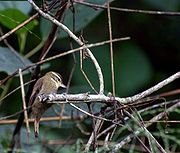
Ovenbirds comprise a large family of small sub-oscine passerine bird species found in Central and South America. They are a diverse group of insectivores which gets its name from the elaborate "oven-like" clay nests built by some species, although others build stick nests or nest in tunnels or clefts in rock. There are 243 species worldwide and 23 species which occur in Panama.
- Pale-breasted SpinetailPale-breasted SpinetailThe Pale-breasted Spinetail , is a passerine bird which breeds in the tropical New World from Costa Rica to central Argentina, and in Trinidad....
Synallaxis albescens - Slaty SpinetailSlaty SpinetailThe Slaty Spinetail or Slaty Castlebuilder, , is a passerine bird which breeds in the tropical New World from northern Honduras to western Ecuador and east-central Brazil....
Synallaxis brachyura - Red-faced SpinetailRed-faced SpinetailThe Red-faced Spinetail is a species of bird in the Furnariidae family.It is found in Colombia, Costa Rica, Ecuador, and Panama.Its natural habitat is subtropical or tropical moist montanes....
Cranioleuca erythrops - Coiba SpinetailCoiba SpinetailThe Coiba Spinetail, Cranioleuca dissita, is a Furnariid endemic to Coiba Island, Panama. This primarily arboreal species is fairly common within its range. Despite this, it may be considered vulnerable due to its small range...
Cranioleuca dissita (E) - Double-banded Graytail Xenerpestes minlosi
- Spotted BarbtailSpotted BarbtailThe Spotted Barbtail is a species of bird in the Furnariidae family. It is found in Bolivia, Colombia, Costa Rica, Ecuador, Panama, Peru, and Venezuela.Its natural habitat is subtropical or tropical moist montane forests....
Premnoplex brunnescens - Ruddy TreerunnerRuddy TreerunnerThe Ruddy Treerunner , is a passerine bird which is endemic to the highlands of Costa Rica and western Panama.This treerunner is found in hills and mountains from 1200 m up to the timberline, in forests and adjacent edges and clearings. It builds a large enclosed oval nest 25 m high in...
Margarornis rubiginosus - Beautiful TreerunnerBeautiful TreerunnerThe Beautiful Treerunner is a species of bird in the Furnariidae family.It is endemic to Panama.Its natural habitat is subtropical or tropical moist montanes.It is threatened by habitat loss.-References:...
Margarornis bellulus (E) - Plain XenopsPlain XenopsThe Plain Xenops, Xenops minutus, is a passerine bird which breeds in moist lowland forests in the tropical New World from southern Mexico south to western Ecuador, northeastern Argentina and central Brazil....
Xenops minutus - Streaked XenopsStreaked XenopsThe Streaked Xenops, Xenops rutilans, is a passerine bird which breeds in the tropical New World from Costa Rica and Trinidad south to Bolivia and northern Argentina...
Xenops rutilans - Scaly-throated Foliage-gleanerScaly-throated Foliage-gleanerThe Scaly-throated Foliage-gleaner is a species of bird in the Furnariidae family.It is found in Belize, Colombia, Costa Rica, Ecuador, El Salvador, Guatemala, Honduras, Mexico, and Panama....
Anabacerthia variegaticeps - Buffy TuftedcheekBuffy TuftedcheekThe Buffy Tuftedcheek or Lawrence’s Tuftedcheek, Pseudocolaptes lawrencii, is a passerine bird in the ovenbird family, which breeds in the tropical New World in Costa Rica, western Panama and the Andes of Colombia and Ecuador. It is sometimes considered conspecific with the Streaked Tuftedcheek, P....
Pseudocolaptes lawrencii - Streak-breasted TreehunterStreak-breasted TreehunterThe Streak-breasted Treehunter , is a passerine bird which is endemic to the highlands of Costa Rica and western Panama....
Thripadectes rufobrunneus - Lineated Foliage-gleanerLineated Foliage-gleanerThe Lineated Foliage-gleaner is a species of bird in the Furnariidae family.It is found in Colombia, Costa Rica, Ecuador, Panama, Peru, and Venezuela. Its natural habitat is subtropical or tropical moist montane forests....
Syndactyla subalaris - Striped WoodhaunterStriped WoodhaunterThe Striped Woodhaunter is a species of bird in the Furnariidae family. It is the only member of the genus Hyloctistes.It is found in Bolivia, Brazil, Colombia, Costa Rica, Ecuador, Nicaragua, Panama, Peru, and Venezuela...
Hyloctistes subulatus - Buff-fronted Foliage-gleanerBuff-fronted Foliage-gleanerThe Buff-fronted Foliage-gleaner is a species of bird in the Furnariidae family, the ovenbirds. It is found in southeastern regions of South America in the cerrado and pantanal of Brazil and Paraguay as well as areas of southeast coastal Brazil; also extreme northeast Argentina...
Philydor rufus - Slaty-winged Foliage-gleanerSlaty-winged Foliage-gleanerThe Slaty-winged Foliage-gleaner is a perching bird species in the ovenbird family .It is found in Colombia, Ecuador, and Panama. Its natural habitats are subtropical or tropical moist lowland forests and subtropical or tropical moist montane forests.-References:* BirdLife International 2004. . ...
Philydor fuscipennis - Buff-throated Foliage-gleanerBuff-throated Foliage-gleanerThe Buff-throated Foliage-gleaner is a species of bird in the Furnariidae family.It is found in Belize, Bolivia, Brazil, Colombia, Costa Rica, Ecuador, French Guiana, Guatemala, Guyana, Honduras, Mexico, Nicaragua, Panama, Peru, Suriname, and Venezuela...
Automolus ochrolaemus - Ruddy Foliage-gleanerRuddy Foliage-gleanerThe Ruddy Foliage-gleaner is a species of bird in the Furnariidae family. Its range is highly disjunct, with populations in the highlands of Mexico and Central America, and lowlands and foothills in the Chocó, eastern Andes, and western and north-eastern Amazon Basin. It is found in forest...
Automolus rubiginosus - Tawny-throated LeaftosserTawny-throated LeaftosserThe Tawny-throated Leaftosser is a tropical American bird species in the ovenbird family Furnariidae. It is also known as the Tawny-throated Leafscraper, Mexican Leaftosser or Mexican Leafscraper...
Sclerurus mexicanus - Gray-throated Leaftosser Sclerurus albigularis
- Scaly-throated LeaftosserScaly-throated LeaftosserThe Scaly-throated Leaftosser is a species of bird in the Furnariidae family.It is found in Belize, Colombia, Costa Rica, Ecuador, Guatemala, Honduras, Mexico, Nicaragua, and Panama. Its natural habitats are subtropical or tropical moist lowland forests and subtropical or tropical moist montane...
Sclerurus guatemalensis - Sharp-tailed StreamcreeperSharp-tailed StreamcreeperThe Sharp-tailed Streamcreeper is a passerine bird of South America belonging to the family Furnariidae, the ovenbirds. It is the only member of the genus Lochmias. The species is also known as the Streamside Streamcreeper.-Description:This bird is about 6 in long, with a short tail and a...
Lochmias nematura
Woodcreepers

The Dendrocolaptidae are brownish birds and maintain an upright vertical posture, supported by their stiff tail vanes. They feed mainly on insects taken from tree trunks. There are 57 species worldwide and 17 species which occur in Panama.
- Tawny-winged WoodcreeperTawny-winged WoodcreeperThe Tawny-winged Woodcreeper is a species of bird in the Dendrocolaptinae subfamily, New World woodcreepers.It is found in Belize, Costa Rica, Guatemala, Honduras, Mexico, Nicaragua, and Panama....
Dendrocincla anabatina - Plain-brown WoodcreeperPlain-brown WoodcreeperThe Plain-brown Woodcreeper , is a sub-oscine passerine bird which breeds in the tropical New World from Honduras through South America to northern Argentina, and in Trinidad and Tobago. Sometimes it is considered to include the Plain-winged Woodcreeper The Plain-brown Woodcreeper (Dendrocincla...
Dendrocincla fuliginosa - Ruddy WoodcreeperRuddy WoodcreeperThe Ruddy Woodcreeper , is a passerine bird which breeds in the tropical New World from southern Mexico to northern Colombia and extreme northern Venezuela....
Dendrocincla homochroa - Long-tailed WoodcreeperLong-tailed WoodcreeperThe Long-tailed Woodcreeper is a species of bird in the Dendrocolaptinae subfamily. It is monotypic within Deconychura, but formerly this genus also included the Spot-throated Woodcreeper....
Deconychura longicauda - Olivaceous WoodcreeperOlivaceous WoodcreeperThe Olivaceous Woodcreeper is a passerine bird of the tropical Americas. It belongs to the true woodcreepers of the ovenbird family ....
Sittasomus griseicapillus - Wedge-billed WoodcreeperWedge-billed WoodcreeperThe Wedge-billed Woodcreeper , is a passerine bird which breeds in the tropical New World from southern Mexico to northern Bolivia, central Brazil and the Guianas; it is absent from the Pacific coastal areas except between Costa Rica and Ecuador...
Glyphorynchus spirurus - Strong-billed WoodcreeperStrong-billed WoodcreeperThe Strong-billed Woodcreeper is a species of bird in the Dendrocolaptinae subfamily.It is one of the largest woodcreepers and the largest furnariids, though the slender Long-billed Woodcreeper is longer and the Great Rufous Woodcreeper is larger overall...
Xiphocolaptes promeropirhynchus - Northern Barred-WoodcreeperNorthern Barred-woodcreeperThe Northern Barred-woodcreeper is a species of bird in the Dendrocolaptinae subfamily. It was formerly included as a subspecies of the Amazonian Barred-woodcreeper ....
Dendrocolaptes sanctithomae - Black-banded WoodcreeperBlack-banded WoodcreeperThe Black-banded Woodcreeper is a species of bird in the Dendrocolaptinae subfamily, the woodcreepers.It is found in Argentina, Bolivia, Brazil, Colombia, Costa Rica, Ecuador, French Guiana, Guatemala, Guyana, Honduras, Mexico, Panama, Paraguay, Peru, Suriname, and Venezuela.In South America it is...
Dendrocolaptes picumnus - Cocoa WoodcreeperCocoa WoodcreeperThe Cocoa Woodcreeper is a passerine bird which breeds in tropical Central and South America in Trinidad, Tobago, northern Colombia and northern Venezuela. It was formerly considered a subspecies of the Buff-throated Woodcreeper .It is typically 23 cm long, and weighs 37 g...
Xiphorhynchus susurrans - Black-striped WoodcreeperBlack-striped WoodcreeperThe Black-striped Woodcreeper is a species of bird in the Dendrocolaptinae subfamily.It is found in Colombia, Costa Rica, Ecuador, Nicaragua, and Panama. Its natural habitats are subtropical or tropical moist lowland forests and subtropical or tropical mangrove forests.-References:* BirdLife...
Xiphorhynchus lachrymosus - Spotted WoodcreeperSpotted WoodcreeperThe Spotted Woodcreeper is a species of bird in the Dendrocolaptinae subfamily. It is found in Belize, Colombia, Costa Rica, Ecuador, El Salvador, Guatemala, Honduras, Mexico, Nicaragua, and Panama....
Xiphorhynchus erythropygius - Straight-billed WoodcreeperStraight-billed WoodcreeperThe Straight-billed Woodcreeper is a species of bird in the woodcreeper subfamily . Its genus, Dendroplex, was recently confirmed to be distinct from Xiphorhynchus....
Dendroplex picus - Streak-headed WoodcreeperStreak-headed WoodcreeperThe Streak-headed Woodcreeper , is a passerine bird which breeds in the tropical New World from southern Mexico to northwestern Peru, northern Brazil and Guyana, and on Trinidad....
Lepidocolaptes souleyetii - Spot-crowned WoodcreeperSpot-crowned WoodcreeperThe Spot-crowned Woodcreeper , is a passerine bird which breeds in the tropical New World from central Mexico in the east, the Sierra Madre Orientals, to northern Panama....
Lepidocolaptes affinis - Red-billed ScythebillRed-billed ScythebillThe Red-billed Scythebill is a species of bird in the Dendrocolaptinae subfamily.The Red-billed Scythebill is a fairly large species of woodcreeper. The total length of the species is 24-28 cm . As its name indicates, the bill is long, downcurved and reddish in coloration...
Campylorhamphus trochilirostris - Brown-billed ScythebillBrown-billed ScythebillThe Brown-billed Scythebill is a species of bird in the Furnariidae family.It is found in Colombia, Costa Rica, Ecuador, Panama, Peru, and Venezuela. Its natural habitats are subtropical or tropical moist lowland forests and subtropical or tropical moist montane forests.-References:* BirdLife...
Campylorhamphus pusillus
Typical antbirds
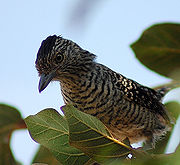
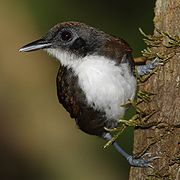

The antbirds are a large family of small passerine birds of subtropical and tropical Central and South America. They are forest birds, and tend to feed on insects at or near the ground. A sizable minority of them specialize in following columns of army ants to eat the small invertebrates that leave hiding to flee the ants.Many species lack bright colour; brown, black and white being the dominant tones. There are about 212 species worldwide and 30 species which occur in Panama.
- Fasciated AntshrikeFasciated AntshrikeThe Fasciated Antshrike is a species of bird in the Thamnophilidae family.It is found in Bolivia, Brazil, Colombia, Costa Rica, Ecuador, French Guiana, Guyana, Honduras, Nicaragua, Panama, Peru, Suriname, and Venezuela....
Cymbilaimus lineatus - Great AntshrikeGreat AntshrikeThe Great Antshrike, Taraba major, is a passerine bird in the antbird family. It is the only member of the genus Taraba-....
Taraba major - Barred AntshrikeBarred AntshrikeThe Barred Antshrike, Thamnophilus doliatus, is a passerine bird in the antbird family. It is found in the Neotropics from Tamaulipas, Mexico, through Central America, Trinidad and Tobago, and a large part of South America east of the Andes as far south as northern Argentina, Bolivia and Paraguay....
Thamnophilus doliatus - Black-hooded AntshrikeBlack-hooded AntshrikeThe Black-hooded Antshrike is a species of bird in the Thamnophilidae family.It is found in Costa Rica and Panama....
Thamnophilus bridgesi - Black AntshrikeBlack AntshrikeThe Black Antshrike is a species of bird in the Thamnophilidae family.It is found in Colombia and Panama. Its natural habitats are subtropical or tropical moist lowland forests and heavily degraded former forest....
Thamnophilus nigriceps - Western Slaty-AntshrikeWestern Slaty-AntshrikeThe Western Slaty-Antshrike is a species of bird in the Thamnophilidae family.It is found in from western Ecuador, western Colombia, western Venezuela, and Central America as far north as Belize....
Thamnophilus atrinucha - Speckled Antshrike Xenornis setifrons
- Russet AntshrikeRusset AntshrikeThe Russet Antshrike, Thamnistes anabatinus, is a passerine bird in the antbird family. It is the only member of the genus Thamnistes.It is a resident breeder in the tropical New World from southern Mexico to northern Bolivia....
Thamnistes anabatinus - Plain AntvireoPlain AntvireoThe Plain Antvireo, Dysithamnus mentalis, is a passerine bird species in the antbird family , wherein it belongs to the antshrike subfamily . It is a resident breeder in tropical Central and South America....
Dysithamnus mentalis - Spot-crowned AntvireoSpot-crowned AntvireoThe Spot-crowned Antvireo is a species of bird in the Thamnophilidae family.It is found in Colombia, Costa Rica, Ecuador, and Panama.Its natural habitat is subtropical or tropical moist lowland forests.-References:...
Dysithamnus puncticeps - Moustached AntwrenMoustached AntwrenThe Moustached Antwren is a species of small Neotropical bird in the Thamnophilidae family. It has two allopatric subspecies, both sometimes considered separate monotypic species: The Griscom's Antwren is found the Chocó of north-western Ecuador, western Colombia and eastern Panama, and the...
Myrmotherula ignota - Pacific AntwrenPacific AntwrenThe Pacific Antwren is a species of bird in the Thamnophilidae family.It is found in Colombia and Ecuador.-References:* BirdLife International 2004. . Downloaded on 26 July 2007....
Myrmotherula pacifica - Checker-throated AntwrenChecker-throated AntwrenThe Checker-throated Antwren or Fulvous-bellied Antwren is a small passerine bird in the antbird family. It has traditionally been placed in the genus Myrmotherula, but is, together with other members of the so-called "stipple-throated group", now placed in the new genus Epinecrophylla...
Myrmotherula fulviventris - White-flanked AntwrenWhite-flanked AntwrenThe White-flanked Antwren is a passerine bird in the antbird family.-Taxonomy:The subspecies M. a. luctuosa, the Silvery-flanked Antwren, is sometimes split as a full species.-Distribution and habitat:...
Myrmotherula axillaris - Slaty AntwrenSlaty AntwrenThe Slaty Antwren, Myrmotherula schisticolor, is a small passerine bird in the antbird family. It is a resident breeder in tropical Central and South America from southern Mexico to western Ecuador and eastern Peru....
Myrmotherula schisticolor - Rufous-winged AntwrenRufous-winged AntwrenThe Rufous-winged Antwren is a species of bird in the Thamnophilidae family.It is found in Argentina, Bolivia, Brazil, Colombia, Ecuador, Panama, Paraguay, Peru, Suriname, and Venezuela....
Herpsilochmus rufimarginatus - Dot-winged AntwrenDot-winged AntwrenThe Dot-winged Antwren is a passerine bird in the antbird family. In the past it was sometimes known as the Velvety Antwren, and some of its more distinctive subspecies have their own infrequently used English names...
Microrhopias quixensis - White-fringed AntwrenWhite-fringed AntwrenThe White-fringed Antwren, Formicivora grisea, is a passerine bird in the antbird family. It is a resident breeder in tropical South America from Colombia southeast to the Guianas and Brazil, and on Tobago....
Formicivora grisea - Rufous-rumped AntwrenRufous-rumped AntwrenThe Rufous-rumped Antwren is a species of bird in the Thamnophilidae family.It is found in Colombia, Costa Rica, Ecuador, Guyana, Panama, Peru, Suriname, and Venezuela....
Terenura callinota - Dusky AntbirdDusky AntbirdThe Dusky Antbird or Tyrannine Antbird, Cercomacra tyrannina, is a passerine bird in the antbird family. It is a resident breeder in tropical Central and South America from southeastern Mexico southwards to western Ecuador, and Amazonian Brazil....
Cercomacra tyrannina - Jet AntbirdJet AntbirdThe Jet Antbird is a species of bird in the Thamnophilidae family.It is found in Brazil, Colombia, Ecuador, Panama, and Venezuela.Its natural habitat is subtropical or tropical moist lowland forests.-References:...
Cercomacra nigricans - Bare-crowned AntbirdBare-crowned AntbirdThe Bare-crowned Antbird is a species of bird in the Thamnophilidae family in the monotypic genus Gymnocichla.It is found in Belize, Colombia, Costa Rica, Guatemala, Honduras, Mexico, Nicaragua, and Panama....
Gymnocichla nudiceps - White-bellied AntbirdWhite-bellied AntbirdThe White-bellied Antbird , is a passerine bird which breeds in the tropical New World from Panama to northern Brazil and in Trinidad. It is also called Swainson's Antcatcher after William John Swainson, who first described it scientifically...
Myrmeciza longipes - Chestnut-backed AntbirdChestnut-backed AntbirdThe Chestnut-backed Antbird, Myrmeciza exsul, is a passerine bird in the antbird family. It is found in humid forests in Central and South America , ranging from eastern Nicaragua to western Ecuador...
Myrmeciza exsul - Dull-mantled AntbirdDull-mantled AntbirdThe Dull-mantled Antbird is a perching bird species in the antbird family . Its scientific name is presently Myrmeciza laemosticta, but as it does not seem to be closely related to the White-bellied Antbird The Dull-mantled Antbird is a perching bird species in the antbird family (Thamnophilidae)....
Myrmeciza laemosticta - Immaculate AntbirdImmaculate AntbirdThe Immaculate Antbird is a species of antbird in the family Thamnophilidae. It is found at low levels in humid forests in Costa Rica, Panama, western and northern Colombia, western Venezuela, and western Ecuador...
Myrmeciza immaculata - Bicolored Antbird Gymnopithys leucaspis
- Wing-banded AntbirdWing-banded AntbirdThe Wing-banded Antbird is a species of bird in the Thamnophilidae family. It is placed in the monotypic genus Myrmornis....
Myrmornis torquata - Spotted AntbirdSpotted AntbirdThe Spotted Antbird is a species of bird in the Thamnophilidae family.In southern Central America, it is found in Nicaragua, Costa Rica and Panama; also Colombia and Ecuador of northwestern South America....
Hylophylax naevioides - Ocellated AntbirdOcellated AntbirdThe Ocellated Antbird is a species of antbird in the family Thamnophilidae. It is monotypic within the genus Phaenostictus.It is found in Colombia, Costa Rica, Ecuador, Honduras, Nicaragua, and Panama....
Phaenostictus mcleannani
Antthrushes and antpittas
Order: Passeriformes. Family: FormicariidaeFormicariidae
The Formicariidae, formicariids, or ground antbirds are a family of smallish passerine birds of subtropical and tropical Central and South America. They are between 10 and 20 cm in length, and are related to the antbirds, Thamnophilidae, and gnateaters, Conopophagidae...
The ground antbirds are a family comprising the antthrushes and antpittas. Antthrushes resemble small rails while antpittas resemble the true pittas
Pitta (bird)
Pittas are a family, Pittidae, of passerine birds mainly found in tropical Asia and Australasia, although a couple of species live in Africa. Pittas are all similar in general structure and habits, and have often been placed in a single genus, although as of 2009 they are now split into three...
with longish strong legs, very short tails and stout bills. There are about 63 species worldwide and 8 species which occur in Panama.
- Black-headed AntthrushBlack-headed AntthrushThe Black-headed Antthrush is a species of bird in the Formicariidae family.It is found in Colombia, Costa Rica, Ecuador, and Panama....
Formicarius nigricapillus - Black-faced AntthrushBlack-faced AntthrushThe Black-faced Antthrush , is a passerine bird.-Distribution and habitat:It is a common and widespread forest bird in the tropical New World, from southern Mexico through Central America to the northern regions of South America...
Formicarius analis - Rufous-breasted AntthrushRufous-breasted AntthrushThe Rufous-breasted Antthrush is a species of bird in the Formicariidae family.It is found in Colombia, Costa Rica, Ecuador, Panama, Peru, and Venezuela.Its natural habitat is subtropical or tropical moist montanes....
Formicarius rufipectus - Black-crowned AntpittaBlack-crowned AntpittaThe Black-crowned Antpitta or Black-crowned Gnatpitta is a species of bird in the gnateater family.It is found in Colombia, Costa Rica, and Panama.Its natural habitat is subtropical or tropical moist lowland forests....
Pittasoma michleri - Scaled AntpittaScaled AntpittaThe Scaled Antpitta is a species of bird tentatively placed in the family Formicariidae; it might belong to a more distinct lineage though....
Grallaria guatimalensis - Streak-chested Antpitta Hylopezus perspicillatus
- Fulvous-bellied AntpittaFulvous-bellied AntpittaThe White-lored Antpitta or Fulvous-bellied Antpitta is a species of bird in the Formicariidae family. It is found in Colombia, Ecuador, and Peru. Its natural habitats are subtropical or tropical moist lowland forests and heavily degraded former forest.-References:* BirdLife International 2004. ...
Hylopezus dives - Ochre-breasted AntpittaOchre-breasted AntpittaThe Ochre-breasted Antpitta is a species of bird tentatively placed in the family Formicariidae; it might belong to a more distinct lineage though....
Grallaricula flavirostris
Tapaculos
Order: Passeriformes. Family: RhinocryptidaeThe tapaculos are a group of small suboscine passeriform bird
Bird
Birds are feathered, winged, bipedal, endothermic , egg-laying, vertebrate animals. Around 10,000 living species and 188 families makes them the most speciose class of tetrapod vertebrates. They inhabit ecosystems across the globe, from the Arctic to the Antarctic. Extant birds range in size from...
s with numerous species, found in South America
South America
South America is a continent situated in the Western Hemisphere, mostly in the Southern Hemisphere, with a relatively small portion in the Northern Hemisphere. The continent is also considered a subcontinent of the Americas. It is bordered on the west by the Pacific Ocean and on the north and east...
. They are terrestrial species that fly only poorly on their short wings. They have strong legs, well-suited to their habitat of grassland or forest undergrowth. The tail is cocked and pointed towards the head. There are 56 species worldwide and 3 species which occur in Panama.
- Pale-throated Tapaculo Scytalopus panamensis
- Silvery-fronted TapaculoSilvery-fronted TapaculoThe Silvery-fronted Tapaculo is a species of bird in the Rhinocryptidae family.It is found in Costa Rica and Panama.Its natural habitat is subtropical or tropical moist montanes.-References:...
Scytalopus argentifrons - Choco TapaculoChocó TapaculoThe Chocó Tapaculo is a species of bird in the Rhinocryptidae family. It is found in Colombia, Ecuador, and Panama.-References:* BirdLife International 2004. . Downloaded on 27 July 2007....
Scytalopus chocoensis
Cotingas
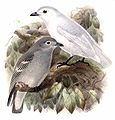
The cotingas are birds of forests or forest edges of tropical South America. Comparatively little is known about this diverse group, although all have broad bills with hooked tips, rounded wings, and strong legs. The males of many of the species are brightly coloured, or decorated with plumes or wattles. There are 71 species worldwide and 11 species which occur in Panama
- SharpbillSharpbillThe Sharpbill is a small drab bird. Its range is from the mountainous areas of tropical South America and southern Central America ....
Oxyruncus cristatus - Rufous PihaRufous PihaThe Rufous Piha is a species of bird in the Cotingidae family.It is found in Belize, Colombia, Costa Rica, Ecuador, Guatemala, Honduras, Mexico, Nicaragua, and Panama....
Lipaugus unirufus - Lovely CotingaLovely CotingaThe Lovely Cotinga is a species of bird in the Cotingidae family. It is found in Central America from southern Mexico through Guatemala, Belize, Honduras and Nicaragua to Costa Rica with reports from western Panama...
Cotinga amabilis (A) - Turquoise CotingaTurquoise CotingaThe Turquoise Cotinga or Ridgway's Cotinga is a species of bird in the Cotingidae family.It is found in Costa Rica and western Panama....
Cotinga ridgwayi - Blue CotingaBlue CotingaThe Blue Cotinga is a species of bird in the Cotingidae family.It is found in Colombia, north-west Ecuador, eastern and central Panama and western Venezuela....
Cotinga nattererii - Black-tipped CotingaBlack-tipped CotingaThe Black-tipped Cotinga is a species of bird in the Cotingidae family.It is found in Colombia, Ecuador, and Panama.Its natural habitat is subtropical or tropical moist lowland forests.-References:...
Carpodectes hopkei - Yellow-billed CotingaYellow-billed CotingaThe Yellow-billed Cotinga is a species of bird in the Cotingidae family.It is found in Costa Rica and Panama....
Carpodectes antoniae - Snowy CotingaSnowy CotingaThe Snowy Cotinga is a species of bird in the Cotingidae family.It is found in Costa Rica, Honduras, Nicaragua, and Panama....
Carpodectes nitidus - Purple-throated FruitcrowPurple-throated FruitcrowThe Purple-throated Fruitcrow is a species of bird in the Cotingidae family, the cotingas. It is the only species of the genus Querula....
Querula purpurata - Bare-necked UmbrellabirdBare-necked UmbrellabirdThe Bare-necked Umbrellabird is a species of bird in the Cotingidae family.It is found in Costa Rica and Panama....
Cephalopterus glabricollis - Three-wattled BellbirdThree-wattled bellbirdThe Three-wattled Bellbird is a Central American migratory bird of the cotinga family.-Overview:One of four species of bellbird that live in Central and South America, the Three-wattled Bellbird is between and long...
Procnias tricarunculata
Manakins
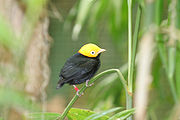
The manakins are a family bird species of subtropical and tropical mainland Central and South America, and Trinidad and Tobago. They are compact forest birds, the males typically being brightly coloured, although the females of most species are duller and usually green-plumaged. Manakins feed on small fruits, berries and insects. There are 57 species worldwide and 13 species which occur in Panama.
- Green ManakinGreen ManakinThe Green Manakin is a species of bird in the Pipridae family. It occurs in humid forest in lowlands and foothills. The distribution is disjunct, with one population in the western Amazon Basin and adjacent east Andean foothills in south-eastern Colombia, eastern Ecuador and eastern Peru, and...
Chloropipo holochlora - White-collared ManakinWhite-collared ManakinThe White-collared Manakin, Manacus candei, is a passerine bird in the manakin family. It is a resident breeder in the tropical New World from southeastern Mexico to Costa Rica and the extreme west of Panama....
Manacus candei - Orange-collared ManakinOrange-collared ManakinThe Orange-collared Manakin, Manacus aurantiacus, is a passerine bird in the manakin family. It is an endemic resident breeder in Costa Rica and western Panama....
Manacus aurantiacus - Golden-collared ManakinGolden-collared ManakinThe Golden-collared Manakin is a species of bird in the Pipridae family.It is found in Colombia, Costa Rica, and Panama. Its natural habitats are subtropical or tropical moist lowland forests and heavily degraded former forest....
Manacus vitellinus - White-ruffed ManakinWhite-ruffed ManakinThe White-ruffed Manakin, Corapipo altera, is a tiny passerine bird in the manakin family. It is a resident breeder in the tropical New World from eastern Honduras to northwestern Venezuela....
Corapipo altera - Lance-tailed ManakinLance-tailed ManakinThe Lance-tailed Manakin, Chiroxiphia lanceolata, is a small passerine bird which breeds in tropical Central and South America from Costa Rica to northern Venezuela....
Chiroxiphia lanceolata - White-crowned ManakinWhite-crowned ManakinThe White-crowned Manakin is a tiny passerine bird in the manakin family. It is a resident breeder in the tropical New World from Costa Rica to northeastern Peru and eastern Brazil. It was formerly placed in the genus Pipra, but its syringeal anatomy favours its separation as a separate genus...
Dixiphia pipra - Blue-crowned ManakinBlue-crowned ManakinThe Blue-crowned Manakin is a species of bird in the Pipridae family. The males have a brilliant blue cap; some have black, others have green body plumage, but the relationship between the subspecies is not well understood....
Lepidothrix coronata - Golden-headed ManakinGolden-headed ManakinThe Golden-headed Manakin, Pipra erythrocephala, is a small passerine bird which breeds in tropical South America. It is found from Panama, Colombia and Trinidad south and east to the Guianas and Brazil and northern Peru...
Pipra erythrocephala - Red-capped ManakinRed-capped ManakinThe Red-capped Manakin is a species of bird in the Pipridae family.It is found in Belize, Colombia, Costa Rica, Ecuador, Guatemala, Honduras, Mexico, Nicaragua, Peru and Panama....
Pipra mentalis - Gray-headed Piprites Pipirites griseiceps
- Sapayoa Sapayoa aenigma
- Thrush-like SchiffornisThrush-like SchiffornisThe Thrush-like Schiffornis , also called Thrush-like Mourner or Thrush-like Manakin, is a species of Neotropical bird.-Distribution and habitat:...
Schiffornis turdinus
Tyrant flycatchers
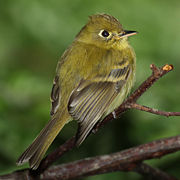
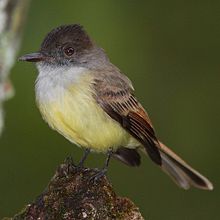
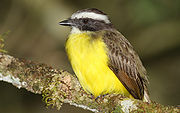
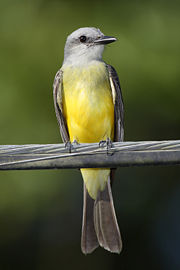
Tyrant flycatcher
Tyrant flycatcher
The tyrant flycatchers are a family of passerine birds which occur throughout North and South America. They are considered the largest family of birds on Earth, with more than 400 species. They are the most diverse avian family in every country in the Americas, except for the United States and...
s are passerine
Passerine
A passerine is a bird of the order Passeriformes, which includes more than half of all bird species. Sometimes known as perching birds or, less accurately, as songbirds, the passerines form one of the most diverse terrestrial vertebrate orders: with over 5,000 identified species, it has roughly...
birds which occur throughout North and South America. They superficially resemble the Old World flycatchers, but are more robust with stronger bills. They do not have the sophisticated vocal capabilities of the songbirds. Most, but not all, have plain colouring. As the name implies, most are insectivorous. There are 429 species worldwide, all found only in the Americas and 103 species which occur in Panama.
- Yellow-bellied TyrannuletYellow-bellied TyrannuletThe Yellow-bellied Tyrannulet is a species of bird in the Tyrannidae family.It is found in Belize, Costa Rica, Guatemala, Honduras, Mexico, and Nicaragua....
Ornithion semiflavum - Brown-capped TyrannuletBrown-capped TyrannuletThe Brown-capped Tyrannulet is a species of bird in the Tyrannidae family.It is found in Colombia, Costa Rica, Ecuador, Panama, and Venezuela....
Ornithion brunneicapillus - Southern Beardless-Tyrannulet Camptostoma obsoletum
- Mouse-colored Tyrannulet Phaeomyias murina
- Yellow TyrannuletYellow TyrannuletThe Yellow Tyrannulet, Capsiempis flaveola, is a very small passerine bird in the tyrant flycatcher family. It breeds from Nicaragua south to northeastern Argentina and southeastern Brazil...
Capsiempis flaveola - Yellow-crowned TyrannuletYellow-crowned TyrannuletThe Yellow-crowned Tyrannulet is a species of bird in the Tyrannidae family. It is monotypic within the genus Tyrannulus....
Tyrannulus elatus - Forest ElaeniaForest ElaeniaThe Forest Elaenia, Myiopagis gaimardii, is a small passerine bird in the tyrant flycatcher family. It breeds from Panama through Colombia, Venezuela and the Guianas to Bolivia and Brazil. It also occurs on Trinidad....
Myiopagis gaimardii - Gray Elaenia Myiopagis caniceps
- Greenish ElaeniaGreenish ElaeniaThe Greenish Elaenia is a species of bird in the Tyrannidae family, the tyrant flycatchers.It is found in Argentina, Belize, Bolivia, Brazil, Colombia, Costa Rica, Ecuador, El Salvador, Guatemala, Guyana, Honduras, Mexico, Nicaragua, Panama, Paraguay, Peru, the United States, and Venezuela.Its...
Myiopagis viridicata - Yellow-bellied ElaeniaYellow-bellied ElaeniaThe Yellow-bellied Elaenia, Elaenia flavogaster, is a small bird of the tyrant flycatcher family. It breeds from southern Mexico and the Yucatán Peninsula through Central and South America as far as northern Argentina, and on Trinidad and Tobago....
Elaenia flavogaster - Lesser ElaeniaLesser ElaeniaThe Lesser Elaenia is a species of bird in the Tyrannidae family, the tyrant flycatchers.It is found in Argentina, Aruba, Bolivia, Brazil, Colombia, Costa Rica, Ecuador, French Guiana, Guyana, Netherlands Antilles, Panama, Paraguay, Peru, Suriname, Trinidad and Tobago, and Venezuela...
Elaenia chiriquensis - Mountain ElaeniaMountain ElaeniaThe Mountain Elaenia, Elaenia frantzii, is a small passerine bird in the tyrant flycatcher family. It breeds in highlands from Guatemala to Colombia and western Venezuela. The scientific name celebrates the German physician and naturalist, Alexander von Frantzius.This tyrant flycatcher is 14-15...
Elaenia frantzii - Torrent TyrannuletTorrent TyrannuletThe Torrent Tyrannulet, Serpophaga cinerea, is a small bird of the tyrant flycatcher family. It breeds from Costa Rica south to northern Bolivia and northwestern Venezuela.-Habitat:...
Serpophaga cinerea - Ochre-bellied FlycatcherOchre-bellied FlycatcherThe Ochre-bellied Flycatcher, Mionectes oleagineus, is a small bird of the tyrant flycatcher family. It breeds from southern Mexico through Central America, and South America east of the Andes as far as southern Brazil, and on Trinidad and Tobago....
Mionectes oleagineus - Olive-striped FlycatcherOlive-striped FlycatcherThe Olive-striped Flycatcher is a species of bird in the Tyrannidae family.It is found in Bolivia, Colombia, Costa Rica, Ecuador, Panama, Peru, Trinidad and Tobago, and Venezuela....
Mionectes olivaceus - Sepia-capped FlycatcherSepia-capped FlycatcherThe Sepia-capped Flycatcher is a species of bird in the Tyrannidae family.It is found in Argentina, Belize, Bolivia, Brazil, Colombia, Costa Rica, Ecuador, French Guiana, Guatemala, Guyana, Honduras, Mexico, Nicaragua, Panama, Paraguay, Peru, Suriname, and Venezuela...
Leptopogon amaurocephalus - Slaty-capped FlycatcherSlaty-capped FlycatcherThe Slaty-capped Flycatcher, Leptopogon superciliaris, is a small passerine bird in the tyrant flycatcher family. It breeds from Costa Rica through Colombia and northern Venezuela to northern Bolivia, Ecuador, and Peru. It also occurs on Trinidad....
Leptopogon superciliaris - Bronze-olive Pygmy-TyrantBronze-olive Pygmy-tyrantThe Bronze-olive Pygmy-tyrant is a species of bird in the Tyrannidae family.It is found in Colombia, Ecuador, Panama, and Peru.Its natural habitat is subtropical or tropical moist montane forests.-References:...
Pseudotriccus pelzelni - Yellow-green TyrannuletYellow-green TyrannuletThe Panamanian Tyrannulet or Yellow-green Tyrannulet is a species of bird in the Tyrannidae family.It is endemic to Panama.Its natural habitat is subtropical or tropical moist lowland forests.-References:...
Phylloscartes flavovirens (E) - Rufous-browed TyrannuletRufous-browed TyrannuletThe Rufous-browed Tyrannulet is a species of bird in the Tyrannidae family.It is found in Colombia, Costa Rica, Ecuador, Panama, Peru, and Venezuela. Its natural habitat is subtropical or tropical moist montane forests.-References:* BirdLife International 2004. . Downloaded on 26 July 2007....
Phylloscartes superciliaris - White-fronted Tyrannulet Phyllomyias zeledoni
- Sooty-headed TyrannuletSooty-headed TyrannuletThe Sooty-headed Tyrannulet is a species of bird in the Tyrannidae family. It is found in Brazil, Colombia, Ecuador, Guyana, Panama, Peru, and Venezuela....
Phyllomyias griseiceps - Paltry Tyrannulet Zimmerius vilissimus
- Northern Scrub-FlycatcherNorthern Scrub-flycatcherThe Northern Scrub Flycatcher is a species of bird in the Tyrannidae family.It is found in Aruba, Brazil, Colombia, Costa Rica, French Guiana, Guyana, Netherlands Antilles, Panama, Suriname, Trinidad and Tobago, and Venezuela....
Sublegatus arenarum - Black-capped Pygmy-TyrantBlack-capped Pygmy-TyrantThe Black-capped Pygmy Tyrant, Myiornis atricapillus, is the smallest passerine bird in its range, though larger than its cousin, the Short-tailed Pygmy Tyrant. This tyrant flycatcher occurs from Costa Rica to north-western Ecuador....
Myiornis atricapillus - Scale-crested Pygmy-TyrantScale-crested Pygmy-tyrantThe Scale-crested Pygmy Tyrant is a species of bird in the Tyrannidae family.It is found in Colombia, Costa Rica, Ecuador, Panama, Peru, Venezuela, and possibly Honduras....
Lophotriccus pileatus - Pale-eyed Pygmy-TyrantPale-eyed Pygmy-tyrantThe Pale-eyed Pygmy-Tyrant is a species of bird in the Tyrannidae family, where it makes up the monotypic genus Atalotriccus....
Atalotriccus pilaris - Northern BentbillNorthern BentbillThe Northern Bentbill is a species of bird in the Tyrannidae family.It is found in Belize, Colombia, Costa Rica, El Salvador, Guatemala, Honduras, Mexico, Nicaragua, and Panama....
Oncostoma cinereigulare - Southern BentbillSouthern BentbillThe Southern Bentbill is a species of bird in the Tyrannidae family.It is found in Colombia and Panama.Its natural habitats are subtropical or tropical moist lowland forests and heavily degraded former forest.-References:...
Oncostoma olivaceum - Slate-headed Tody-Tyrant Poecilotriccus sylvia
- Common Tody-FlycatcherCommon Tody-FlycatcherThe Common Tody-Flycatcher or Black-fronted Tody-Flycatcher, Todirostrum cinereum, is a very small passerine bird in the tyrant flycatcher family. It breeds from southern Mexico to northwestern Peru, eastern Bolivia and southern Brazil....
Todirostrum cinereum - Black-headed Tody-FlycatcherBlack-headed Tody-flycatcherThe Black-headed Tody-Flycatcher is a species of bird in the Tyrannidae family.It is found in Colombia, Costa Rica, Ecuador, Panama, and Venezuela.Its natural habitat is subtropical or tropical moist lowland forests....
Todirostrum nigriceps - Brownish Flycatcher Cnipodectes subbrunneus
- Eye-ringed FlatbillEye-ringed FlatbillThe Eye-ringed Flatbill is a species of bird in the Tyrannidae family.It is found in Belize, Colombia, Costa Rica, El Salvador, Guatemala, Honduras, Mexico, Nicaragua, and Panama....
Rhynchocyclus brevirostris - Olivaceous FlatbillOlivaceous FlatbillThe Olivaceous Flatbill is a species of bird in the Tyrannidae family.It is found in Bolivia, Brazil, Colombia, Ecuador, French Guiana, Guyana, Panama, Peru, Suriname, and Venezuela. Its natural habitats are subtropical or tropical moist lowland forests and subtropical or tropical...
Rhynchocyclus olivaceus - Yellow-olive FlycatcherYellow-olive FlycatcherThe Yellow-olive Flatbill or Yellow-olive Flycatcher is a species of bird in the Tyrannidae family. It is found in tropical and subtopical forest and woodland in Central and South America, but over its range there are significant variations in plumage, iris-colour and voice, leading to...
Tolmomyias sulphurescens - Yellow-margined FlycatcherYellow-margined FlycatcherThe Yellow-margined Flatbill or Yellow-margined Flycatcher is a species of bird in the Tyrannidae family. It is found in humid forest in southern Central America, and the Chocó and Amazon in South America....
Tolmomyias assimilis - Yellow-breasted FlycatcherYellow-breasted FlycatcherThe Yellow-breasted Flatbill or Yellow-breasted Flycatcher, Tolmomyias flaviventris, is a passerine bird in the tyrant flycatcher family. It is found in South America, ranging from Colombia and Venezuela south to Peru, Bolivia, and Brazil, and on both Trinidad and Tobago...
Tolmomyias flaviventris - Stub-tailed SpadebillStub-tailed SpadebillThe Stub-tailed Spadebill is a species of bird in the Tyrannidae family.It is found in Belize, Costa Rica, El Salvador, Guatemala, Honduras, Mexico, Nicaragua, and Panama....
Platyrinchus cancrominus - Golden-crowned SpadebillGolden-crowned SpadebillThe Golden-crowned Spadebill is a species of bird in the Tyrannidae family.It is found in Bolivia, Brazil, Colombia, Costa Rica, Ecuador, French Guiana, Guyana, Honduras, Nicaragua, Panama, Peru, Suriname, and Venezuela....
Platyrinchus coronatus - White-throated SpadebillWhite-throated SpadebillThe White-throated Spadebill, Platyrinchus mystaceus, is a tiny passerine bird in the tyrant flycatcher family. It lives in the tropical Americas.-Description:...
Platyrinchus mystaceus - Northern Royal-Flycatcher Onychorhynchus mexicanus
- Bran-colored FlycatcherBran-colored FlycatcherThe Bran-colored Flycatcher, Myiophobus fasciatus, is a small passerine bird in the tyrant flycatcher family. It breeds from Costa Rica through South America to Bolivia, Uruguay, and Argentina. It also occurs on Trinidad....
Myiophobus fasciatus - Ruddy-tailed FlycatcherRuddy-tailed FlycatcherThe Ruddy-tailed Flycatcher, Terenotriccus erythrurus, is a small passerine bird in the tyrant flycatcher family. It breeds in lowlands from southeastern Mexico to northern Bolivia, north-central Brazil and the Guianas...
Terenotriccus erythrurus - Tawny-breasted FlycatcherTawny-breasted FlycatcherThe Tawny-breasted Myiobius or Tawny-breasted Flycatcher is a species of bird in the Tyrannidae family.It is found in Bolivia, Colombia, Ecuador, Panama, Peru, and Venezuela....
Myiobius villosus - Sulphur-rumped FlycatcherSulphur-rumped FlycatcherThe Sulphur-rumped Myiobius or Sulphur-rumped Flycatcher is a species of bird in the Tyrannidae family.It is found in Belize, Colombia, Costa Rica, Ecuador, Guatemala, Honduras, Mexico, Nicaragua, and Panama....
Myiobius sulphureipygius - Black-tailed FlycatcherBlack-tailed FlycatcherThe Black-tailed Myiobius or Black-tailed Flycatcher is a species of bird in the Tyrannidae family.It is found in Brazil, Colombia, Costa Rica, Ecuador, Panama, Peru, and Venezuela. Its natural habitats are subtropical or tropical moist lowland forests and heavily degraded former...
Myiobius atricaudus - Black-billed FlycatcherBlack-billed FlycatcherThe Black-billed Flycatcher is a species of bird in the Tyrannidae family.It is found in Colombia and Panama.Its natural habitat is subtropical or tropical moist lowland forests.It is threatened by habitat loss.-Source:...
Aphanotriccus audax - Tufted FlycatcherTufted FlycatcherThe Northern Tufted Flycatcher, Mitrephanes phaeocercus, is a small passerine bird in the tyrant flycatcher family. It breeds in highlands from northwestern Mexico to northwestern Ecuador...
Mitrephanes phaeocercus - Olive-sided FlycatcherOlive-sided FlycatcherThe Olive-sided Flycatcher, Contopus cooperi, is a passerine bird. It is a medium-sized tyrant flycatcher.- Description :Adults are dark olive on the face, upperparts and flanks. They have light underparts, a large dark bill and a short tail....
Contopus cooperi - Dark PeweeDark PeweeThe Dark Pewee, Contopus lugubris, is a small passerine bird in the tyrant flycatcher family. It is endemic to the highlands of Costa Rica and western Panama....
Contopus lugubris - Ochraceous PeweeOchraceous PeweeThe Ochraceous Pewee is a species of bird in the Tyrannidae family.It is found in Costa Rica, Mexico, and Panama.Its natural habitat is subtropical or tropical moist montanes.-References:...
Contopus ochraceus - Western Wood-Pewee Contopus sordidulus
- Eastern Wood-Pewee Contopus virens
- Tropical PeweeTropical PeweeThe Tropical Pewee, Contopus cinereus, is a small passerine bird in the tyrant flycatcher family. It breeds from southern Mexico and Trinidad south to Bolivia and Argentina...
Contopus cinereus - Yellow-bellied FlycatcherYellow-bellied FlycatcherThe Yellow-bellied Flycatcher is a small insect-eating bird of the tyrant flycatcher family.Adults have brownish-olive upperparts, darker on the wings and tail, with yellowish underparts; they have a white eye ring, white wing bars, a small bill and a short tail...
Empidonax flaviventris - Acadian FlycatcherAcadian FlycatcherThe Acadian Flycatcher is a small insect-eating bird of the tyrant flycatcher family.- Description :Adults have olive upperparts, darker on the wings and tail, with whitish underparts; they have a white eye ring, white wing bars and a wide bill. The breast is washed with olive. The upper part of...
Empidonax virescens - Alder FlycatcherAlder FlycatcherThe Alder Flycatcher, Empidonax alnorum, is a small insect-eating bird of the tyrant flycatcher family.Adults have olive-brown upperparts, browner on the wings and tail, with whitish underparts; they have a white eye ring, white wing bars, a small bill and a short tail. The breast is washed with...
Empidonax alnorum - Willow FlycatcherWillow FlycatcherThe Willow Flycatcher is a small insect-eating bird of the tyrant flycatcher family.Adults have brown-olive upperparts, darker on the wings and tail, with whitish underparts; they have an indistinct white eye ring, white wing bars and a small bill. The breast is washed with olive-grey. The upper...
Empidonax traillii - White-throated FlycatcherWhite-throated FlycatcherThe White-throated Flycatcher is a species of bird in the Tyrannidae family.It is found in Belize, Costa Rica, El Salvador, Guatemala, Honduras, Mexico, Nicaragua, and Panama....
Empidonax albigularis - Least FlycatcherLeast FlycatcherThe Least Flycatcher , , is a small insect-eating bird...
Empidonax minimus (A) - Hammond's FlycatcherHammond's FlycatcherHammond's Flycatcher, Empidonax hammondii is a small insect-eating bird. It is a small Empidonax flycatcher, with typical size ranging from 12.5-14.5 cm....
Empidonax hammondi (A) - Yellowish FlycatcherYellowish FlycatcherThe Yellowish Flycatcher, Empidonax flavescens, is a small passerine bird in the tyrant flycatcher family. It breeds in highlands from southeastern Mexico south to western Panama....
Empidonax flavescens - Black-capped FlycatcherBlack-capped FlycatcherThe Black-capped Flycatcher, Empidonax atriceps, is a very small passerine bird in the tyrant flycatcher family. It is endemic to the highlands of Costa Rica and western Panama....
Empidonax atriceps - Black PhoebeBlack PhoebeThe Black Phoebe, Sayornis nigricans, is a passerine bird in the tyrant-flycatcher family. It breeds from southwest Oregon and California south through Central and South America. It occurs year-round throughout most of its range and migrates less than the other birds in its genus, though its...
Sayornis nigricans - Vermilion FlycatcherVermilion FlycatcherThe Vermilion Flycatcher is a small passerine bird in the Tyrannidae, or tyrant flycatcher family. Most flycatchers are rather drab, but the Vermilion Flycatcher is a striking exception...
Pyrocephalus rubinus (A) - Pied Water-Tyrant Fluvicola pica
- Long-tailed TyrantLong-tailed TyrantThe Long-tailed Tyrant is a species of bird in the Tyrannidae family, the only member of genus Colonia.It is found in Argentina, Bolivia, Brazil, Colombia, Costa Rica, Ecuador, French Guiana, Guyana, Honduras, Nicaragua, Panama, Paraguay, Peru, Suriname, and Venezuela.Its natural habitats are...
Colonia colonus - Cattle TyrantCattle TyrantThe Cattle Tyrant is a species of bird in the Tyrannidae family. It is the only member of the genus Machetornis.It is found in Argentina, Bolivia, Brazil, Colombia, Ecuador, Panama, Paraguay, Uruguay, and Venezuela....
Machetornis rixosus (A) - Bright-rumped AttilaBright-rumped AttilaThe Bright-rumped Attila or Polymorphic Attila, Attila spadiceus, is a small passerine bird in the tyrant flycatcher family...
Attila spadiceus - Speckled MournerSpeckled MournerThe Speckled Mourner is a species of bird in the Tityridae family. It has traditionally been placed in the cotinga family, but evidence strongly suggest it is better placed in Tityridae, where now placed by SACC....
Laniocera rufescens - SirystesSirystesThe Sirystes is a species of bird in the Tyrannidae family. It is sometimes split into the Eastern Syristes S. sibilator and the Western Syristes S. albogriseus.-Distribution and habitat:...
Sirystes sibilator - Rufous MournerRufous MournerThe Rufous Mourner, Rhytipterna holerythra, is a small passerine bird in the tyrant flycatcher family. It breeds from southwestern Mexico to northwestern Ecuador...
Rhytipterna holerythra - Dusky-capped FlycatcherDusky-capped FlycatcherThe Dusky-capped Flycatcher, Myiarchus tuberculifer, is a passerine bird in the tyrant flycatcher family. It breeds in forest and other woodland from southern Arizona, as well as the Chisos Mountains, Texas, south to northern Argentina and on Trinidad...
Myiarchus tuberculifer - Panama FlycatcherPanama FlycatcherThe Panamanian Flycatcher is a species of bird in the Tyrannidae family.It is found in Colombia, Costa Rica, Panama, and Venezuela....
Myiarchus panamensis - Great Crested FlycatcherGreat Crested FlycatcherThe Great Crested Flycatcher is a large insect-eating bird of the tyrant flycatcher family. It is the most widespread member of the genus, Myiarchus, in North America and is found over most of the eastern and mid-western portions of the continent...
Myiarchus crinitus - Lesser KiskadeeLesser KiskadeeThe Lesser Kiskadee is a species of bird in the Tyrannidae family.It is found in Argentina, Bermuda, Bolivia, Brazil, Colombia, Ecuador, French Guiana, Guyana, Panama, Peru, Suriname, Trinidad and Venezuela....
Philohydor lictor - Great KiskadeeGreat KiskadeeThe Great Kiskadee, Pitangus sulphuratus, is a passerine bird. It is a large tyrant flycatcher; sometimes its genus Pitangus is considered monotypic, with the Lesser Kiskadee The Great Kiskadee, Pitangus sulphuratus, is a passerine bird. It is a large tyrant flycatcher; sometimes its genus Pitangus...
Pitangus sulphuratus - Boat-billed FlycatcherBoat-billed FlycatcherThe Boat-billed Flycatcher is a passerine bird. It is a large tyrant flycatcher, the only member, monotypic, of the genus Megarynchus....
Megarynchus pitangua - Rusty-margined FlycatcherRusty-margined FlycatcherThe Rusty-margined Flycatcher is a species of bird in the Tyrannidae family, the tyrant flycatchers.It is found in northern and central South America in Bolivia, Brazil, Colombia, Ecuador, French Guiana, Guyana, Peru, Suriname, and Venezuela; also eastern Panama...
Myiozetetes cayanensis - Social FlycatcherSocial FlycatcherThe Social Flycatcher and Vermilion-crowned Flycatcher are passerine birds from the Americas, a member of the large tyrant flycatcher family ....
Myiozetetes similis - Gray-capped Flycatcher Myiozetetes granadensis
- White-ringed FlycatcherWhite-ringed FlycatcherThe White-ringed Flycatcher is a species of bird in the Tyrannidae family.It is found in Colombia, Costa Rica, Ecuador, Honduras, and Panama....
Conopias albovittata - Golden-bellied FlycatcherGolden-bellied FlycatcherThe Golden-bellied Flycatcher, Myiodynastes hemichrysus, is a passerine bird in the tyrant flycatcher family. It is an endemic resident breeder in Costa Rica and western Panama....
Myiodynastes hemichrysus - Golden-crowned FlycatcherGolden-crowned FlycatcherThe Golden-crowned Flycatcher is a species of bird in the Tyrannidae family.It is found in Argentina, Bolivia, Colombia, Ecuador, Mexico, Panama, Peru, and Venezuela. Its natural habitats are subtropical or tropical moist montane forests and heavily degraded former forest.-References:* BirdLife...
Myiodynastes chrysocephalus - Streaked FlycatcherStreaked FlycatcherThe Streaked Flycatcher, Myiodynastes maculatus, is a passerine bird in the tyrant flycatcher family. It breeds from eastern Mexico, Trinidad and Tobago south to Bolivia and Argentina. The southern subspecies M. m...
Myiodynastes maculatus - Sulphur-bellied FlycatcherSulphur-bellied FlycatcherThe Sulphur-bellied Flycatcher, Myiodynastes luteiventris, is a large Tyrant flycatcher. This bird breeds from southeasternmost Arizona of the United States-, to Costa Rica...
Myiodynastes luteiventris - Piratic FlycatcherPiratic FlycatcherThe Piratic Flycatcher, Legatus leucophaius, is a passerine bird, the only member of the genus Legatus. It is a resident breeder from southern Mexico and Trinidad south to Bolivia and Argentina...
Legatus leucophaius - Tropical KingbirdTropical KingbirdThe Tropical Kingbird is a large tyrant flycatcher. This bird breeds from southern Arizona and the lower Rio Grande Valley of Texas in the USA through Central America, South America as far as south as central Argentina and western Peru, and on Trinidad and Tobago...
Tyrannus melancholicus - Western KingbirdWestern KingbirdThe Western Kingbird is a large tyrant flycatcher.Adults are grey-olive on the upperparts with a grey head and a dark line through the eyes; the underparts are light becoming light orange-yellow on the lower breast and belly. They have a long black tail with white outer feathers...
Tyrannus verticalis (A) - Eastern KingbirdEastern KingbirdThe Eastern Kingbird, Tyrannus tyrannus, is a large Tyrant flycatcher.Adults are grey-black on the upperparts with light underparts; they have a long black tail with a white end and long pointed wings. They have a red patch on their crown, seldom seen...
Tyrannus tyrannus - Gray KingbirdGray KingbirdThe Gray Kingbird, also known as Pitirre, Tyrannus dominicensis, is a passerine bird. It breeds from the extreme southeast of the USA through Central America, from Cuba to Puerto Rico as well as eastward towards all across the Lesser West Indies, south to Venezuela, Trinidad, Tobago the Guiana and...
Tyrannus dominicensis - Scissor-tailed FlycatcherScissor-tailed FlycatcherThe Scissor-tailed Flycatcher is a long-tailed insectivorous bird of the genus, whose members are collectively referred to as kingbirds. The kingbirds are a group of large insectivorous birds in the tyrant flycatcher family...
Tyrannus forficatus - Fork-tailed FlycatcherFork-tailed FlycatcherThe Fork-tailed Flycatcher, Tyrannus savana, is a passerine bird of the tyrant flycatcher family, and is the member of a genus typically referred to as kingbirds.-Description and ecology:...
Tyrannus savana - Barred BecardBarred BecardThe Barred Becard, Pachyramphus versicolor, is a small passerine bird which is a resident breeding species in highlands from Costa Rica to northwestern Ecuador and northern Bolivia...
Pachyramphus versicolor - Cinnamon BecardCinnamon BecardThe Cinnamon Becard, Pachyramphus cinnamomeus, is a passerine bird which is a resident breeding species from southeastern Mexico south to northwestern Ecuador and northwestern Venezuela. It was recently found to be far more common on the Amazonian slope of the Colombian Cordillera Oriental than...
Pachyramphus cinnamomeus - White-winged BecardWhite-winged BecardThe White-winged Becard is a species of bird in the Tityridae family. It has traditionally been placed in Cotingidae or Tyrannidae, but evidence strongly suggest it is better placed in Tityridae. where now placed by SACC...
Pachyramphus polychopterus - Black-and-white BecardBlack-and-white BecardThe Black-and-white Becard is a species of bird in the Tityridae family. It has traditionally been placed in Cotingidae or Tyrannidae, but evidence strongly suggest it is better placed in Tityridae, where now placed by SACC.It is found in Colombia, Costa Rica, Ecuador, Guatemala, Nicaragua,...
Pachyramphus albogriseus - Cinereous BecardCinereous BecardThe Cinereous Becard is a species of bird in the Tityridae family. The term cinereous describes its colouration...
Pachyramphus rufus - Rose-throated BecardRose-throated BecardThe Rose-throated Becard is a medium-sized member of the Tityridae family. Its genus, Pachyramphus, has traditionally been placed in Cotingidae or Tyrannidae, but evidence strongly suggest it is better placed in Tityridae....
Pachyramphus aglaiae - One-colored Becard Pachyramphus homochrous
- Masked TityraMasked TityraThe Masked Tityra is a medium-sized passerine bird. It has traditionally been placed in the cotinga or the tyrant flycatcher family, but evidence strongly suggest it is better placed in Tityridae, where now placed by SACC...
Tityra semifasciata - Black-crowned TityraBlack-crowned TityraThe Black-crowned Tityra is a medium-sized passerine bird. It has traditionally been placed in the cotinga or the tyrant flycatcher family, but evidence strongly suggest it is better placed in Tityridae, where now placed by SACC....
Tityra inquisitor
Swallows and martins

The Hirundinidae family is a group of passerines characterized by their adaptation to aerial feeding. Their adaptations include a slender streamlined body, long pointed wings and short bills with wide gape. The feet are designed for perching rather than walking, and the front toes are partially joined at the base. There are 75 species worldwide and 16 species which occur in Panama.
- Brown-chested MartinBrown-chested MartinThe Brown-chested Martin is a species of passerine bird in the swallow family.It is found in Argentina, Bolivia, Brazil, Chile, Colombia, Costa Rica, Ecuador, French Guiana, Guyana, Panama, Paraguay, Peru, Puerto Rico, Suriname, the United States, Uruguay, Venezuela, and is a vagrant to Chile and...
Progne tapera - Purple MartinPurple MartinThe Purple Martin is the largest North American swallow. These aerial acrobats have speed and agility in flight, and when approaching their housing, will dive from the sky at great speeds with their wings tucked.-Description and taxonomy:...
Progne subis - Gray-breasted MartinGray-breasted MartinThe Gray-breasted Martin, Progne chalybea, is a large swallow.The nominate race P. c. chalybea breeds from Mexico through Central America south to central Brazil, and on Trinidad. P. c. macrorhamphus breeds further south in South America to central Argentina...
Progne chalybea - Southern MartinSouthern MartinThe Southern Martin is a species of bird in the Hirundinidae family.It is found in Argentina, Bolivia, Brazil, Colombia, Ecuador, Panama, Paraguay, Peru, and Uruguay....
Progne elegans (A) - Tree SwallowTree SwallowThe Tree Swallow, Tachycineta bicolor, is a migratory passerine bird that breeds in North America and winters in Mexico, Central America and the Caribbean. It is a very rare vagrant to western Europe....
Tachycineta bicolor (A) - Mangrove SwallowMangrove SwallowThe Mangrove Swallow, Tachycineta albilinea, is a passerine bird that breeds in coastal regions from Mexico through Central America to Panama. It is non-migratory, but may make seasonal movements....
Tachycineta albilinea - White-winged SwallowWhite-winged SwallowThe White-winged Swallow, Tachycineta albiventer, is a resident breeding bird in tropical South America from Colombia, Venezuela and Trinidad south to northern Argentina...
Tachycineta albiventer (A) - Violet-green SwallowViolet-green SwallowThe Violet-green Swallow, Tachycineta thalassina, is a small North American swallow.Their breeding habitat is semi-open areas in western North America from Alaska to Mexico...
Tachycineta thalassina (A) - Blue-and-white SwallowBlue-and-white SwallowThe Blue-and-white Swallow is a passerine bird that breeds from Nicaragua south throughout South America, except in the deserts and the Amazon Basin. The southern race is migratory, wintering as far north as Trinidad, where it is a regular visitor...
Notiochelidon cyanoleuca - White-thighed SwallowWhite-thighed SwallowThe White-thighed Swallow is a species of bird in the Hirundinidae family. Its genus, Neochelidon, is monotypic....
Neochelidon tibialis - Northern Rough-winged SwallowNorthern Rough-winged SwallowThe Northern Rough-winged Swallow is a small swallow.Adults are 13–15 cm in length, brown on top with light underparts and a forked tail. They are similar in appearance to the Bank Swallow but have a dusky throat and breast...
Stelgidopteryx serripennis - Southern Rough-winged SwallowSouthern Rough-winged SwallowThe Southern Rough-winged Swallow , Stelgidopteryx ruficollis, is a small swallow. It was first formally described as Hirundo ruficollis by French ornithologist Louis Vieillot in 1817 in his Nouveau Dictionnaire d'Histoire Naturelle....
Stelgidopteryx ruficollis - Bank Swallow Riparia riparia
- Cliff SwallowCliff SwallowThe Cliff Swallow is a member of the passerine bird family Hirundinidae — the swallows and martins.It breeds in North America, and is migratory, wintering in western South America from Venezuela southwards to northeast Argentina...
Petrochelidon pyrrhonota - Cave SwallowCave SwallowThe Cave Swallow, Petrochelidon fulva, is a medium-sized, squarish tailed swallow belonging to the same genus as the more familiar and widespread Cliff Swallow of North America...
Petrochelidon fulva (A) - Barn SwallowBarn SwallowThe Barn Swallow is the most widespread species of swallow in the world. It is a distinctive passerine bird with blue upperparts, a long, deeply forked tail and curved, pointed wings. It is found in Europe, Asia, Africa and the Americas...
Hirundo rustica
Pipits
Order: Passeriformes. Family: MotacillidaeMotacillidae
The Motacillidae are a family of small passerine birds with medium to long tails. There are around 65 species in 6 genera and they include the wagtails, longclaws and pipits. The longclaws are entirely restricted to the Afrotropics, and the wagtails are predominately found in Europe, Africa and...
The Motacillidae are a family of small passerine birds with medium to long tails. They include the wagtails, longclaws and pipits. They are slender, ground feeding insectivores of open country. There are 54 species worldwide and 1 species which occurs in Panama.
- Yellowish PipitYellowish PipitThe Yellowish Pipit is a species of bird in the Motacillidae family.It is found in Argentina, Bolivia, Brazil, Chile, Colombia, French Guiana, Guyana, Panama, Paraguay, Peru, Suriname, Uruguay, and Venezuela....
Anthus lutescens
Silky-flycatchers

The silky-flycatchers are a small family of passerine birds which occur mainly in Central America, although the range of one species. They are related to waxwings, and like that group have a soft silky plumage, usually grey or pale yellow in colour. They have small crests. There are 4 species worldwide and 2 species which occur in Panama.
- Black-and-yellow Silky-flycatcherBlack-and-yellow Silky-flycatcherThe Black-and-yellow Silky-flycatcher is a species of bird in the Bombycillidae family. It is monotypic within the genus Phainoptila. It is found in Costa Rica and Panama-Description:...
Phainoptila melanoxantha - Long-tailed Silky-flycatcherLong-tailed Silky-flycatcherThe Long-tailed Silky-flycatcher, Ptilogonys caudatus, is a passerine bird which occurs only in the mountains of Costa Rica and western Panama, usually from 1,850 m altitude to the timberline. It is a thrush-sized species weighing about 37 g...
Ptilogonys caudatus
Waxwings
Order: Passeriformes. Family: BombycillidaeThe waxwing
Waxwing
The waxwings form the genus Bombycilla of passerine birds. According to most authorities, this is the only genus placed in the family Bombycillidae.-Description:Waxwings are characterised by soft silky plumage...
s are a group of passerine birds characterized by soft silky plumage and unique red tips to some of the wing feathers. In the Bohemian and Cedar Waxwings, these tips look like sealing wax, and give the group its name. These are arboreal birds of northern forests. They live on insects in summer and berries in winter. There are 3 species worldwide and 1 species which occurs in Panama.
- Cedar WaxwingCedar WaxwingThe Cedar Waxwing is a member of the family Bombycillidae or waxwing family of passerine birds. It breeds in open wooded areas in North America, principally southern Canada and the northern United States.-Description:...
Bombycilla cedrorum (A)
Dippers
Order: Passeriformes. Family: CinclidaeDippers are a group of perching birds whose habitat includes aquatic environments in the Americas, Europe, and Asia. They are named for their bobbing or dipping movements. There are 5 species worldwide and 1 species which occurs in Panama.
- American DipperAmerican DipperThe American Dipper , also known as a Water Ouzel, is a stocky dark grey bird with a head sometimes tinged with brown, and white feathers on the eyelids cause the eyes to flash white as the bird blinks. It is 16.5 cm long and weighs on average 46 g...
Cinclus mexicanus
Wrens

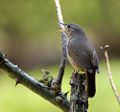
The wren
Wren
The wrens are passerine birds in the mainly New World family Troglodytidae. There are approximately 80 species of true wrens in approximately 20 genera....
s are mainly small and inconspicuous except for their loud songs. These birds have short wings and a thin down-turned bill. Several species often hold their tails upright. All are insectivorous. There are 80 species worldwide (of which all but one are New World species) and 23 species which occur in Panama.
- Black-capped DonacobiusBlack-capped DonacobiusThe Black-capped Donacobius is a conspicuous, vocal South American bird. It is found in tropical swamps and wetlands in Argentina, Bolivia, Brazil, Colombia, Ecuador, French Guiana, Guyana, Paraguay, Peru, Suriname, and Venezuela; also Panama of Central America.-Taxonomy:The Black-capped...
Donacobius atricapilla - White-headed WrenWhite-headed WrenThe White-headed Wren is a species of bird in the Troglodytidae family.It is found in Colombia and Panama.Its natural habitats are subtropical or tropical moist lowland forests and heavily degraded former forest....
Campylorhynchus albobrunneus - Band-backed WrenBand-backed WrenThe Band-backed Wren, Campylorhynchus zonatus, is a small songbird of the wren family.The Band-backed Wren is a resident breeding species from south-central Gulf Coast Mexico to northwestern Ecuador. It occurs in five disjunct areas, the central region being in southern Central America, in Costa...
Campylorhynchus zonatus - Black-throated WrenBlack-throated WrenThe Black-throated Wren is a species of bird in the Troglodytidae family.It is found in Costa Rica, Nicaragua, and Panama....
Thryothorus atrogularis - Sooty-headed WrenSooty-headed WrenThe Sooty-headed Wren is a species of bird in the Troglodytidae family.It is found in Colombia and Panama. Its natural habitats are subtropical or tropical moist lowland forests and subtropical or tropical moist montane forests.-References:* BirdLife International 2004. . Downloaded on 27...
Thryothorus spadix - Black-bellied WrenBlack-bellied WrenThe Black-bellied Wren is a species of bird in the Troglodytidae family. It is found in Colombia, Costa Rica, and Panama. Its natural habitats are subtropical or tropical moist lowland forests and heavily degraded former forest.-References:* BirdLife International 2004. . Downloaded on 27...
Thryothorus fasciatoventris - Rufous-breasted WrenRufous-breasted WrenThe Rufous-breasted Wren, Pheugopedius rutilus, is a small songbird of the wren family . It was formerly placed in the genus Thryothorus which in the old, broad sense was a motley assemblage of similar-looking wrens....
Thryothorus rutilus - Riverside WrenRiverside WrenThe Riverside Wren is a species of bird in the Troglodytidae family.It is found in Costa Rica and Panama.Its natural habitat is subtropical or tropical moist lowland forests.-References:...
Thryothorus semibadius - Bay WrenBay WrenThe Bay Wren is a species of bird in the Troglodytidae family.It is found in Colombia, Costa Rica, Ecuador, Nicaragua, and Panama....
Thryothorus nigricapillus - Stripe-breasted WrenStripe-breasted WrenThe Stripe-breasted Wren is a species of bird in the Troglodytidae family.It is found in Honduras, Nicaragua, Costa Rica, and Panama....
Thryothorus thoracicus - Stripe-throated WrenStripe-throated WrenThe Stripe-throated Wren is a species of bird in the Troglodytidae family.It is found in Colombia, Ecuador, and Panama. Its natural habitat is subtropical or tropical moist lowland forests.-References:...
Thryothorus leucopogon - Rufous-and-white WrenRufous-and-white WrenThe Rufous-and-white Wren, Thryophilus rufalbus, is a small songbird of the wren family. It is a resident breeding species from southwesternmost Mexico to northern Colombia and northwestern Venezuela...
Thryothorus rufalbus - Plain WrenPlain WrenThe Plain Wren is a species of bird in the Troglodytidae family.It is found in Belize, Costa Rica, El Salvador, Guatemala, Honduras, Mexico, Nicaragua, and Panama....
Thryothorus modestus - Canebrake Wren Thryothorus zeledoni
- Buff-breasted WrenBuff-breasted WrenThe Buff-breasted Wren is a species of bird in the Troglodytidae family, the wrens.It is found in the Amazon Basin of northern Brazil and Amazonian Colombia, Ecuador, Peru and northern-border Bolivia; also the Guianan countries Guyana, Suriname, French Guiana...
Thryothorus leucotis - House WrenHouse WrenThe House Wren, Troglodytes aedon, is a very small songbird of the wren family, Troglodytidae. It occurs from Canada to southernmost South America, and is thus the most widely distributed bird in the Americas. It occurs in most suburban areas in its range and it is the single most common wren...
Troglodytes aedon - Ochraceous WrenOchraceous WrenThe Ochraceous Wren, Troglodytes ochraceus, is a small songbird of the wren family. It is an endemic resident breeding species in Costa Rica and eastern Panama...
Troglodytes ochraceus - Sedge WrenSedge WrenThe Sedge Wren, Cistothorus platensis, is a small songbird of the Wren family. It was formerly known as the Short-billed Marsh Wren, and in South America is known as the Grass Wren. There are about 20 different subspecies which are found across most of the Americas...
Cistothorus platensis - Timberline WrenTimberline WrenThe Timberline Wren is a species of bird in the Troglodytidae family. It is monotypic within the genus Thryorchilus. It is found in Costa Rica and western Panama. Its natural habitat is subtropical or tropical moist montane forests.-References:* BirdLife International 2004. . Downloaded on 27...
Thryorchilus browni - White-breasted Wood-WrenWhite-breasted Wood-WrenThe White-breasted Wood-Wren, Henicorhina leucosticta, is a small songbird of the wren family. It is a resident breeding species from central Mexico to northeastern Peru and Surinam.-Description:...
Henicorhina leucosticta - Gray-breasted Wood-Wren Henicorhina leucophrys
- Scaly-breasted Wren Microcerculus marginatus
- Song WrenSong WrenThe Song Wren is a species of bird in the Troglodytidae family.It is found in Colombia, Costa Rica, Ecuador, Honduras, Nicaragua, and Panama. Its natural habitat is subtropical or tropical moist lowland forests....
Cyphorhinus phaeocephalus
Mockingbirds and allies

The mimids are a family of passerine birds that includes thrasher
Thrasher
Thrashers are a New World group of passerine birds related to mockingbirds and New World catbirds. Like these, they are in the Mimidae family. There are 15 species in one large and 4 monotypic genera.These do not form a clade but are a phenetic assemblage...
s, mockingbird
Mockingbird
Mockingbirds are a group of New World passerine birds from the Mimidae family. They are best known for the habit of some species mimicking the songs of other birds and the sounds of insects and amphibians, often loudly and in rapid succession. There are about 17 species in three genera...
s, trembler
Trembler
Tremblers are a New World group of passerine birds related to mockingbirds and New World catbirds. Like these, they are in the Mimidae family. There are 2-4 species in one genus, Cinclocerthia:...
s, and the New World catbirds. These birds are notable for their vocalizations, especially their ability to mimic a wide variety of birds and other sounds heard outdoors. Their colouring tends towards dull greys and browns . There are 35 species worldwide and 2 species which occur in Panama.
- Gray CatbirdGray CatbirdThe Gray Catbird , also spelled Grey Catbird, is a medium-sized northern American perching bird of the mimid family. It is the only member of the "catbird" genus Dumetella...
Dumetella carolinensis - Tropical MockingbirdTropical MockingbirdThe Tropical Mockingbird, Mimus gilvus, is a resident breeding bird from southern Mexico south to northern Brazil, and in the Lesser Antilles and other Caribbean islands. The birds in Panama and Trinidad may have been introduced. The Northern Mockingbird is its closest living relative, but the...
Mimus gilvus (I)
Thrushes and allies
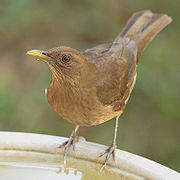
The thrushes
Thrush (bird)
The thrushes, family Turdidae, are a group of passerine birds that occur worldwide.-Characteristics:Thrushes are plump, soft-plumaged, small to medium-sized birds, inhabiting wooded areas, and often feed on the ground or eat small fruit. The smallest thrush may be the Forest Rock-thrush, at and...
are a group of passerine birds that occur mainly in the Old World. They are plump, soft plumaged, small to medium-sized insectivores or sometimes omnivores, often feeding on the ground. Many have attractive songs. There are 335 species worldwide and 16 species which occur in Panama.
- Black-faced SolitaireBlack-faced SolitaireThe Black-faced Solitaire, is a bird in the thrush family endemic to highlands in Costa Rica and western Panama.This is a bird of dense undergrowth and bamboo clumps in wet mountain forest, normally from 750 to 3000 m altitude. It disperse as low as 400 m in the wet season, when it may form...
Myadestes melanops - Varied SolitaireVaried SolitaireThe Varied Solitaire is a species of bird in the Turdidae family.It is found in the following countries Colombia and Panama.Its natural habitat is subtropical or tropical moist montanes or .-References:...
Myadestes coloratus - Orange-billed Nightingale-ThrushOrange-billed Nightingale-thrushThe Orange-billed Nightingale-thrush is a species of bird in the Turdidae family.It is found in Colombia, Costa Rica, El Salvador, Guatemala, Honduras, Mexico, Nicaragua, Panama, Trinidad and Tobago, and Venezuela....
Catharus aurantiirostris - Slaty-backed Nightingale-ThrushSlaty-backed Nightingale-thrushThe Slaty-backed Nightingale-thrush is a species of bird in the Turdidae family.It is found in Bolivia, Colombia, Costa Rica, Ecuador, Panama, Peru, and Venezuela....
Catharus fuscater - Black-billed Nightingale-ThrushBlack-billed Nightingale-thrushThe Black-billed Nightingale-thrush is a small thrush endemic to the highlands of Costa Rica and western Panama. Its position in the genus Catharus is somewhat equivocal, but it is apparently closer to the Hermit Thrush than to the other nightingale-thrushes except the Russet Nightingale-thrush...
Catharus gracilirostris - Ruddy-capped Nightingale-ThrushRuddy-capped Nightingale-thrushThe Ruddy-capped Nightingale-thrush is a small thrush which is a resident breeder in mountain forests from central Mexico to western Panama. A predominantly brown-plumaged bird, it has a rich song.-Taxonomy and naming:...
Catharus frantzii - Black-headed Nightingale-ThrushBlack-headed Nightingale-thrushThe Black-headed Nightingale-thrush is a species of bird in the Turdidae family. It is found in Costa Rica, Guatemala, Honduras, Mexico, Nicaragua, and Panama....
Catharus mexicanus - VeeryVeeryThe Veery, Catharus fuscescens, is a small thrush species. It is occasionally called Willow Thrush or Wilson's Thrush. It is a member of a close-knit group of migrant Catharus species, which also includes the cryptotaxa Grey-cheeked Thrush and Bicknell's Thrush The Veery, Catharus fuscescens, is a...
Catharus fuscescens - Gray-cheeked ThrushGray-cheeked ThrushThe Grey-cheeked Thrush, Catharus minimus, is a medium-sized thrush. This species is 15–17 cm in length, and has the white-dark-white underwing pattern characteristic of Catharus thrushes. It is a member of a close-knit group of migrant species together with the Veery and Bicknell's Thrush ;...
Catharus minimus - Swainson's ThrushSwainson's ThrushSwainson's Thrush , also called Olive-backed Thrush, is a medium-sized thrush. This species is 16–18 cm in length, and has the white-dark-white underwing pattern characteristic of Catharus thrushes...
Catharus ustulatus - Wood ThrushWood ThrushThe Wood Thrush, Hylocichla mustelina, is a North American passerine bird. It is closely related to other thrushes such as the American Robin and is widely distributed across North America, wintering in Central America and southern Mexico...
Hylocichla mustelina - Sooty Robin Turdus nigrescens
- Mountain Robin Turdus plebejus
- Pale-vented ThrushPale-vented ThrushThe Pale-vented Thrush is a species of bird in the Turdidae family.It is found in Colombia, Costa Rica, Ecuador, Panama, and Peru. Its natural habitats are subtropical or tropical moist lowland forests, subtropical or tropical moist montane forests, and heavily degraded former forest.-References:*...
Turdus obsoletus - Clay-colored Robin Turdus grayi
- White-throated ThrushWhite-throated ThrushThe White-throated Thrush is a species of bird in the Turdidae family.It is found in Belize, Colombia, Costa Rica, Ecuador, El Salvador, Guatemala, Honduras, Mexico, Nicaragua, Panama, and the United States....
Turdus assimilis
Gnatcatchers
Order: Passeriformes. Family: PolioptilidaeThese dainty birds resemble Old World warblers in their build and habits, moving restlessly through the foliage seeking insects. The gnatcatchers and gnatwrens are mainly soft bluish grey in colour, and have the typical insectivore's long sharp bill. They are birds of fairly open woodland or scrub, and nest in bushes or trees. There are 15 species worldwide and 4 species which occur in Panama.
- Tawny-faced GnatwrenTawny-faced GnatwrenThe Tawny-faced Gnatwren is a species of bird in the Polioptilidae family.It is found in Bolivia, Colombia, Costa Rica, Ecuador, French Guiana, Guyana, Nicaragua, Panama, Peru, Suriname, and Venezuela. Its natural habitat is subtropical or tropical moist lowland forests.-References:* BirdLife...
Microbates cinereiventris - Long-billed GnatwrenLong-billed GnatwrenThe Long-billed Gnatwren is a very small bird in the gnatcatcher family. It is the only member of the genus Ramphocaenus ....
Ramphocaenus melanurus - Tropical GnatcatcherTropical GnatcatcherThe Tropical Gnatcatcher is a small active insectivorous songbird, which is a resident species throughout a large part of the Neotropics...
Polioptila plumbea - Slate-throated GnatcatcherSlate-throated GnatcatcherThe Slate-throated Gnatcatcher is a species of bird in the Polioptilidae family.It is found in Colombia, Ecuador, and Panama.Its natural habitat is subtropical or tropical moist lowland forests.-References:...
Polioptila schistaceigula
Crows and jays
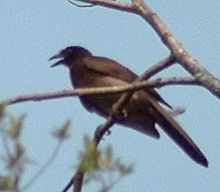
Corvidae
Corvidae is a cosmopolitan family of oscine passerine birds that contains the crows, ravens, rooks, jackdaws, jays, magpies, treepies, choughs and nutcrackers. The common English names used are corvids or the crow family , and there are over 120 species...
The Corvidae family includes crow
Crow
Crows form the genus Corvus in the family Corvidae. Ranging in size from the relatively small pigeon-size jackdaws to the Common Raven of the Holarctic region and Thick-billed Raven of the highlands of Ethiopia, the 40 or so members of this genus occur on all temperate continents and several...
s, raven
Raven
Raven is the common name given to several larger-bodied members of the genus Corvus—but in Europe and North America the Common Raven is normally implied...
s, jay
Jay
The jays are several species of medium-sized, usually colorful and noisy, passerine birds in the crow family Corvidae. The names jay and magpie are somewhat interchangeable, and the evolutionary relationships are rather complex...
s, chough
Chough
The Red-billed Chough or Chough , Pyrrhocorax pyrrhocorax, is a bird in the crow family; it is one of only two species in the genus Pyrrhocorax...
s, magpie
Magpie
Magpies are passerine birds of the crow family, Corvidae.In Europe, "magpie" is often used by English speakers as a synonym for the European Magpie, as there are no other magpies in Europe outside Iberia...
s, treepie
Treepie
The treepies comprise four closely related genera of long-tailed passerine birds in the family Corvidae...
s, nutcrackers
Nutcracker (bird)
The nutcrackers are a genus of two species of passerine bird, in the family Corvidae, related to the jays and crows. One, the Spotted Nutcracker , occurs in Europe and Asia, the other, Clark's Nutcracker , in western North America.The most important food resources for both these species are the...
, and ground jay
Ground jay
The ground jays or ground choughs belong to a distinct group of the passerine order of birds in the genus Podoces of the crow family Corvidae...
s. Corvids are above average in size for the bird order Passeriformes. Some of the larger species show high levels of learning behavior. There are 120 species worldwide and 5 species which occur in Panama.
- Black-chested JayBlack-chested JayThe Black-chested Jay is a species of bird in the Corvidae family.It is found in Colombia, Costa Rica, Panama, and Venezuela....
Cyanocorax affinis - Brown JayBrown JayThe Brown Jay is a large American Jay which has the habitus of a magpie, but is slightly smaller and with a shorter tail, though the bill is larger.It occurs from Mexico south into Central America on the Gulf slope...
Cyanocorax morio - Azure-hooded JayAzure-hooded JayThe Azure-hooded Jay, Cyanolyca cucullata, is a species of bird in the Corvidae family. It is found in Middle America. Its natural habitat is subtropical or tropical moist montane forest. This species is known to have four subspecies. It is in length and is dark blue with a black head and upper...
Cyanolyca cucullata - Silvery-throated JaySilvery-throated JayThe Silvery-throated Jay is a species of bird in the Corvidae family.It is found in Costa Rica and Panama.Its natural habitat is subtropical or tropical moist montanes.-References:...
Cyanolyca argentigula - Common RavenCommon RavenThe Common Raven , also known as the Northern Raven, is a large, all-black passerine bird. Found across the northern hemisphere, it is the most widely distributed of all corvids...
Corvus corax (A)
Starlings
Order: Passeriformes. Family: SturnidaeStarlings are small to medium-sized passerine birds. Their flight is strong and direct, and they are very gregarious. Their preferred habitat is fairly open country. They eat insects and fruit. Plumage is typically dark with a metallic sheen. There are 125 species worldwide and 1 species which occurs in Panama.
- European StarlingEuropean StarlingThe Common Starling , also known as the European Starling or just Starling, is a passerine bird in the family Sturnidae.This species of starling is native to most of temperate Europe and western Asia...
Sturnus vulgaris (A)
Vireos
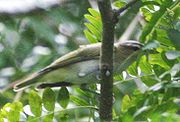
The vireo
Vireo
The vireos are a group of small to medium-sized passerine birds restricted to the New World. They are typically dull-plumaged and greenish in color, the smaller species resembling wood warblers apart from their heavier bills...
s are a group of small to medium sized passerine birds restricted to the New World. They are typically greenish in colour and resemble wood warbler
Wood Warbler
The Wood Warbler is a common and widespread leaf warbler which breeds throughout northern and temperate Europe, and just into the extreme west of Asia in the southern Ural Mountains...
s apart from their heavier bills. There are 52 species worldwide and 17 species which occur in Panama.
- White-eyed VireoWhite-eyed VireoThe White-eyed Vireo, Vireo griseus, is a small songbird. It breeds in the southeastern USA from New Jersey west to northern Missouri and south to Texas and Florida, and also in eastern Mexico, northern Central America, Cuba and the Bahamas....
Vireo griseus (A) - Yellow-throated VireoYellow-throated VireoThe Yellow-throated Vireo, Vireo flavifrons, is a small American songbird.Adults are mainly olive on the head and upperparts with a yellow throat and white belly; they have dark eyes with yellow "spectacles". The tail and wings are dark with white wing bars...
Vireo flavifrons - Blue-headed VireoBlue-headed VireoThe Blue-headed Vireo is a Neotropical migrating song bird found in North and Central America. There are currently two recognized sub-species that belong to the Blue-headed Vireo. It has a range that extends across Canada and the eastern coast of the United-States, Mexico and some of Central America...
Vireo solitarius (A) - Yellow-winged VireoYellow-winged VireoThe Yellow-winged Vireo, Vireo carmioli, is a small passerine bird. It is endemic to the highlands of Costa Rica and western Panama.This vireo occurs from 2000 m to the timberline in the canopy of mountain forest, sometimes feeding in undergrowth or tall second growth...
Vireo carmioli - Warbling VireoWarbling VireoThe Warbling Vireo, Vireo gilvus, is a small North American songbird.Its breeding habitat is open deciduous and mixed woods from Alaska to Mexico and the Florida Panhandle. It often nests along streams. It migrates to Mexico and Central America....
Vireo gilvus (A) - Brown-capped VireoBrown-capped VireoThe Brown-capped Vireo, Vireo leucophrys, is a small passerine bird. It breeds in highlands from southern Mexico south to northwestern Bolivia. It is sometimes considered to be conspecific with the similar Warbling Vireo....
Vireo leucophrys - Philadelphia VireoPhiladelphia VireoThe Philadelphia Vireo, Vireo philadelphicus, is a small songbird.Adults are mainly olive-brown on the upperparts with yellow underparts; they have dark eyes and a grey crown. There is a dark line through the eyes and a white stripe just over them. They have thick blue-grey legs and a stout...
Vireo philadelphicus - Red-eyed VireoRed-eyed VireoThe Red-eyed Vireo, Vireo olivaceus, is a small American songbird, 13–14 cm in length. It is somewhat warbler-like but not closely related to the New World warblers...
Vireo olivaceus - Yellow-green VireoYellow-green VireoThe Yellow-green Vireo, Vireo flavoviridis, is a small passerine bird. It breeds from southern Texas in the United States and the western and eastern mountain ranges of northern Mexico south to central Panama...
Vireo flavoviridis - Black-whiskered VireoBlack-whiskered VireoThe Black-whiskered Vireo, Vireo altiloquus, is a small passerine bird, which breeds in southern Florida, USA, and the West Indies as far south as the offshore islands of Venezuela. It is a partial migrant, with northern birds wintering from the Greater Antilles to northern South America...
Vireo altiloquus (A) - Scrub GreenletScrub GreenletThe Scrub Greenlet or Scrub Vireo, Hylophilus flavipes, is a small passerine bird in the vireo family. It breeds in Costa Rica, Panama, Colombia, Venezuela and Tobago....
Hylophilus flavipes - Tawny-crowned GreenletTawny-crowned GreenletThe Tawny-crowned Greenlet is a species of bird in the Vireonidae family. It is found in Belize, Bolivia, Brazil, Colombia, Costa Rica, Ecuador, French Guiana, Guatemala, Guyana, Honduras, Mexico, Nicaragua, Panama, Peru, Suriname, and Venezuela.Its natural habitat is subtropical or tropical moist...
Hylophilus ochraceiceps - Golden-fronted GreenletGolden-fronted GreenletThe Golden-fronted Greenlet, Hylophilus aurantiifrons, is a small passerine bird in the vireo family. It breeds in Panama, Colombia, Venezuela and Trinidad....
Hylophilus aurantiifrons - Lesser GreenletLesser GreenletThe Lesser Greenlet, Hylophilus decurtatus, is a small passerine bird in the vireo family. It breeds from northeastern Mexico south to western Ecuador....
Hylophilus decurtatus - Green Shrike-VireoGreen Shrike-vireoThe Green Shrike-vireo is a species of bird in the Vireonidae family.It is found in Belize, Colombia, Costa Rica, El Salvador, Guatemala, Honduras, Mexico, Nicaragua, and Panama....
Vireolanius pulchellus - Yellow-browed Shrike-VireoYellow-browed Shrike-vireoThe Yellow-browed Shrike-vireo is a species of bird in the Vireonidae family.It is found in Colombia, Panama, and Venezuela. Its natural habitats are subtropical or tropical moist lowland forests and subtropical or tropical moist montane forests.-References:* BirdLife International 2004. . ...
Vireolanius eximius - Rufous-browed PeppershrikeRufous-browed PeppershrikeThe Rufous-browed Peppershrike, Cyclarhis gujanensis, is a passerine bird in the vireo family. It is widespread and often common in woodland, forest edge, and cultivation with some tall trees from Mexico and Trinidad south to Argentina and Uruguay....
Cyclarhis gujanensis
New World warblers
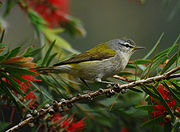

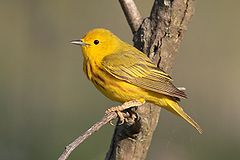
The New World warbler
New World warbler
The New World warblers or wood-warblers are a group of small, often colorful, passerine birds restricted to the New World. They are not related to the Old World warblers or the Australian warblers....
s are a group of small, often colourful, passerine birds restricted to the New World. Most are arboreal, but some are terrestrial. Most members of this family are insectivores. There are 119 species worldwide and 54 species which occur in Panama.
- Blue-winged WarblerBlue-winged WarblerThe Blue-winged Warbler, Vermivora cyanoptera, is a fairly common New World warbler, 11.5 cm long and weighing 8.5 g. It breeds in eastern North America in southern Ontario and the eastern USA. Its range is extending northwards, where it is replacing the very closely related...
Vermivora pinus - Golden-winged WarblerGolden-winged WarblerThe Golden-winged Warbler, Vermivora chrysoptera, is a New World warbler, 11.6 cm long and weighing 8.5 g. It breeds in eastern North America, southeastern Canada and the eastern USA...
Vermivora chrysoptera - Tennessee WarblerTennessee WarblerThe Tennessee Warbler, Oreothlypis peregrina, is a New World warbler. It breeds in northern North America across Canada and the northern USA. It is migratory, wintering in southern Central America and northern Colombia and Venezuela, with a few stragglers going as far south as Ecuador. It is a...
Vermivora peregrina - Nashville WarblerNashville WarblerThe Nashville Warbler, Vermivora ruficapilla, is a small songbird in the New World warbler family.They have olive-brown upperparts, a white belly and a yellow throat and breast; they have a white eye ring, no wing bars and a thin pointed bill. Adult males have a grey head with a rusty crown patch ;...
Vermivora ruficapilla (A) - Virginia's WarblerVirginia's WarblerVirginia's Warbler is a species of New World warbler.Despite what its name may suggest, Virginia's warbler is not actually named after the American State of Virginia, which makes sense as the birds range only reaches as far east as the state of Texas...
Vermivora virginiae (A) - Flame-throated WarblerFlame-throated WarblerThe Flame-throated Warbler, Oreothlypis gutturalis, is a small New World warbler. It is sometimes placed in the genus Vermivora.-Life history:...
Parula gutturalis - Northern ParulaNorthern ParulaThe Northern Parula, Parula americana, is a small New World warbler. It breeds in eastern North America from southern Canada to Florida....
Parula americana (A) - Tropical ParulaTropical ParulaThe Tropical Parula is a small New World warbler. It breeds from southernmost Texas and northwest Mexico south through Central America to northern Argentina, including Trinidad and Tobago. This widespread and common species is not considered threatened by the IUCN.This passerine is not migratory,...
Parula pitiayumi - Yellow WarblerYellow WarblerDendroica petechia is a New World warbler species or superspecies; the subspecies group around D. aestiva is increasingly treated as good species Dendroica aestiva again. The name for the entire cryptic species complex is Mangrove Warbler, and another group of subspecies is known as Golden Warbler...
Dendroica petechia - Chestnut-sided WarblerChestnut-sided WarblerThe Chestnut-sided Warbler is a New World warbler. They breed in eastern North America and in southern Canada westwards to the Canadian Prairies...
Dendroica pensylvanica - Magnolia WarblerMagnolia WarblerSetophaga magnolia, commonly known as the Magnolia warbler, is a member of the Parulidae family of wood warblers. [4] This warbler was first discovered in magnolia trees in the 19th century by famed ornithologist Alexander Wilson while in Mississippi. [7]-Description:The magnolia warbler can be...
Dendroica magnolia - Cape May WarblerCape May WarblerThe Cape May Warbler, Dendroica tigrina, is a small New World warbler. It breeds in northern North America. Its breeding habitat spans across all but the westernmost parts of southern Canada, and into the Great Lakes region and New England. It is migratory, wintering in the West Indies...
Dendroica tigrina - Black-throated Blue WarblerBlack-throated Blue WarblerThe Black-throated Blue Warbler, Setophaga caerulescens, is a small songbird of the New World warbler family.Adult males have white underparts with black throat, face and flanks; the upperparts are deep blue; immature males are similar with upperparts more greenish...
Dendroica caerulescens (A) - Yellow-rumped WarblerYellow-rumped WarblerFour closely related North American bird forms—the eastern Myrtle Warbler , its western counterpart, Audubon's Warbler , the northwest Mexican Black-fronted Warbler , and the Guatemalan Goldman's Warbler —are periodically lumped as the Yellow-rumped Warbler .-Classification:Since...
Dendroica coronata - Golden-cheeked WarblerGolden-cheeked WarblerThe Golden-cheeked Warbler Dendroica chrysoparia is an endangered species of bird that breeds in Central Texas, from Palo Pinto County southwestward along the eastern and southern edge of the Edwards Plateau to Kinney County...
Dendroica chrysoparia (A) - Black-throated Green WarblerBlack-throated Green WarblerThe Black-throated Green Warbler, Setophaga virens, is a small songbird of the New World warbler family.It is 12 cm long and weighs 9 g, and has an olive-green crown, a yellow face with olive markings, a thin pointed bill, white wing bars, an olive-green back and pale underparts with...
Dendroica virens - Townsend's WarblerTownsend's WarblerThe Townsend's Warbler, Dendroica townsendi, is a small songbird of the New World warbler family.These birds have a yellow face with a black stripe across their cheeks, a thin pointed bill, white wing bars, olive upperparts with black streaks on their backs and flanks, and a white belly...
Dendroica townsendi (A) - Hermit WarblerHermit WarblerThe Hermit Warbler, Dendroica occidentalis, is a small perching bird. It is a species of New World warbler.Mature Hermit Warblers normally grow to be 4½ to 5 inches long. Hermit Warblers are dark gray in coloration on top, and white below, and their flanks are streaked with black. The wings...
Dendroica occidentalis (A) - Blackburnian WarblerBlackburnian WarblerThe Blackburnian Warbler, Dendroica fusca , is a small New World warbler. They breed in eastern North America, from southern Canada, westwards to the southern Canadian Prairies, the Great Lakes region and New England, to North Carolina....
Dendroica fusca - Yellow-throated WarblerYellow-throated WarblerThe Yellow-throated Warbler, Dendroica dominica, is a small migratory songbird species breeding in temperate North America. It belongs to the New World warbler family .-Description:...
Dendroica dominica (A) - Prairie WarblerPrairie WarblerThe Prairie Warbler, Dendroica discolor, is a small songbird of the New World warbler family.These birds have yellow underparts with dark streaks on the flanks, and olive upperparts with rusty streaks on the back; they have a yellow line above the eye, a dark line through it, and a yellow spot...
Dendroica discolor (A) - Palm WarblerPalm WarblerThe Palm Warbler, Dendroica palmarum, is a small songbird of the New World warbler family.The species comprises two distinct subspecies that may merit specific status....
Dendroica palmarum - Bay-breasted WarblerBay-breasted WarblerThe Bay-breasted Warbler, Dendroica castanea , is a New World warbler. They breed in northern North America, specifically in Canada, into the Great Lakes region, and into northern New England....
Dendroica castanea - Blackpoll WarblerBlackpoll WarblerThe Blackpoll Warbler, Dendroica striata , is a New World warbler. Breeding males are mostly black and white. They have a prominent black cap, white cheeks and white wing bars. The Blackpoll breeds in northern North America, from Alaska, through most of Canada, and into the Great Lakes region and...
Dendroica striata (A) - Cerulean WarblerCerulean WarblerThe Cerulean Warbler, Dendroica cerulea, is a small songbird of the New World warbler family.-Description:Adult males have pale cerulean blue upperparts and white underparts with a black necklace across the breast; they also have black streaks on the back and flanks...
Dendroica cerulea - Black-and-white WarblerBlack-and-white WarblerThe Black-and-white Warbler is a small New World warbler. It breeds in northern and eastern North America from southern Canada to Florida....
Mniotilta varia - American RedstartAmerican RedstartThe American Redstart is a New World warbler. It is the only member of its genus and is unrelated to the Old World redstarts. It derives its name from the male's red tail, start being an old word for tail.-Description:...
Setophaga ruticilla - Prothonotary WarblerProthonotary WarblerThe Prothonotary Warbler is a small songbird of the New World warbler family. It is the only member of the genus Protonotaria....
Protonotaria citrea - Worm-eating WarblerWorm-eating WarblerThe Worm-eating Warbler is a small New World warbler. It is the only species classified in the genus Helmitheros....
Helmitheros vermivorus - Swainson's WarblerSwainson's WarblerSwainson's Warbler, Limnothlypis swainsonii, is a small species of New World warbler. It is monotypic, the only member of the genus Limnothlypis.-Description:...
Lymnothlypis swainsonii (A) - OvenbirdOvenbirdThe Ovenbird is a small songbird of the New World warbler family . This migratory bird breeds in eastern North America and moves south in winter.-Taxonomy:...
Seiurus aurocapilla - Northern WaterthrushNorthern WaterthrushThe Northern Waterthrush is one of the larger New World warblers. It breeds in the northern part of North America in Canada, and in the northern United States, . This bird is migratory, wintering in Central America, the West Indies, and Florida; also Venezuela, Colombia, and Ecuador...
Seiurus noveboracensis - Louisiana WaterthrushLouisiana WaterthrushThe Louisiana Waterthrush is a New World warbler. It breeds in eastern North America from southernmost Canada and south through the eastern USA, excluding Florida and the coast....
Seiurus motacilla - Kentucky WarblerKentucky WarblerThe Kentucky Warbler, Oporornis formosus, is a small species of New World warbler. The Kentucky Warbler, like all members of the genus Oporornis, is a sluggish and heavy warbler with a short tail, preferring to spend most of its time on or near the ground, except when singing.Adult Kentucky...
Oporornis formosus - Connecticut WarblerConnecticut WarblerThe Connecticut Warbler Oporornis agilis is a small songbird of the New World warbler family.These 15 cm long birds have light yellow underparts and olive upperparts; they have a light eye ring, pink legs, a long tail, pale wing bars and a thin pointed bill...
Oporornis agilis (A) - Mourning WarblerMourning WarblerThe Mourning Warbler, Oporornis philadelphia, is a small songbird of the New World warbler family.These 13 cm long birds have yellow underparts, olive-green upperparts and pink legs. Adult males have a grey hood and a black patch on the throat and breast...
Oporornis philadelphia - MacGillivray's WarblerMacGillivray's WarblerThe MacGillivray's Warbler, Oporornis tolmiei, is a small species of New World warbler. Like all members of the genus Oporornis, these birds are sluggish and heavy warblers with short tails, preferring to spend most of their time on, or near the ground, except when singing.The MacGillivray's...
Oporornis tolmiei (A) - Common YellowthroatCommon YellowthroatThe Common Yellowthroat is a New World warbler. They are abundant breeders in North America, ranging from southern Canada to central Mexico....
Geothlypis trichas (A) - Olive-crowned YellowthroatOlive-crowned YellowthroatThe Olive-crowned Yellowthroat is a species of bird in the Parulidae family.It is found in Colombia, Costa Rica, Ecuador, Honduras, Mexico, Nicaragua, and Panama....
Geothlypis semiflava - Masked YellowthroatMasked YellowthroatThe Masked Yellowthroat, Geothlypis aequinoctialis, is a New World warbler. It has a number of separate resident breeding populations in Central and South America, some of which may be considered to form separate species....
Geothlypis aequinoctialis - Gray-crowned Yellowthroat Geothlypis poliocephala
- Hooded WarblerHooded WarblerThe Hooded Warbler, Wilsonia citrina, is a New World warbler. It breeds in eastern North America and across the eastern USA and into southernmost Canada, . It is migratory, wintering in Central America and the West Indies...
Wilsonia citrina - Wilson's WarblerWilson's WarblerThe Wilson's Warbler, Wilsonia pusilla, is a small New World warbler. It is primarily greenish above and yellow below, with rounded wings and a long, slim tail. The male has a black crown patch which is greatly reduced or missing entirely in the female...
Wilsonia pusilla - Canada WarblerCanada WarblerThe Canada Warbler is a small 13 cm long songbird of the New World warbler family.These birds have yellow underparts, blue-grey upperparts and pink legs; they also have yellow eye-rings and thin, pointed bills. Adult males have black foreheads and black necklaces...
Wilsonia canadensis - Slate-throated RedstartSlate-throated RedstartThe Slate-throated Whitestart , or, less accurately, the Slate-throated Redstart, is a species of bird in the Parulidae family....
Myioborus miniatus - Collared RedstartCollared RedstartThe Collared Redstart is a tropical New World warbler endemic to the mountains of Costa Rica and western Panama...
Myioborus torquatus - Golden-crowned WarblerGolden-crowned WarblerThe Golden-crowned Warbler, Basileuterus culicivorus, is a small New World warbler.-Distribution and habitat:It breeds from Mexico and south through Central America to northeastern Argentina and Uruguay, and on Trinidad. It is a species mainly of lowland forests.-Description:The Golden-crowned...
Basileuterus culicivorus - Rufous-capped WarblerRufous-capped WarblerThe Rufous-capped Warbler is a New World warbler native from Mexico south to much of Central America, rarely occurring as far north as southeastern Arizona and south Texas....
Basileuterus rufifrons - Black-cheeked WarblerBlack-cheeked WarblerThe Black-cheeked Warbler is a New World warbler which is a resident breeding bird endemic to the mountains of central and southern Costa Rica and western Panama....
Basileuterus melanogenys - Pirre WarblerPirre WarblerThe Pirre Warbler is a species of bird in the Parulidae family.It is found in Colombia and Panama.Its natural habitat is subtropical or tropical moist montanes.It is threatened by habitat loss.-References:...
Basileuterus ignotus - Three-striped WarblerThree-striped WarblerThe Three-striped Warbler is a species of bird in the Parulidae family.It is found in Bolivia, Colombia, Costa Rica, Ecuador, Panama, Peru, and Venezuela. Its natural habitats are subtropical or tropical moist montane forests and heavily degraded former forest.-References:* BirdLife International...
Basileuterus tristriatus - Buff-rumped WarblerBuff-rumped WarblerThe Buff-rumped Warbler is a New World warbler is a resident bird from Honduras south to northwestern Peru and disjunctly in the western Amazon...
Basileuterus fulvicauda - WrenthrushWrenthrushThe Wrenthrush or Zeledonia is a species of New World warbler that is endemic to Costa Rica and western Panama. It has a short tail, rounded wings and elongated tarsi....
Zeledonia coronata - Yellow-breasted ChatYellow-breasted ChatThe Yellow-breasted Chat is a large songbird, formerly considered the most atypical member of the New World warbler family, though the long-standing suspicion is that it does not actually belong there. Its placement is not definitely resolved. It is the only member of the genus Icteria...
Icteria virens
Bananaquit

The Bananaquit is a small passerine bird. It has a slender, curved bill, adapted to taking nectar from flowers and is the only member of the genus Coereba (Vieillot, 1809) and is normally placed within the family Coerebidae, although there is uncertainty whether that placement is correct.
- BananaquitBananaquitThe Bananaquit is a species of passerine bird of uncertain relation. It is tentatively placed in the tanager family, but classified as incertae sedis by other authorities such as the American Ornithologists' Union. Its classification is debated, and it is often placed in its own family: Coerebidae...
Coereba flaveola
Tanagers
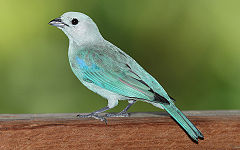
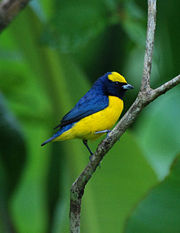

The tanager
Tanager
The tanagers comprise the bird family Thraupidae, in the order Passeriformes. The family has an American distribution.There were traditionally about 240 species of tanagers, but the taxonomic treatment of this family's members is currently in a state of flux...
s are a large group of small to medium-sized passerine birds restricted to the New World, mainly in the tropics. Many species are brightly coloured. They are seed eaters, but their preference tends towards fruit and nectar. Most have short, rounded wings. There are 256 species worldwide and 66 species which occur in Panama.
- White-eared ConebillWhite-eared ConebillThe White-eared Conebill is a species of bird in the Thraupidae family.It is found in Colombia, Panama, and Venezuela. Its natural habitats are subtropical or tropical moist lowland forests and heavily degraded former forest.-References:* BirdLife International 2004. . Downloaded on 25 July...
Conirostrum leucogenys - Common Bush-TanagerCommon Bush-TanagerThe Common Bush-tanager is a small passerine bird. It is a resident breeder in the highlands from central Mexico south to Bolivia and northwest Argentina. C. ophthalmicus in the loose sense is a notorious cryptic species complex, and several of the up to 25 subspecies recognized in recent times...
Chlorospingus ophthalmicus - Tacarcuna Bush-TanagerTacarcuna Bush-tanagerThe Tacarcuna Bush-tanager is a species of bird in the Thraupidae family.It is found in Colombia and Panama.Its natural habitat is subtropical or tropical moist montanes.-References:...
Chlorospingus tacarcunae - Pirre Bush-TanagerPirre Bush-tanagerThe Pirre Bush-tanager is a species of bird in the Thraupidae family.It is endemic to Panama.Its natural habitat is subtropical or tropical moist montanes.-References:...
Chlorospingus inornatus (E) - Sooty-capped Bush-TanagerSooty-capped Bush-TanagerThe Sooty-capped Bush-Tanager, Chlorospingus pileatus, is a small passerine bird. This tanager is an endemic resident breeder in the highlands of Costa Rica and western Panama....
Chlorospingus pileatus - Yellow-throated Bush-TanagerYellow-throated Bush-tanagerThe Yellow-throated Bush-tanager is a species of bird in the Thraupidae family. It is found in Bolivia, Colombia, Ecuador, Panama, and Peru....
Chlorospingus flavigularis - Ashy-throated Bush-TanagerAshy-throated Bush-tanagerThe Ashy-throated Bush-tanager is a species of bird in the Thraupidae family.It is found in Colombia, Costa Rica, Ecuador, Panama, Peru, and Venezuela....
Chlorospingus canigularis - Yellow-backed TanagerYellow-backed TanagerThe Yellow-backed Tanager is a species of bird in the Thraupidae family, the tanagers.It is found in Bolivia, Brazil, Colombia, Ecuador, French Guiana, Guyana, Peru, Suriname; also extreme eastern Panama in Central America...
Hemithraupis flavicollis - Black-and-yellow TanagerBlack-and-yellow TanagerThe Black-and-yellow Tanager is a fairly small passerine bird. This tanager is an endemic resident in the hills of Costa Rica and Panama...
Chrysothlypis chrysomelaena - Rosy Thrush-TanagerRosy Thrush-tanagerThe Rosy Thrush-tanager is a species of bird in the Thraupidae family, where it belongs to the presently monotypic genus Rhodinocichla.It is found in Colombia, Costa Rica, Mexico, Panama, and Venezuela...
Rhodinocichla rosea - Dusky-faced TanagerDusky-faced TanagerThe Dusky-faced Tanager is a species of bird in the Thraupidae family.It is found in Colombia, Costa Rica, Ecuador, Panama, and Venezuela. Its natural habitats are subtropical or tropical moist lowland forests and heavily degraded former forest.-References:* BirdLife International 2004. . ...
Mitrospingus cassinii - Olive TanagerOlive TanagerThe Olive Tanager , also known as Carmiol's Tanager , is a species of bird traditionally placed in the family Thraupidae , though some recent evidence suggest it is better placed in Cardinalidae .It is often split into two species:* Carmiol's Tanager The Olive Tanager (Chlorothraupis carmioli),...
Chlorothraupis carmioli - Lemon-spectacled TanagerLemon-spectacled TanagerThe Lemon-spectacled Tanager is a species of bird in the Cardinalidae family.It is found in Colombia, Ecuador, and Panama....
Chlorothraupis olivacea - Gray-headed Tanager Eucometis penicillata
- White-throated Shrike-TanagerWhite-throated Shrike-tanagerThe White-throated Shrike-tanager is a species of bird in the Thraupidae family.It is found in Costa Rica, Honduras, Nicaragua, and Panama.Its natural habitat is subtropical or tropical moist lowland forests.-References:...
Lanio leucothorax - Sulphur-rumped TanagerSulphur-rumped TanagerThe Sulphur-rumped Tanager is a species of bird in the Thraupidae family.It is found in Costa Rica and Panama.Its natural habitat is subtropical or tropical moist lowland forests.-References:...
Heterospingus rubrifrons - Scarlet-browed TanagerScarlet-browed TanagerThe Scarlet-browed Tanager is a species of bird in the Thraupidae family.It is found in Colombia, Ecuador, and Panama. Its natural habitat is subtropical or tropical moist lowland forests.-References:...
Heterospingus xanthopygius - White-shouldered TanagerWhite-shouldered TanagerThe White-shouldered Tanager, Tachyphonus luctuosus, is a medium-sized passerine bird. This tanager is a resident breeder from Honduras to Panama, South America south to Ecuador and southern Brazil, and on Trinidad....
Tachyphonus luctuosus - Tawny-crested TanagerTawny-crested TanagerThe Tawny-crested Tanager is a species of bird in the Thraupidae family.It is found in Colombia, Costa Rica, Ecuador, Honduras, Nicaragua, and Panama....
Tachyphonus delatrii - White-lined TanagerWhite-lined TanagerThe White-lined Tanager, Tachyphonus rufus, is a medium-sized passerine bird. This tanager is a resident breeder from Costa Rica south to northern Argentina, and on Trinidad and Tobago.It occurs in semi-open areas including gardens...
Tachyphonus rufus - Red-crowned Ant-TanagerRed-crowned Ant-TanagerThe Red-crowned Ant-Tanager, Habia rubica, is a medium-sized passerine bird from tropical America. The genus Habia was long placed with the tanagers , but it is actually closer to the cardinals...
Habia rubica - Red-throated Ant-TanagerRed-throated Ant-TanagerThe Red-throated Ant-tanager, Habia fuscicauda, is a medium-sized passerine bird. This species is a resident breeder on the Caribbean slopes from southeastern Mexico to eastern Panama. It was usually considered an aberrant kind of tanager and placed in the Thraupidae, but is actually closer to the...
Habia fuscicauda - Hepatic TanagerHepatic TanagerThe Hepatic Tanager, Piranga flava, is a medium-sized American songbird. Formerly placed in the tanager family , it and other members of its genus are now classified in the cardinal family...
Piranga flava - Scarlet TanagerScarlet TanagerThe Scarlet Tanager is a medium-sized American songbird. Formerly placed in the tanager family , it and other members of its genus are now classified in the cardinal family . The species's plumage and vocalizations are similar to other members of the cardinal family.-Description:Adults have pale...
Piranga olivacea - Summer TanagerSummer TanagerThe Summer Tanager, Piranga rubra, is a medium-sized American songbird. Formerly placed in the tanager family , it and other members of its genus are now classified in the cardinal family...
Piranga rubra - Western TanagerWestern TanagerThe Western Tanager, Piranga ludoviciana, is a medium-sized American songbird. Formerly placed in the tanager family , it and other members of its genus are now classified in the cardinal family...
Piranga ludoviciana - Flame-colored TanagerFlame-colored TanagerThe Flame-colored Tanager, Piranga bidentata, formerly known as the Stripe-backed Tanager, is a medium-sized American songbird. Formerly placed in the tanager family , it and other members of its genus are now classified in the cardinal family...
Piranga bidentata - White-winged TanagerWhite-winged TanagerThe White-winged Tanager is a medium-sized American songbird. Formerly placed in the tanager family , it and other members of its genus are now classified in the cardinal family . The species's plumage and vocalizations are similar to other members of the cardinal family...
Piranga leucoptera - Crimson-collared TanagerCrimson-collared TanagerThe Crimson-collared Tanager, Ramphocelus sanguinolentus, is a rather small Middle American songbird. It was first described by the French naturalist René-Primevère Lesson in 1831, its specific epithet from the Latin adjective sanguinolentus, "bloodied", referring to its red plumage.-Taxonomy:This...
Ramphocelus sanguinolentus - Crimson-backed TanagerCrimson-backed TanagerThe Crimson-backed Tanager is a species of bird in the Thraupidae family. It is found in Colombia, French Guyana, Panama, and Venezuela. Its natural habitats are subtropical or tropical moist lowland forests and heavily degraded former forest...
Ramphocelus dimidiatus - Passerini's TanagerPasserini's TanagerPasserini's Tanager, Ramphocelus passerinii, is a medium-sized passerine bird. This tanager is a resident breeder in the Caribbean lowlands from southern Mexico to western Panama...
Ramphocelus passerinii - Cherrie's TanagerCherrie's TanagerThe Cherrie's Tanager, Ramphocelus costaricensis, is a medium-sized passerine bird. This tanager is a resident breeder in the Pacific lowlands of Costa Rica and western Panama. This bird was formerly known as the Scarlet-rumped Tanager, but was split as a separate species from the Caribbean form,...
Ramphocelus costaricensis - Flame-rumped TanagerFlame-rumped TanagerThe Flame-rumped Tanager is a species of bird in the Thraupidae family. It is found in semi-open forest and woodland....
Ramphocelus flammigerus - Blue-gray TanagerBlue-gray TanagerThe Blue-grey Tanager, Thraupis episcopus, is a medium-sized South American songbird of the Tanager family, Thraupidae. Its range is from Mexico south to northeast Bolivia and northern Brazil, all of the Amazon Basin, except the very south. It has been introduced to Lima...
Thraupis episcopus - Palm TanagerPalm TanagerThe Palm Tanager, Thraupis palmarum, is a medium-sized passerine bird. This tanager is a resident breeder from Nicaragua south to Bolivia, Paraguay and southern Brazil. It also breeds on Trinidad and, since 1962, on Tobago...
Thraupis palmarum - Blue-and-gold TanagerBlue-and-gold TanagerThe Blue-and-gold Tanager is a species of bird in the Thraupidae family.It is found in Costa Rica and Panama.Its natural habitats are subtropical or tropical moist lowland forests and subtropical or tropical moist montanes....
Bangsia arcaei - Yellow-crowned EuphoniaYellow-crowned EuphoniaThe Yellow-crowned Euphonia is a species of bird in the Thraupidae family.It is found in Costa Rica, Nicaragua, and Panama, and is perhaps the most common euphonia in its range....
Euphonia luteicapilla - Thick-billed EuphoniaThick-billed EuphoniaThe Thick-billed Euphonia is a species of bird in the family Fringillidae, formerly placed in the Thraupidae.It is found in Bolivia, Brazil, Colombia, Costa Rica, Ecuador, Panama, Peru, and Venezuela...
Euphonia laniirostris - Yellow-throated EuphoniaYellow-throated EuphoniaThe Yellow-throated Euphonia is a species of bird in the Thraupidae family. It is found in Belize, Colombia, Costa Rica, El Salvador, Guatemala, Honduras, Mexico, Nicaragua, and Panama....
Euphonia hirundinacea (A) - Elegant Euphonia Euphonia elegantissima
- Spot-crowned EuphoniaSpot-crowned EuphoniaThe Spot-crowned Euphonia is a species of bird in the Thraupidae family.It is found in Costa Rica and Panama.Its natural habitats are subtropical or tropical moist lowland forests and heavily degraded former forest.-References:...
Euphonia imitans - Fulvous-vented EuphoniaFulvous-vented EuphoniaThe Fulvous-vented Euphonia is a species of bird in the family Fringillidae, formerly placed in the Thraupidae...
Euphonia fulvicrissa - Olive-backed EuphoniaOlive-backed EuphoniaThe Olive-backed Euphonia, Euphonia gouldi, is a small passerine bird in the finch family. It is a resident breeder in the Caribbean lowlands and foothills from southern Mexico to western Panama....
Euphonia gouldi - White-vented EuphoniaWhite-vented EuphoniaThe White-vented Euphonia is a species of bird in the Thraupidae family.It is found in Belize, Bolivia, Brazil, Colombia, Costa Rica, Ecuador, French Guiana, Guatemala, Guyana, Honduras, Mexico, Nicaragua, Panama, Peru, Suriname, and Venezuela.Its natural habitats are subtropical or tropical moist...
Euphonia minuta - Tawny-capped EuphoniaTawny-capped EuphoniaThe Tawny-capped Euphonia is a species of bird in the Thraupidae family.It is found in Colombia, Costa Rica, and Panama....
Euphonia anneae - Orange-bellied EuphoniaOrange-bellied EuphoniaThe Orange-bellied Euphonia is a species of bird in the Fringillidae family. They were formerly considered tanagers . It is found in Bolivia, Brazil, Colombia, Ecuador, Guyana, Panama, Peru, and Venezuela...
Euphonia xanthogaster - Yellow-collared ChlorophoniaYellow-collared ChlorophoniaThe Yellow-collared Chlorophonia is a bird species in the family Fringillidae .It is found in Colombia, Ecuador, and Panama....
Chlorophonia flavirostris (A) - Golden-browed ChlorophoniaGolden-browed ChlorophoniaThe Golden-browed Chlorophonia is a species of bird in the Thraupidae family.It is found in Costa Rica and Panama.Its natural habitat is subtropical or tropical moist montanes.-References:...
Chlorophonia callophrys - Plain-colored Tanager Tangara inornata
- Gray-and-gold Tanager Tangara palmeri
- Emerald TanagerEmerald TanagerThe Emerald Tanager is a species of bird in the Thraupidae family.It is found in Colombia, Costa Rica, Ecuador, and Panama....
Tangara florida - Silver-throated TanagerSilver-throated TanagerThe Silver-throated Tanager, Tangara icterocephala, is a small passerine bird. This brightly coloured tanager is a resident from Costa Rica, through Panama and western Colombia, to western Ecuador.-Habitat:...
Tangara icterocephala - Speckled TanagerSpeckled TanagerThe Speckled Tanager, Tangara guttata, is a medium-sized passerine bird. This tanager is a resident breeder in Costa Rica, Panama, Trinidad, Venezuela, Colombia and the extreme north of Brazil....
Tangara guttata - Bay-headed TanagerBay-headed TanagerThe Bay-headed Tanager, Tangara gyrola, is a medium-sized passerine bird. This tanager is a resident breeder in Costa Rica, Panama, South America south to Ecuador, Bolivia and southern Brazil, and on Trinidad....
Tangara gyrola - Rufous-winged TanagerRufous-winged TanagerThe Rufous-winged Tanager is a species of bird in the Thraupidae family.It is found in Belize, Colombia, Costa Rica, Ecuador, Guatemala, Honduras, Nicaragua, and Panama....
Tangara lavinia - Golden-hooded TanagerGolden-hooded TanagerThe Golden-hooded Tanager, Tangara larvata, is a medium-sized passerine bird. This tanager is a resident breeder from southern Mexico south to western Ecuador....
Tangara larvata - Spangle-cheeked TanagerSpangle-cheeked TanagerThe Spangle-cheeked Tanager, Tangara dowii, is a medium-sized passerine bird. This tanager is an endemic resident breeder in the highlands of Costa Rica and western Panama....
Tangara dowii - Green-naped TanagerGreen-naped TanagerThe Green-naped Tanager is a species of bird in the Thraupidae family.It is found in Colombia and Panama.Its natural habitat is subtropical or tropical moist montanes.It is threatened by habitat loss.-References:...
Tangara fucosa (E) - Scarlet-thighed DacnisScarlet-thighed DacnisThe Scarlet-thighed Dacnis is a tanager 4¾" long. It is found in Costa Rica, Colombia, Ecuador and Panama.-Description:Iris bright red in male, duller red in female...
Dacnis venusta - Blue DacnisBlue DacnisThe Blue Dacnis or Turquoise Honeycreeper, Dacnis cayana, is a small passerine bird. This member of the tanager family is found from Nicaragua to Panama, on Trinidad, and in South America south to Bolivia and northern Argentina...
Dacnis cayana - Viridian DacnisViridian DacnisThe Viridian Dacnis is a species of bird in the Thraupidae family.It is found in Colombia and Panama.Its natural habitat is subtropical or tropical moist lowland forests.It is threatened by habitat loss.-References:...
Dacnis viguieri - Green HoneycreeperGreen HoneycreeperThe Green Honeycreeper is a small bird in the tanager family. It is found in the tropical New World from southern Mexico south to Brazil, and on Trinidad. It the only member of the genus Chlorophanes...
Chlorophanes spiza - Shining HoneycreeperShining HoneycreeperThe Shining Honeycreeper is a small bird in the tanager family. It is found in the tropical New World in Central America from southern Mexico to Panama and northwest Colombia. It is sometimes considered to be conspecific with the Purple Honeycreeper The Shining Honeycreeper (Cyanerpes lucidus) is...
Cyanerpes lucidus - Purple HoneycreeperPurple HoneycreeperThe Purple Honeycreeper, Cyanerpes caeruleus, is a small bird in the tanager family. It is found in the tropical New World from Colombia and Venezuela south to Brazil, and on Trinidad. A few, possibly introduced birds have been recorded on Tobago...
Cyanerpes caeruleus - Red-legged HoneycreeperRed-legged HoneycreeperThe Red-legged Honeycreeper is a small songbird species in the tanager family . It is found in the tropical New World from southern Mexico south to Peru, Bolivia and central Brazil, Trinidad and Tobago, and on Cuba, where possibly introduced.-Description:The Red-legged Honeycreeper is on average...
Cyanerpes cyaneus - Swallow-Tanager Tersina viridis
Buntings, sparrows, seedeaters and allies
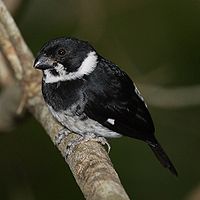

Emberizidae
The Emberizidae are a large family of passerine birds. They are seed-eating birds with a distinctively shaped bill.In Europe, most species are called buntings. In North America, most of the species in this family are known as sparrows, but these birds are not closely related to the sparrows, the...
The emberizids are a large family of passerine birds. They are seed-eating birds with a distinctively shaped bill. In Europe, most species are named as buntings. In North America, most of the species in this family are known as Sparrows, but these birds are not closely related to the Old World sparrows which are in the family Passeridae. Many emberizid species have distinctive head patterns. There are species 275 worldwide and 35 species which occur in Panama.
- Blue-black GrassquitBlue-black GrassquitThe Blue-black Grassquit is a small bird in the tanager family, Thraupidae. It was previously classified in the bunting and American sparrow family, Emberizidae. It breeds from southern Mexico through Central America, and South America as far as northern Chile, Argentina and Paraguay, and on...
Volatinia jacarina - Slate-colored Seedeater Sporophila schistacea
- Variable SeedeaterVariable SeedeaterThe Variable Seedeater, Sporophila corvina, is a passerine bird which breeds from southern Mexico through Central America to the Chocó of north-western South America. The taxonomy is confusing, and it was formerly considered a subspecies of Sporophila americana...
Sporophila corvina - White-collared SeedeaterWhite-collared SeedeaterThe White-collared Seedeater is a passerine bird in the typical seedeater genus Sporophila.-Taxonomy:The subspecies S. t...
Sporophila torqueola - Lesson's SeedeaterLesson's SeedeaterLesson's Seedeater is a bird species in the family Thraupidae .It is found in Bolivia, Brazil, Colombia, Ecuador, French Guiana, Guyana, Panama, Peru, Suriname, Trinidad and Tobago, and Venezuela...
Sporophila bouvronides (A) - Lined SeedeaterLined SeedeaterThe Lined Seedeater is a species of bird in the Thraupidae family.It is found in Argentina, Bolivia, Brazil, Colombia, Ecuador, French Guiana, Guyana, Panama, Paraguay, Peru, Suriname, and Venezuela...
Sporophila lineola (A) - Yellow-bellied SeedeaterYellow-bellied SeedeaterThe Yellow-bellied Seedeater is a species of bird in the Thraupidae family, formerly placed with the American sparrows in the Emberizidae....
Sporophila nigricollis - Ruddy-breasted SeedeaterRuddy-breasted SeedeaterThe Ruddy-breasted Seedeater is a species of bird in the Thraupidae family.It is found in Brazil, Colombia, Costa Rica, Ecuador, El Salvador, French Guiana, Guatemala, Guyana, Honduras, Mexico, Nicaragua, Panama, Suriname, Trinidad and Tobago, and Venezuela.Its natural habitats are dry savanna,...
Sporophila minuta - Nicaraguan Seed-FinchNicaraguan Seed-finchThe Nicaraguan Seed-finch is a species of bird in the Thraupidae family. It is found in Costa Rica, Nicaragua, and Panama....
Oryzoborus nuttingi - Thick-billed Seed-FinchThick-billed Seed-finchThe Thick-billed Seed-finch is a species of bird in the Thraupidae family, but was until recently placed in Emberizidae. It is found widely in shrubby and grassy areas from southern Mexico, through Central America, to the Chocó in Colombia and Ecuador...
Oryzoborus funereus - Blue SeedeaterBlue SeedeaterThe Blue Seedeater is a species of bird in the family Cardinalidae. It was formerly placed with the American sparrows in the Emberizidae. It is found in highland forest and woodland, mainly near bamboo, in southern Mexico and Central America with a disjunct population in south-western Colombia,...
Amaurospiza concolor - Yellow-faced GrassquitYellow-faced GrassquitThe Yellow-faced Grassquit is a passerine bird from the Central American tropics and surrounding regions. It was formerly alled with the American sparrows and placed in the Emberizidae; actually, however, it is one of the tholospizan "finches" which are specialized tanagers...
Tiaris olivacea - Slaty FinchSlaty FinchThe Slaty Finch is a bird species in the family Thraupidae .It is found in Argentina, Bolivia, Colombia, Costa Rica, Ecuador, El Salvador, Guyana, Honduras, Mexico, Nicaragua, Panama, Peru, Uruguay, and Venezuela...
Haplospiza rustica - Peg-billed FinchPeg-billed FinchThe Peg-billed Finch, Acanthidops bairdii, is a passerine bird which is endemic to the highlands of Costa Rica and extreme western Panama. Despite its name, it is not a true finch, but now recognized as a member of the tanager family , after being long placed in the Emberizidae. It is the...
Acanthidops bairdii - Slaty FlowerpiercerSlaty FlowerpiercerThe Slaty Flowerpiercer, Diglossa plumbea, is a passerine bird which is endemic to the highlands of Costa Rica and western Panama.This is a common bird in mountain forest canopy and edges, and especially in sunlit clearings and areas with flowering shrubs, which can include gardens...
Diglossa plumbea - Saffron FinchSaffron FinchThe Saffron Finch is a tanager from South America and is common in both open and semi-open areas in lowlands outside the Amazon Basin. They have a wide distribution in Colombia, Venezuela , Ecuador, Peru, Brazil and Argentina...
Sicalis flaveola (I) - Grassland Yellow-FinchGrassland Yellow-finchThe Grassland Yellow Finch, Sicalis luteola, is a small passerine bird. Despite its name, it is not a finch, but is a seedeater. These were formerly united with the buntings and American sparrows in the Emberizidae, but are now known to be tanagers....
Sicalis luteola - Wedge-tailed Grass-FinchWedge-tailed Grass-finchThe Wedge-tailed Grass-finch is a species of bird in the family Thraupidae; it was formerly placed in the Emberizidae...
Emberizoides herbicola - Sooty-faced FinchSooty-faced FinchThe Sooty-faced Finch is a species of bird in the Emberizidae family.It is found in Colombia, Costa Rica, and Panama....
Lysurus crassirostris - Yellow-thighed FinchYellow-thighed FinchThe Yellow-thighed Finch, Pselliophorus tibialis, is a passerine bird which is endemic to the highlands of Costa Rica and western Panama...
Pselliophorus tibialis - Yellow-green FinchYellow-green FinchThe Yellow-green Finch is a species of bird in the Emberizidae family.It is endemic to Panama.Its natural habitat is subtropical or tropical moist montanes.It is threatened by habitat loss.-References:...
Pselliophorus luteoviridis (E) - Large-footed FinchLarge-footed FinchThe Large-footed Finch, Pezopetes capitalis, is a passerine bird which is endemic to the highlands of Costa Rica and western Panama. Despite its name, it is not a true finch, but rather a member of the large Emberizidae family, which also includes buntings, American sparrows, juncos and...
Pezopetes capitalis - White-naped Brush-FinchWhite-naped Brush-finchThe White-naped Brush Finch , also known as the Yellow-throated Brush Finch, is a species of bird in the Emberizidae family.It is found in Colombia, Costa Rica, El Salvador, Guatemala, Honduras, Mexico, Nicaragua, and Panama...
Atlapetes albinucha - Chestnut-capped Brush-FinchChestnut-capped Brush-FinchThe Chestnut-capped Brush Finch, Arremon brunneinucha, is a passerine bird which breeds in highlands from central Mexico to southeastern Peru. Despite its name, it is not a true finch, but rather a member of the large Emberizidae family, which also includes buntings, American sparrows, juncos...
Arremon brunneinucha - Black-headed Brush-finchBlack-headed Brush-finchThe Black-headed Brush Finch is a species of bird in the Emberizidae family. It is found in the undergrowth of humid forest, especially near edges, at altitudes of in Colombia, Panama and Costa Rica.-Taxonomy:...
Arremon atricapillus - Orange-billed SparrowOrange-billed SparrowThe Orange-billed Sparrow is a species of bird in the Emberizidae family.In Central America it is found in Belize, Costa Rica, Guatemala, Honduras, Mexico, Nicaragua and Panama...
Arremon aurantiirostris - Black-striped SparrowBlack-striped SparrowThe Black-striped Sparrow, Arremonops conirostris, is a passerine bird which breeds from northern Honduras to western Ecuador, northern Brazil and Venezuela....
Arremonops conirostris - Lark SparrowLark SparrowThe Lark Sparrow is a fairly large American sparrow. It is the only member of the genus Chondestes.This passerine bird breeds in southern Canada, much of the United States, and northern Mexico. It is much less common in the east, where its range is contracting...
Chondestes grammacus (A) - Savannah SparrowSavannah SparrowThe Savannah Sparrow is a small American sparrow. It is the only widely accepted member of the genus Passerculus...
Passerculus sandwichensis (A) - Grasshopper SparrowGrasshopper SparrowThe Grasshopper Sparrow, Ammodramus savannarum, is a small sparrow. The Ammodramus genus of 11 species inhabit grasslands and marshes....
Ammodramus savannarum - Lincoln's SparrowLincoln's SparrowThe Lincoln's Sparrow, Melospiza lincolnii, is a medium-sized sparrow.Adults have dark-streaked olive-brown upperparts with a light brown breast with fine streaks, a white belly, and a white throat. They have a brown cap with a grey stripe in the middle, olive-brown wings, and a narrow tail. Their...
Melospiza lincolnii (A) - White-crowned SparrowWhite-crowned SparrowThe White-crowned Sparrow is a medium-sized sparrow native to North America.- Description :Adults are long and have black and white stripes on their head, a grey face, brown streaked upper parts and a long tail. The wings are brown with bars and the underparts are grey. Their bill is pink or yellow...
Zonotrichia leucophrys (A) - Rufous-collared SparrowRufous-collared SparrowThe Rufous-collared Sparrow, Zonotrichia capensis, is an American sparrow found in a wide range of habitats, often near humans, from the extreme southeast of Mexico to Tierra del Fuego, and on the island of Hispaniola. It is famous for its diverse vocalizations which have been intensely studied...
Zonotrichia capensis - Dark-eyed JuncoDark-eyed JuncoThe Dark-eyed Junco is the best-known species of the juncos, a genus of small grayish American sparrows. This bird is common across much of temperate North America and in summer ranges far into the Arctic...
Junco hyemalis (A) - Volcano JuncoVolcano JuncoThe Volcano Junco, Junco vulcani, is an American sparrow endemic to the high mountains of Costa Rica and western Panama.This junco breeds above the timberline, typically at altitudes above 3000m, but there is an isolated population at 2100 m on the Caribbean slope of Costa Rica, and forest...
Junco vulcani
Saltators, cardinals and allies
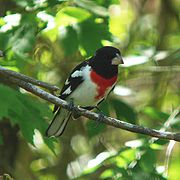
The cardinals are a family of passerine birds that are robust, seed-eating birds, with strong bills. They are typically associated with open woodland. The sexes usually have distinct plumages. There are 43 species worldwide and 14 species which occur in Panama.
- Streaked SaltatorStreaked SaltatorThe Streaked Saltator is a species of cardinal in the Cardinalidae family. It is found in Colombia, Costa Rica, Ecuador, Guadeloupe, Panama, Peru, and Venezuela.-References:...
Saltator striatipectus - Grayish SaltatorGrayish SaltatorThe Greyish Saltator, Saltator coerulescens, is a seed-eating songbird that is widespread in the tropical Americas. Traditionally placed in the cardinal family , the saltators actually seem to be closer to the tanagers...
Saltator coerulescens - Buff-throated SaltatorBuff-throated SaltatorThe Buff-throated Saltator, Saltator maximus, is a seedeating bird. Traditionally placed in the cardinal family , it actually seems to be closer to the tanagers . It breeds from southeastern Mexico to western Ecuador and northeastern Brazil.This is the type species of Saltator...
Saltator maximus - Black-headed SaltatorBlack-headed SaltatorThe Black-headed Saltator, Saltator atriceps, is a seedeating bird. Traditionally placed in the cardinal family , it actually seems to be closer to the tanagers . It breeds from central Mexico to eastern Panama....
Saltator atriceps - Slate-colored Grosbeak Saltator grossus
- Black-faced GrosbeakBlack-faced GrosbeakThe Black-faced Grosbeak, Caryothraustes poliogaster, is a large seed-eating bird in the cardinal family, which is a resident breeding species from southeastern Mexico to eastern Panama....
Caryothraustes poliogaster - Yellow-green GrosbeakYellow-green GrosbeakThe Yellow-Green Grosbeak is a species of cardinal in the Cardinalidae family.It is found in Brazil, Colombia, French Guiana, Guyana, Panama, Suriname, and Venezuela....
Caryothraustes canadensis - Black-thighed GrosbeakBlack-thighed GrosbeakThe Black-thighed Grosbeak, Pheucticus tibialis, is a large seed-eating bird in the cardinal family, which is endemic to the mountains of Costa Rica and western Panama....
Pheucticus tibialis - Rose-breasted GrosbeakRose-breasted GrosbeakThe Rose-breasted Grosbeak, Pheucticus ludovicianus, is a large seed-eating songbird in the cardinal family . It breeds in cool-temperate North America, migrating to tropical America in winter.-Description:...
Pheucticus ludovicianus - Blue-black GrosbeakBlue-black GrosbeakThe Blue-black Grosbeak is a species of songbird in the Cardinalidae family.It is found in Belize, Bolivia, Brazil, Colombia, Costa Rica, Ecuador, French Guiana, Guatemala, Guyana, Honduras, Mexico, Nicaragua, Panama, Peru, Suriname, and Venezuela...
Cyanocompsa cyanoides - Blue GrosbeakBlue GrosbeakBlue Grosbeak , is a medium-sized seed-eating bird in the same family as the Northern Cardinal, "tropical" or New World buntings, and "cardinal-grosbeaks" or New World grosbeaks....
Passerina caerulea - Indigo BuntingIndigo BuntingThe Indigo Bunting, Passerina cyanea, is a small seed-eating bird in the family Cardinalidae. It is migratory, ranging from southern Canada to northern Florida during the breeding season, and from southern Florida to northern South America during the winter. It often migrates by night, using the...
Passerina cyanea - Painted BuntingPainted BuntingThe Painted Bunting is a species of bird in the Cardinal family, Cardinalidae, that is native to North America.-Taxonomy:...
Passerina ciris - DickcisselDickcisselThe Dickcissel is a small American seed-eating bird in the family Cardinalidae. It is the only member of the genus Spiza, though some sources list another supposedly extinct species...
Spiza americana
Troupials and allies
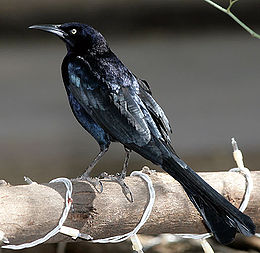
The icterids are a group of small to medium, often colourful, passerine birds restricted to the New World and include the grackle
Grackle
Grackle can refer to any of eleven black passerine birds native to North and South America. All are members of the Icterid family but belong to multiple genera.* Genus Quiscalus** Boat-tailed Grackle, Quiscalus major...
s, New World blackbird
New World blackbird
The New World blackbirds consist of 26 species of icterid birds that share the name blackbird but do not correspond with a formal taxon...
s, and New World oriole
New World oriole
New World orioles, comprising the genus Icterus, are a group of birds in the blackbird family. They are not related to Old World orioles which are in the family Oriolidae, but are strikingly similar in size, diet, behaviour and in their strongly contrasting plumage, and are a good example of...
s. Most species have black as the predominant plumage colour, often enlivened by yellow, orange or red. There are 98 species worldwide and 21 species which occur in Panama.
- BobolinkBobolinkThe Bobolink is a small New World blackbird and the only member of genus Dolichonyx.-Description:Adults are 16–18 cm long with short finch-like bills. They weigh about . Adult males are mostly black, although they do display creamy napes, and white scapulars, lower backs and rumps...
Dolichonyx oryzivorus - Red-breasted BlackbirdRed-breasted BlackbirdThe Red-breasted Blackbird, Sturnella militaris, is a passerine bird in the New World family Icteridae. Despite its name and colouration, it is in the same genus as the meadowlarks, and is less closely related to the Red-winged Blackbird group...
Sturnella militaris - Eastern MeadowlarkEastern MeadowlarkThe Eastern Meadowlark, Sturnella magna, is a medium-sized icterid bird, very similar in appearance to the Western Meadowlark. It occurs from eastern North America to South America, where it is also most widespread in the east.-Description:...
Sturnella magna - Yellow-headed BlackbirdYellow-headed BlackbirdThe Yellow-headed Blackbird is a medium-sized blackbird, and the only member of the genus Xanthocephalus....
Xanthocephalus xanthocephalus (A) - Great-tailed GrackleGreat-tailed GrackleThe Great-tailed Grackle is a medium-sized, gregarious passerine bird native to North and South America. A member of the Icteridae family, it is of the ten extant species of grackle and is closely related to the Red-bellied Grackle and the Velvet-fronted Grackle...
Quiscalus mexicanus - Shiny CowbirdShiny CowbirdThe Shiny Cowbird, Molothrus bonariensis, is a passerine bird in the New World family Icteridae. It breeds in most of South America apart from the most dense jungles, mountains and deserts , the coldest southernmost regions , and on Trinidad and Tobago...
Molothrus bonariensis - Bronzed CowbirdBronzed CowbirdThe Bronzed Cowbird , Molothrus aeneus, is a small icterid.It breeds from the southern U.S. states of California, Arizona, New Mexico, Texas, and Louisiana south through Central America to Panama. An isolated population on the Caribbean coast of Colombia is sometimes treated as a separate species,...
Molothrus aeneus - Giant CowbirdGiant CowbirdThe Giant Cowbird, Molothrus oryzivorus, is a large passerine bird in the New World family Icteridae. It breeds from southern Mexico south to northern Argentina, and on Trinidad and Tobago. It may have relatively recently colonised the latter island....
Molothrus oryzivorus - Yellow-backed OrioleYellow-backed OrioleThe Yellow-backed Oriole is a species of bird in the Icteridae family.-Physical description:Yellow-backed orioles are a yellow-bodied, sexually monomorphic species. Howell and Webb note that this species tends to average 21.5 cm in length from beak to tail; making Icterus chrysater a...
Icterus chrysater - Yellow-tailed OrioleYellow-tailed OrioleThe Yellow-tailed Oriole, Icterus mesomelas, is a passerine bird in the New World family Icteridae. It breeds from southern Mexico to western Peru and northwestern Venezuela; in Peru it also lives in a river valley corridor....
Icterus mesomelas - Orange-crowned OrioleOrange-crowned OrioleThe Orange-crowned Oriole is a species of bird in the Icteridae family. It is found in Colombia, Panama, and Venezuela....
Icterus auricapillus - Baltimore OrioleBaltimore OrioleThe Baltimore Oriole is a small icterid blackbird that averages 18 cm long and weighs 34 g. This bird received its name from the fact that the male's colors resemble those on the coat-of-arms of Lord Baltimore...
Icterus galbula - Orchard OrioleOrchard OrioleThe Orchard Oriole, Icterus spurius, is the smallest North American species of icterid blackbird. The subspecies of the Caribbean coast of Mexico, I. s. fuertesi, is sometimes considered a separate species, the Ochre Oriole....
Icterus spurius - Black-cowled OrioleBlack-cowled OrioleThe Black-cowled Oriole is a species of bird in the Icteridae family.It is found in Belize, Costa Rica, Guatemala, Mexico, Nicaragua, Panama, and possibly Honduras....
Icterus prosthemelas - Yellow-billed CaciqueYellow-billed CaciqueThe Yellow-billed Cacique is a species of bird in the Icteridae family. It is monotypic within the genus Amblycercus....
Amblycercus holosericeus - Yellow-rumped CaciqueYellow-rumped CaciqueThe Yellow-rumped Cacique, Cacicus cela, is a passerine bird in the New World family Icteridae. It breeds in much of northern South America from Panama and Trinidad south to Peru, Bolivia and central Brazil.-Description:...
Cacicus cela - Scarlet-rumped CaciqueScarlet-rumped CaciqueThe Scarlet-rumped Cacique is a passerine bird species in the New World family Icteridae. It breeds from eastern Honduras to Panama and in the Pacific lowlands of South America from western Colombia south to Ecuador, and in the lower reaches of the northern Andes...
Cacicus uropygialis - Crested OropendolaCrested OropendolaThe Crested Oropendola, Psarocolius decumanus, is a New World tropical icterid bird. It is a resident breeder in lowland South America east of the Andes, from Panama and Colombia south to northern Argentina, as well as on Trinidad and Tobago...
Psarocolius decumanus - Chestnut-headed OropendolaChestnut-headed OropendolaThe Chestnut-headed Oropendola is a New World tropical icterid bird. The scientific name of the species commemorates Johann Georg Wagler, who established Psarocolius, the oropendola genus.-Description:...
Psarocolius wagleri - Black OropendolaBlack OropendolaThe Black Oropendola is a species of bird in the Icteridae family. It is found in Colombia and Panama.Its natural habitat is subtropical or tropical moist lowland forests.-References:...
Psarocolius guatimozinus - Montezuma OropendolaMontezuma OropendolaThe Montezuma Oropendola, Psarocolius montezuma, is a New World tropical icterid bird. It is a resident breeder in the Caribbean coastal lowlands from southeastern Mexico to central Panama, but is absent from El Salvador and southern Guatemala. It also occurs on the Pacific slope of Nicaragua and...
Gymnostinops montezuma
Siskins and goldfinches

Finch
Finch
The true finches are passerine birds in the family Fringillidae. They are predominantly seed-eating songbirds. Most are native to the Northern Hemisphere, but one subfamily is endemic to the Neotropics, one to the Hawaiian Islands, and one subfamily – monotypic at genus level – is found...
es are seed-eating passerine birds, that are small to moderately large and have a strong beak, usually conical and in some species very large. All have 12 tail feathers and 9 primaries. These birds have a bouncing flight with alternating bouts of flapping and gliding on closed wings, and most sing well. There are 137 species worldwide and 3 species which occur in Panama.
- Yellow-bellied SiskinYellow-bellied SiskinThe Yellow-bellied Siskin, Carduelis xanthogastra, is a small passerine bird in the finch family Fringillidae. It breeds from Costa Rica south to southern Ecuador, central Bolivia and the highlands of northwestern Venezuela....
Carduelis xanthogastra - Lesser GoldfinchLesser GoldfinchThe Lesser Goldfinch or Dark-backed Goldfinch is a very small songbird of the Americas. Together with its relatives the American Goldfinch and Lawrence's Goldfinch, it forms the American goldfinches clade in the genus Carduelis sensu stricto.The American goldfinches can be distinguished by the...
Carduelis psaltria - American GoldfinchAmerican GoldfinchThe American Goldfinch , also known as the Eastern Goldfinch and Wild Canary, is a small North American bird in the finch family...
Carduelis tristis (A)
Old World sparrows
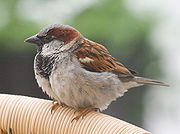
Sparrow
Sparrow
The sparrows are a family of small passerine birds, Passeridae. They are also known as true sparrows, or Old World sparrows, names also used for a genus of the family, Passer...
s are small passerine birds. In general, sparrows tend to be small, plump, brown or grey birds with short tails and short powerful beaks. Sparrows are seed-eaters, and they also consume small insects. There are 35 species worldwide and 1 species which occurs in Panama.
- House SparrowHouse SparrowThe House Sparrow is a bird of the sparrow family Passeridae, found in most parts of the world. One of about 25 species in the genus Passer, the House Sparrow occurs naturally in most of Europe, the Mediterranean region, and much of Asia...
Passer domesticus (I)
Waxbills and allies
Order: Passeriformes. Family: EstrildidaeThe estrildid finch
Estrildid finch
The estrildid finches are small passerine birds of the Old World tropics and Australasia. They can be classified as the family Estrildidae , or as a sub-group within the family Passeridae, which also includes the true sparrows....
es are small passerine birds of the Old World tropics and Australasia
Australasia
Australasia is a region of Oceania comprising Australia, New Zealand, the island of New Guinea, and neighbouring islands in the Pacific Ocean. The term was coined by Charles de Brosses in Histoire des navigations aux terres australes...
. They are gregarious and often colonial seed-eaters with short thick but pointed bills. They are all similar in structure and habits, but have a wide variation in plumage colours and pattern. There are 141 species worldwide and 2 species which occur in Panama.
- Nutmeg Mannikin Lonchura punctulata (I)
- Black-headed MuniaTricoloured MuniaThe Tricoloured Munia Lonchura malacca is a estrildid finch, native to India and Sri Lanka. The species was also introduced to Australia, Cuba, Hispaniola, Honduras, Jamaica, Japan, Portugal, Puerto Rico, Hawaii and Venezuela.-Taxonomic note:...
Lonchura malacca (I)
External links
- Birds of Panama Birdlist, multi-lingual website by country with standardized codes for abundance and seasonal presence.

